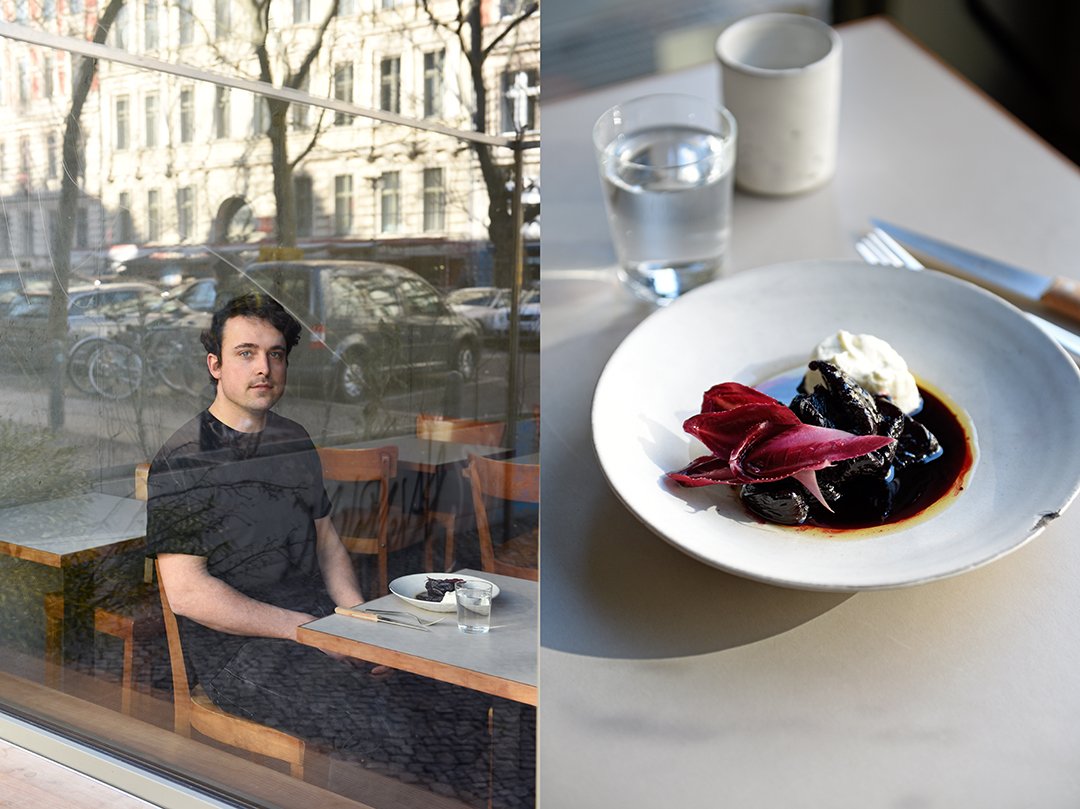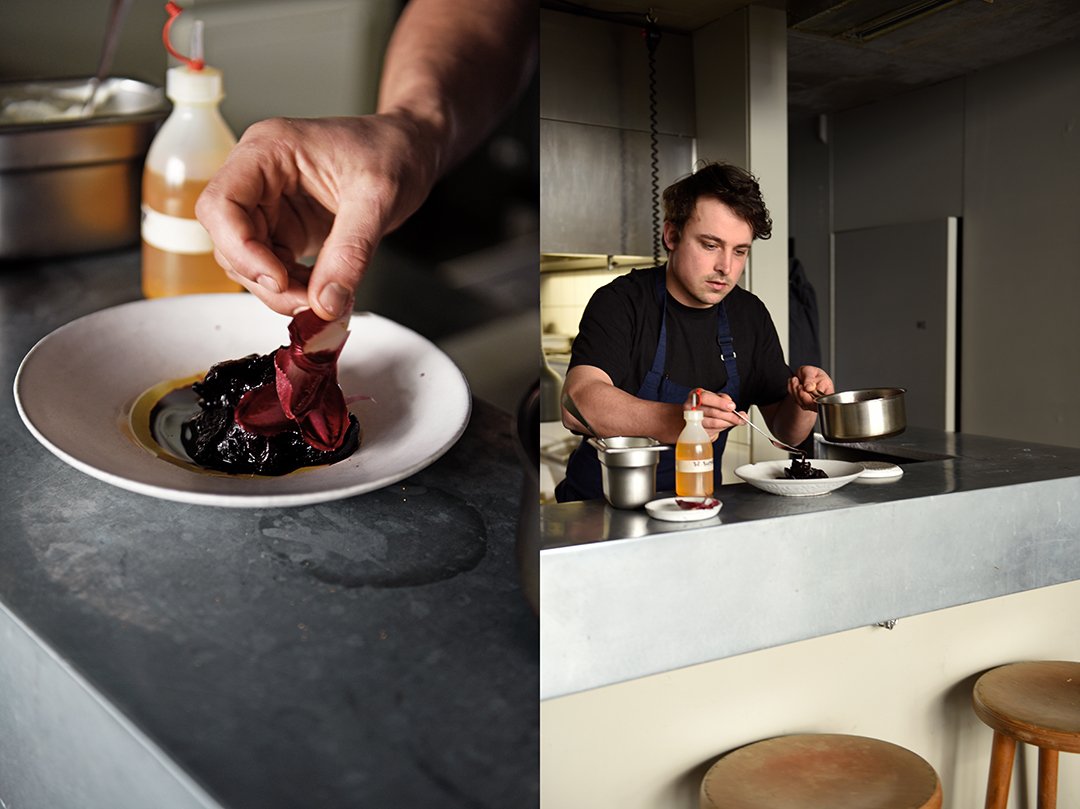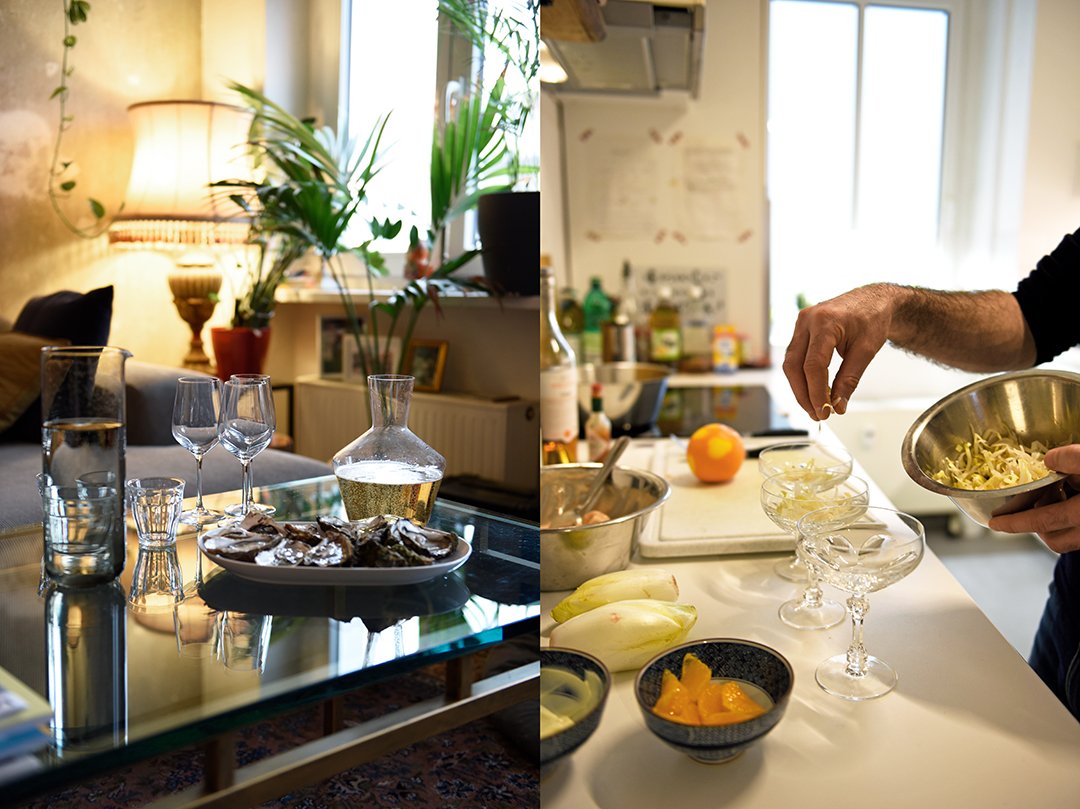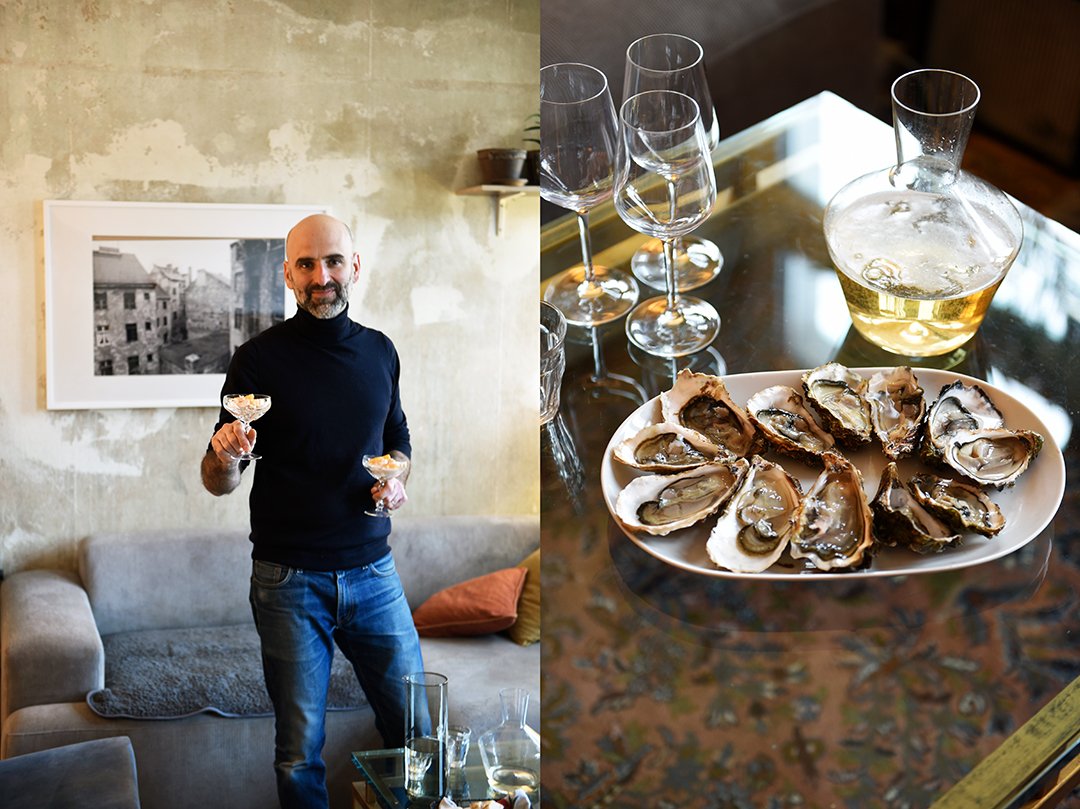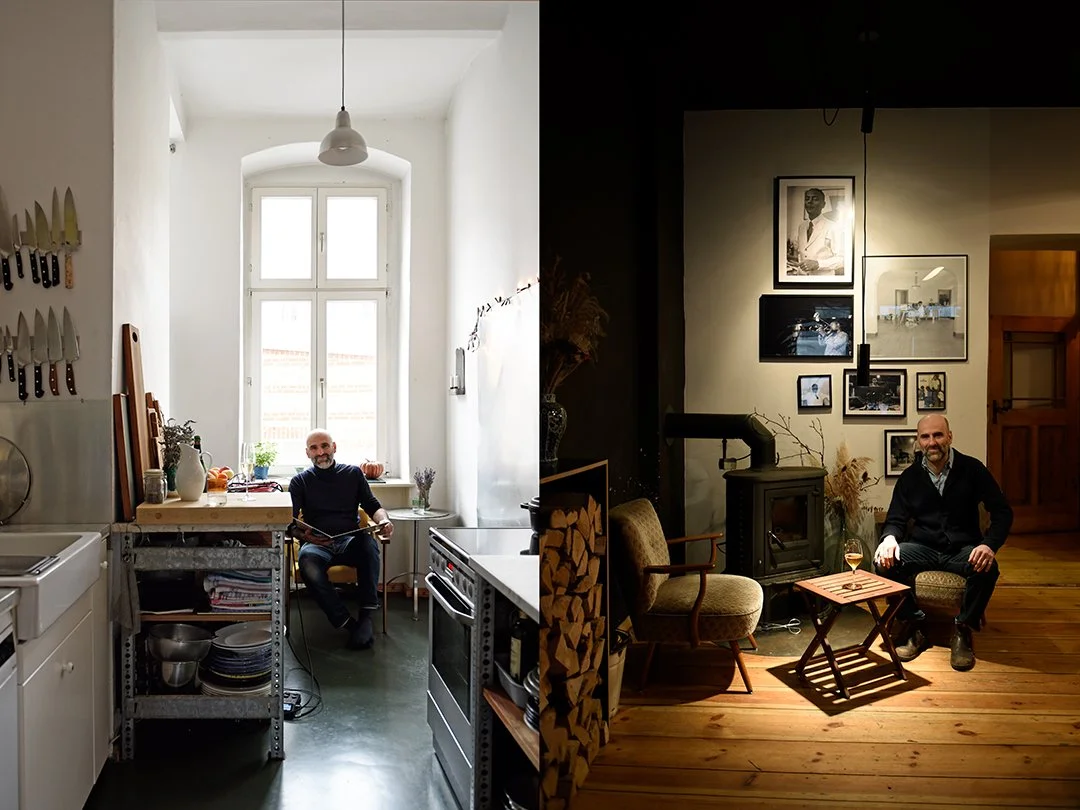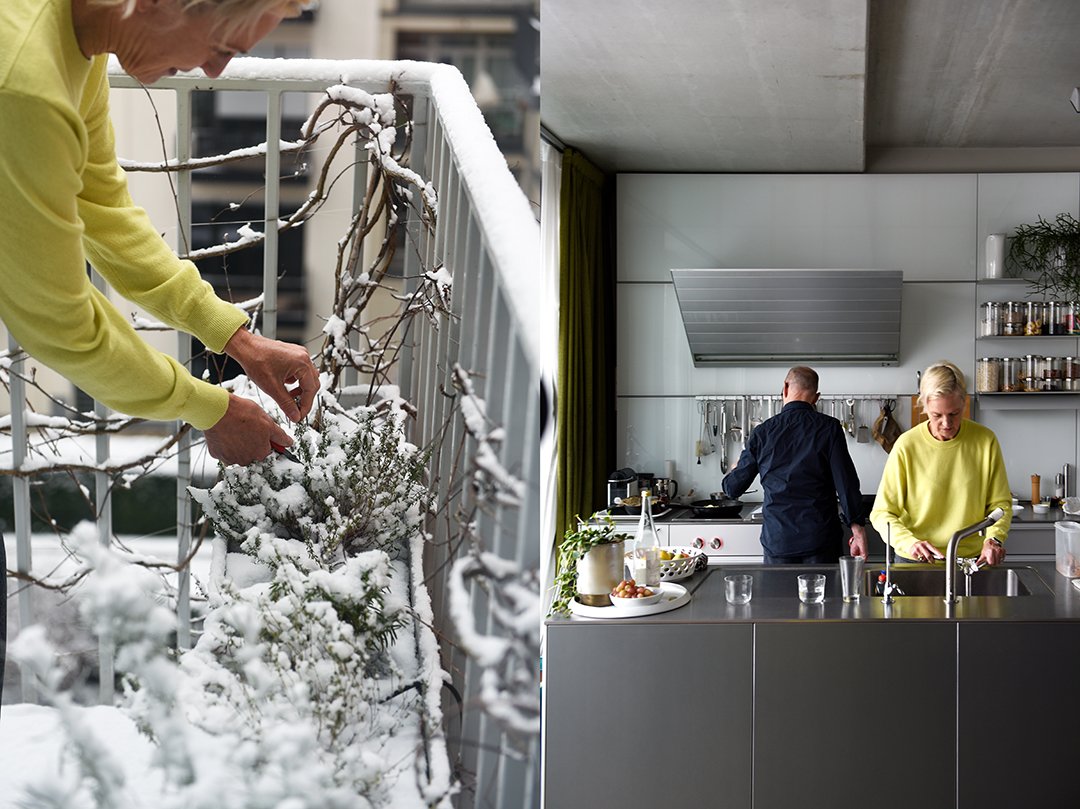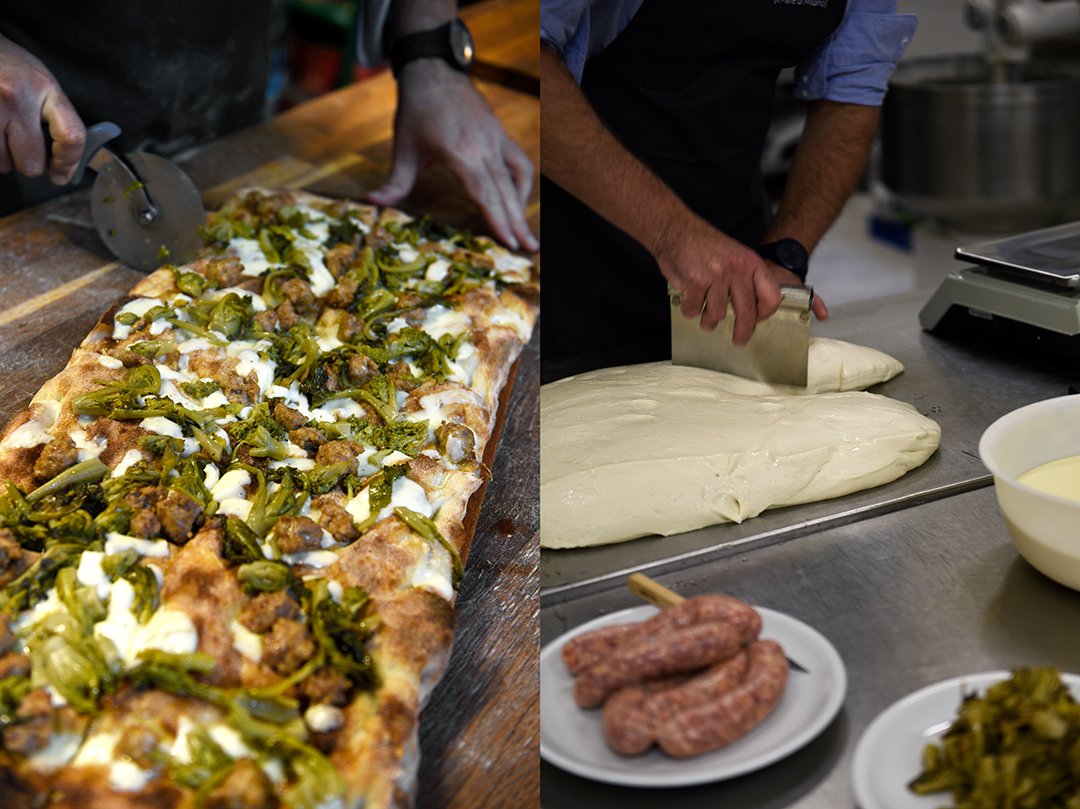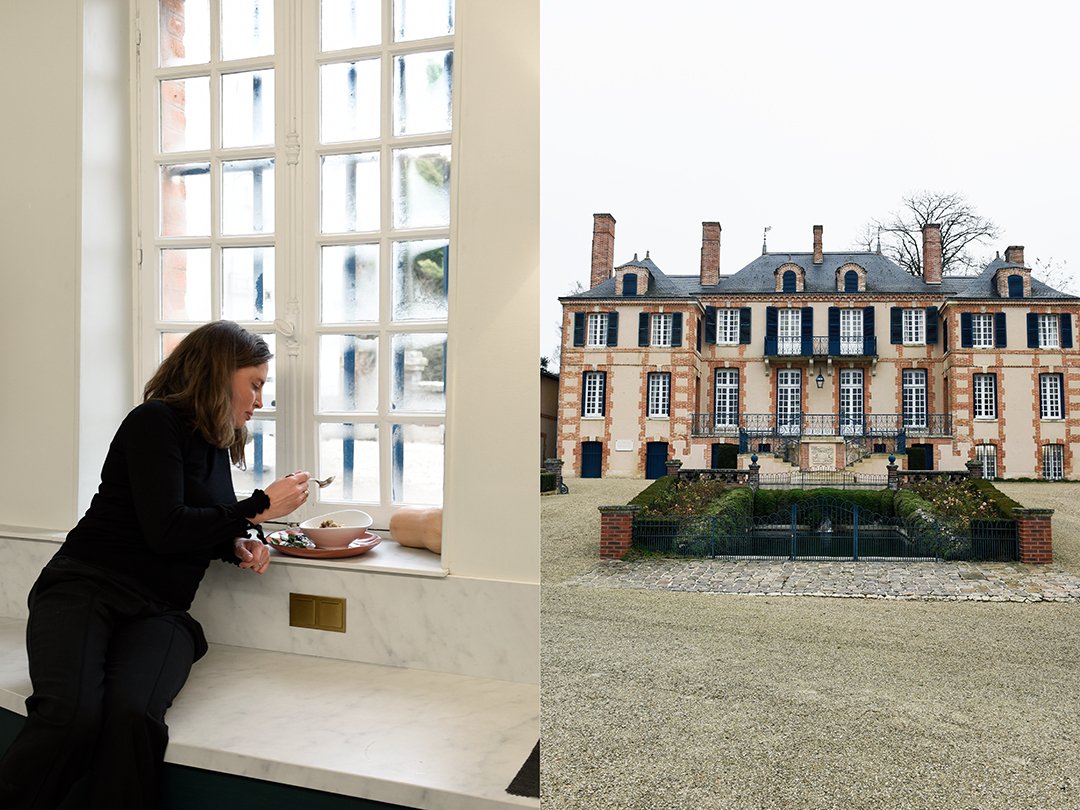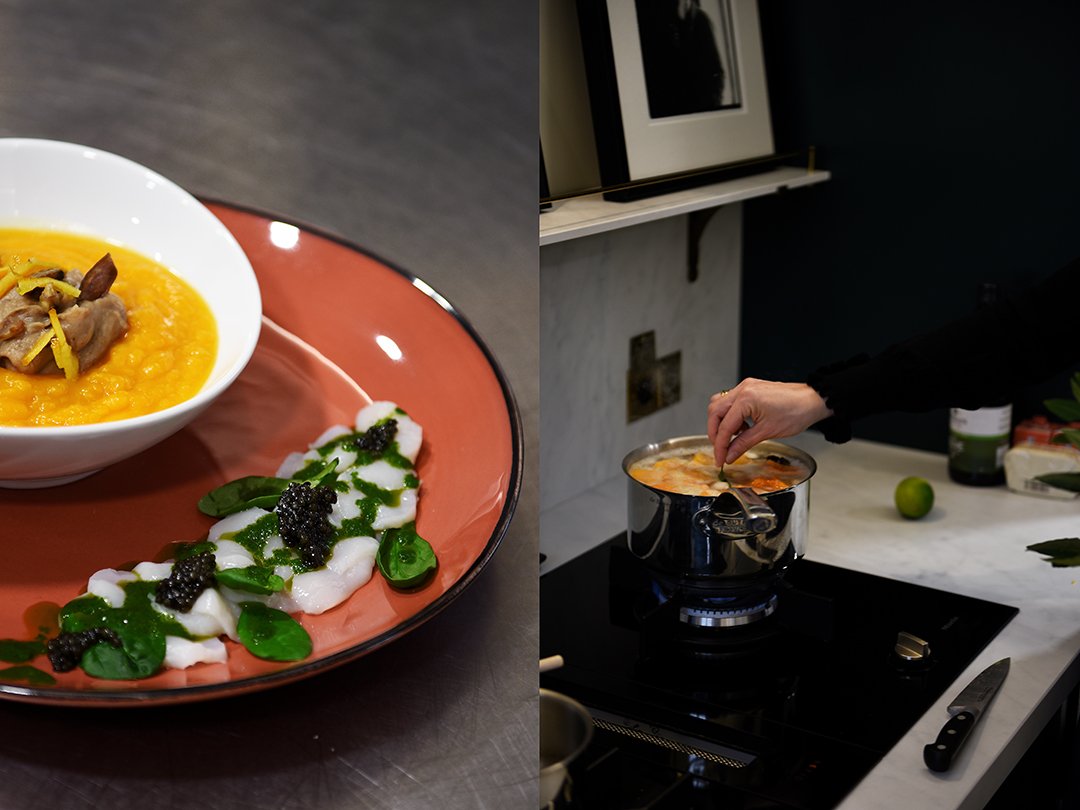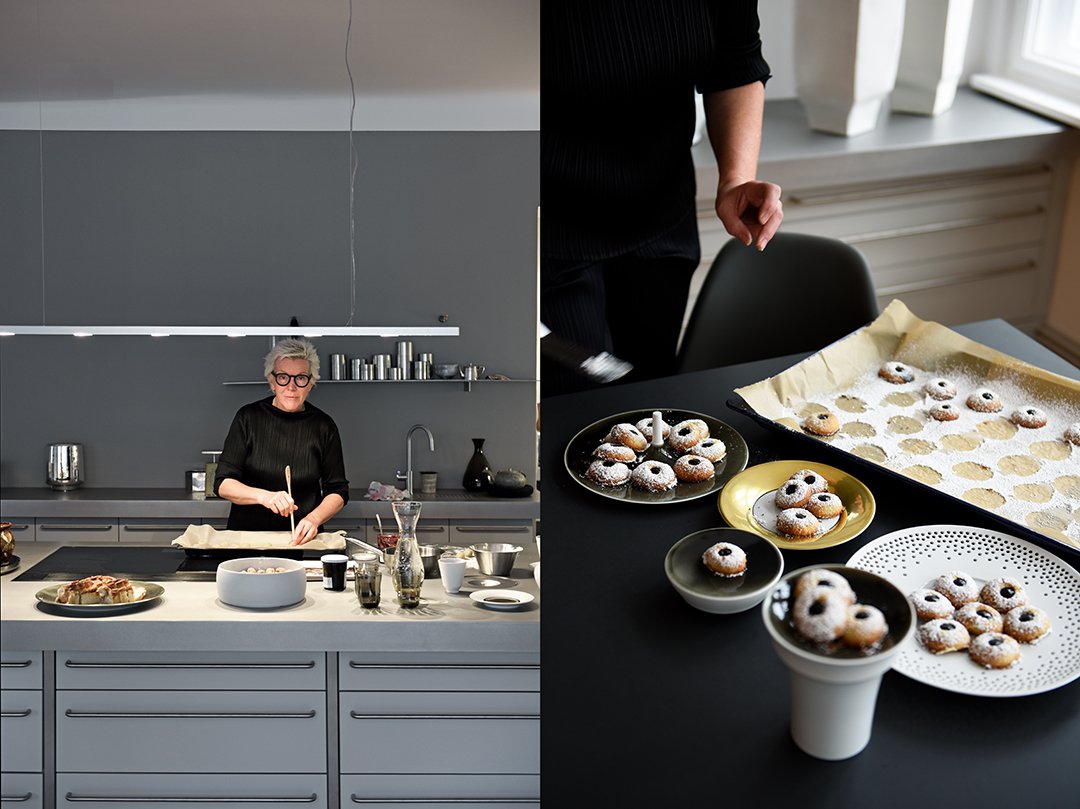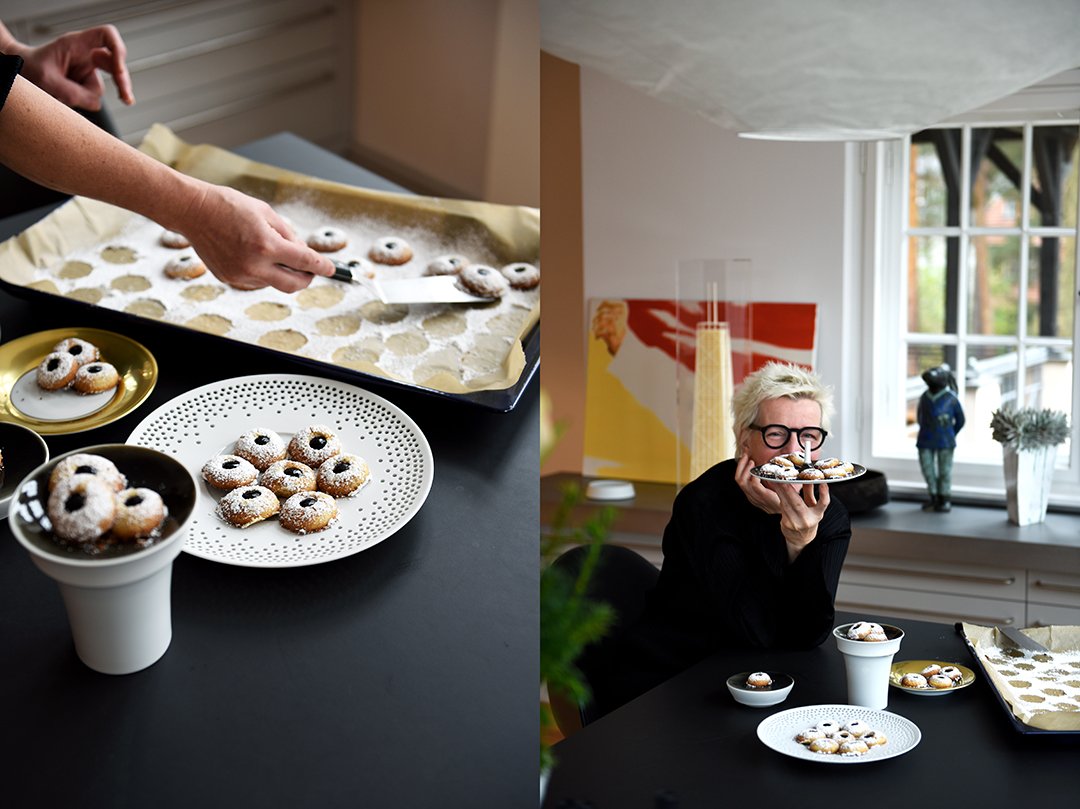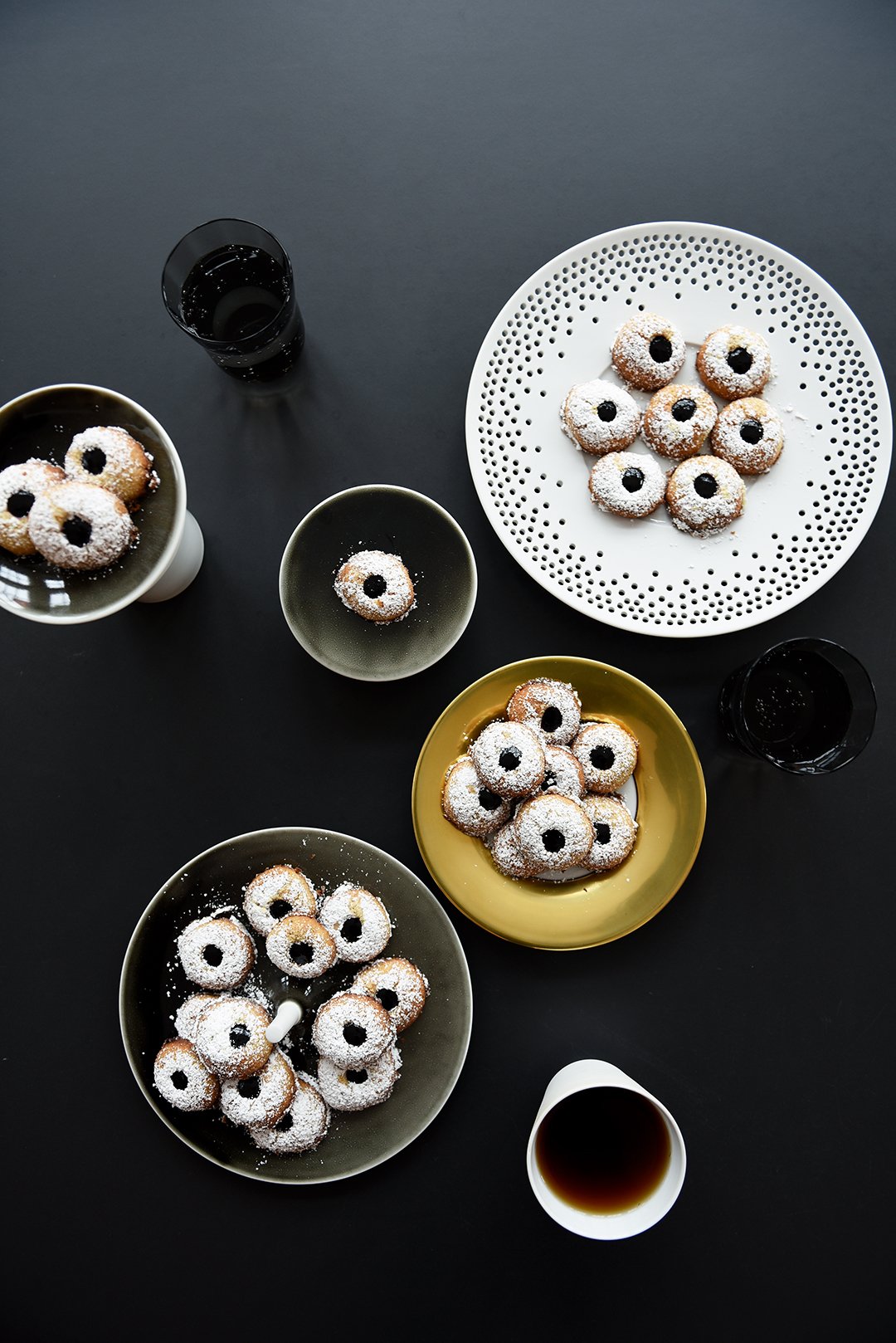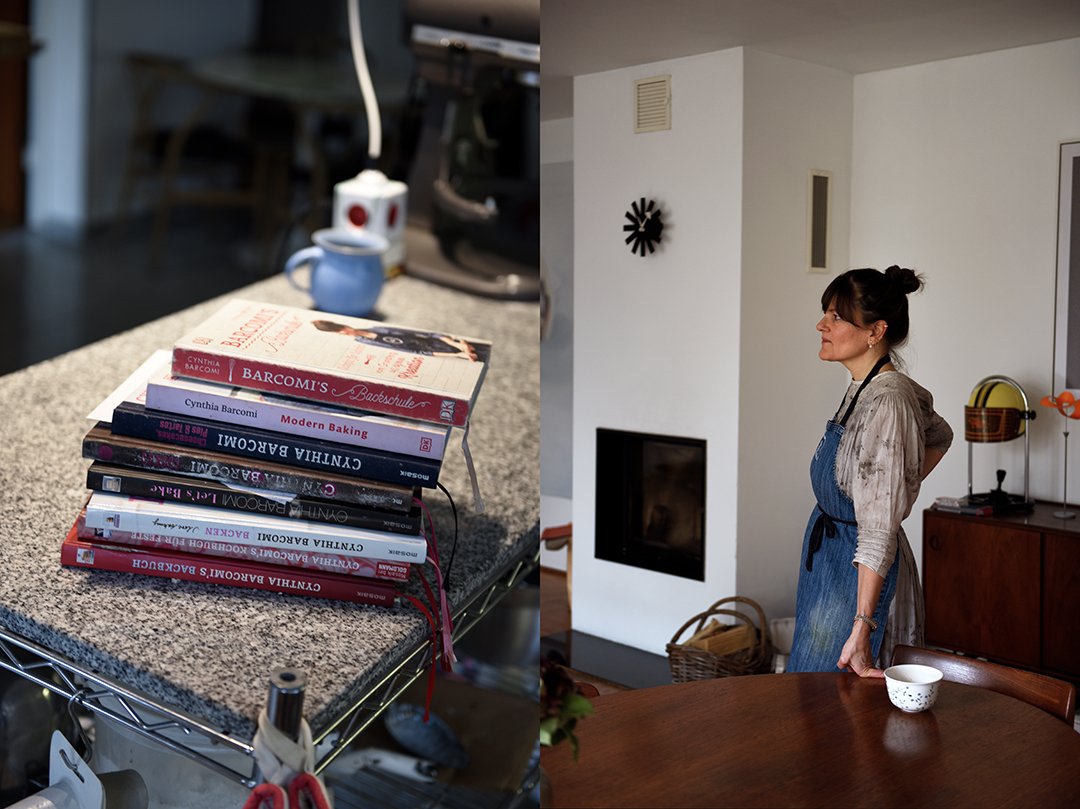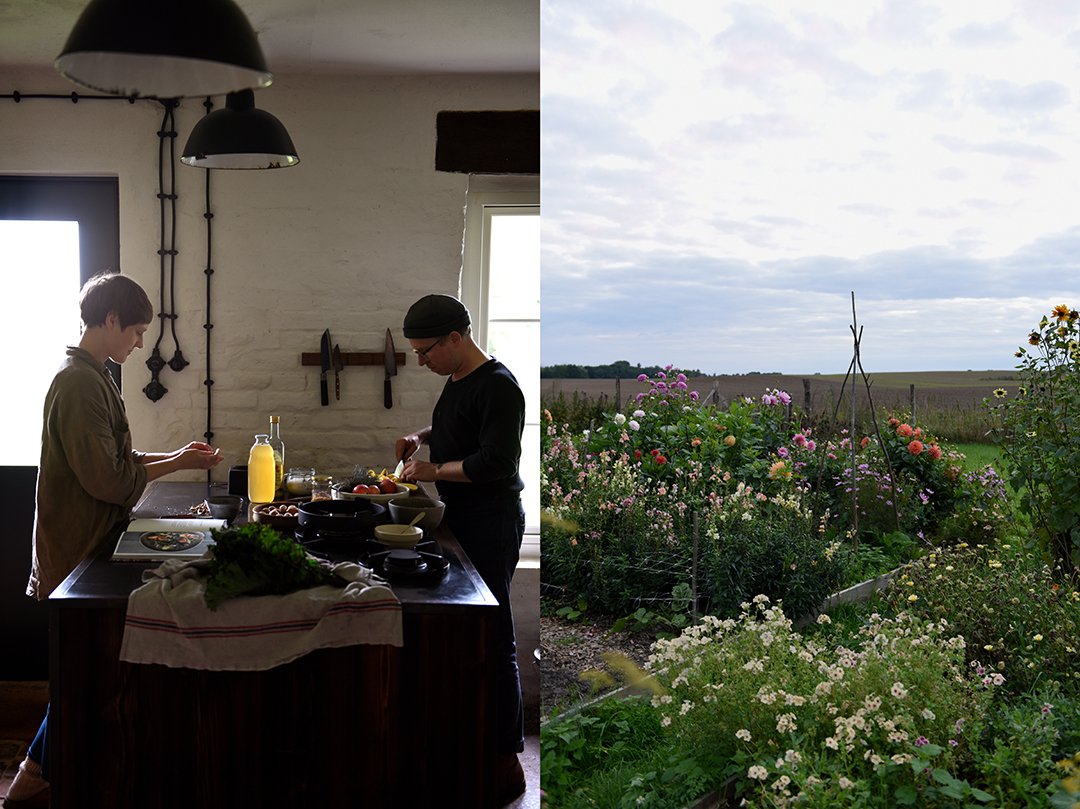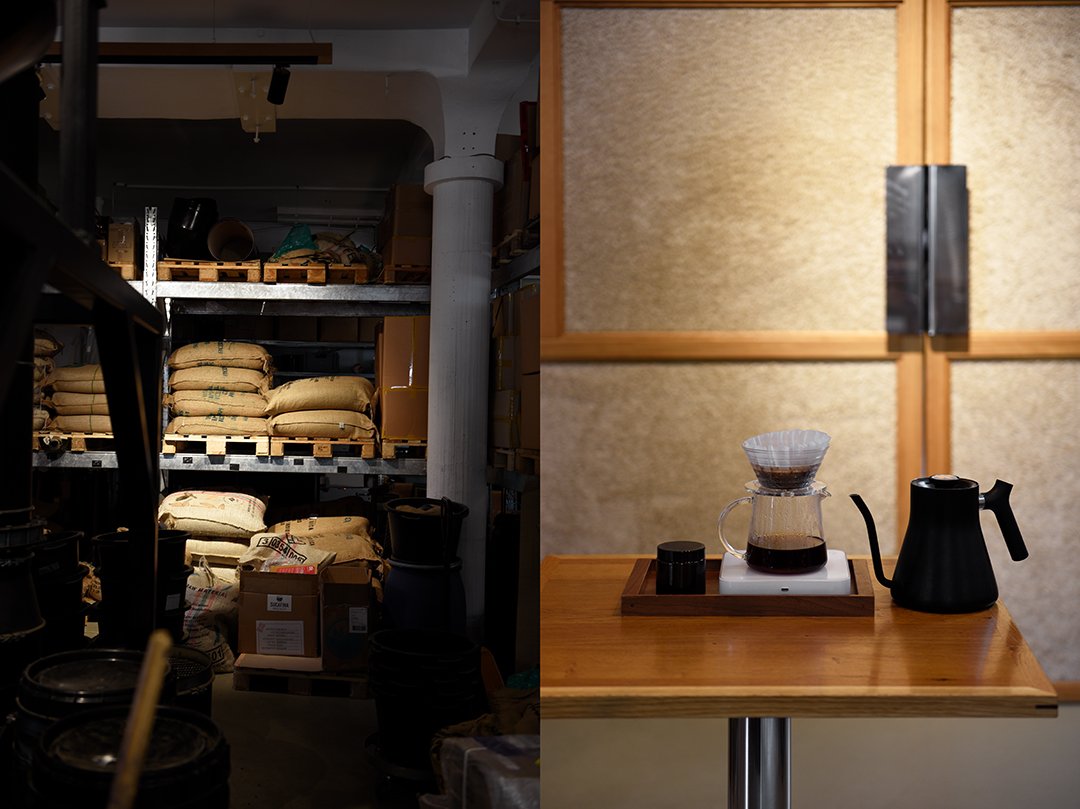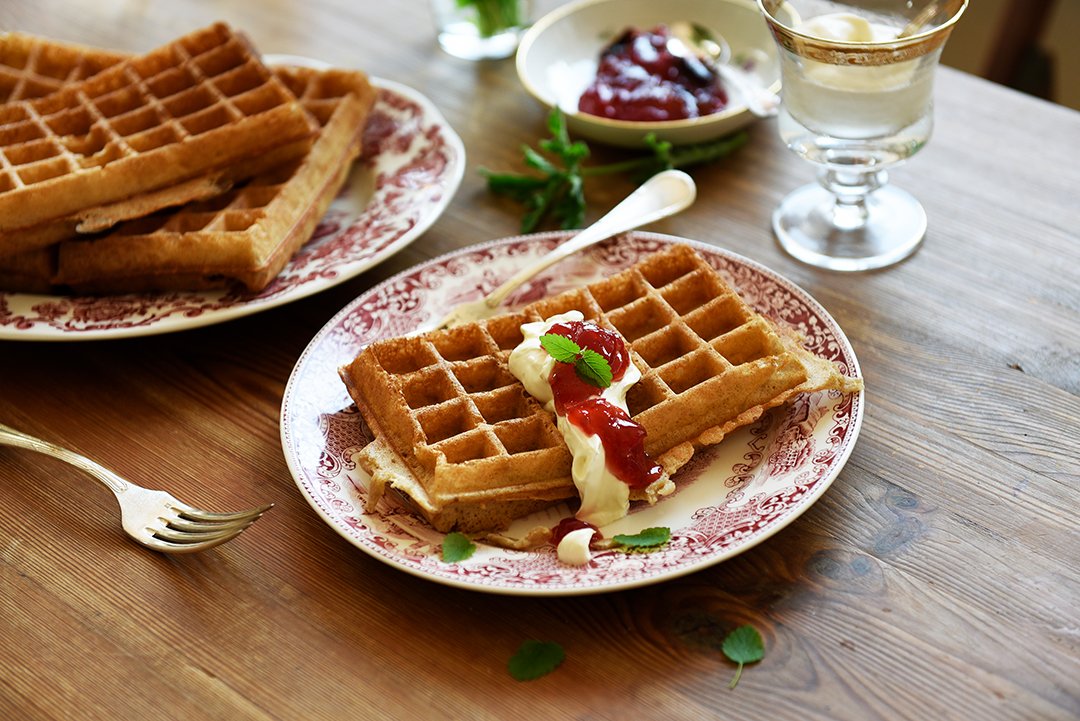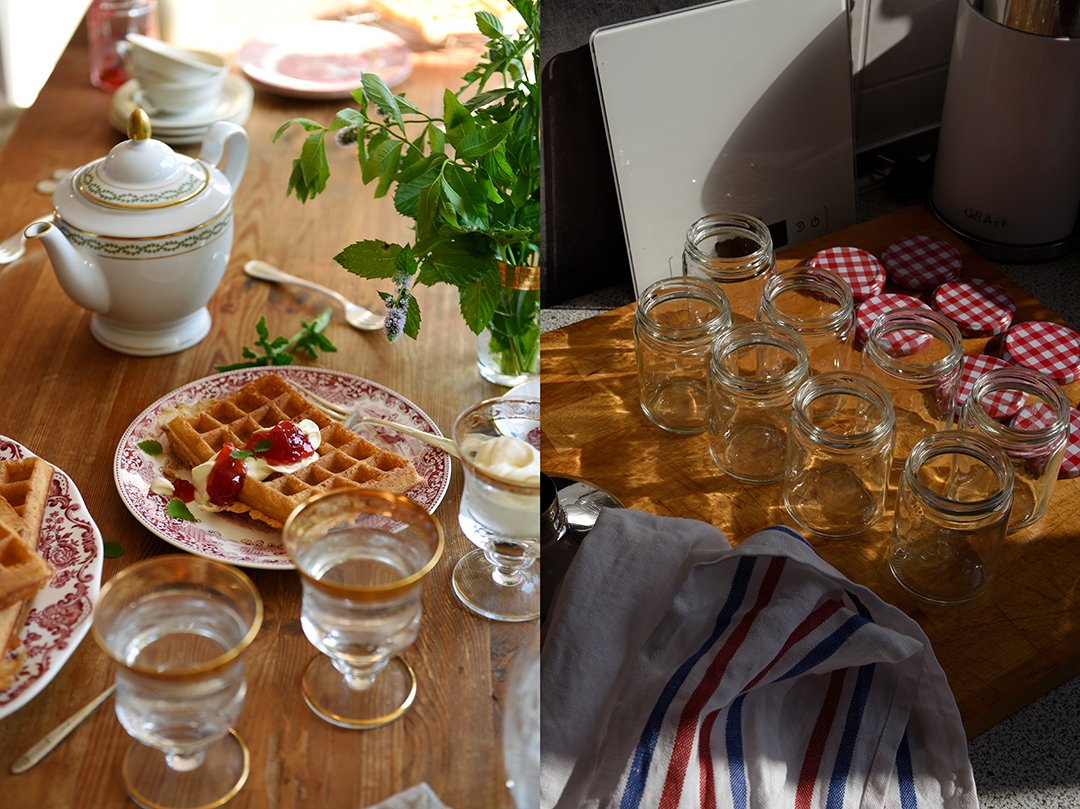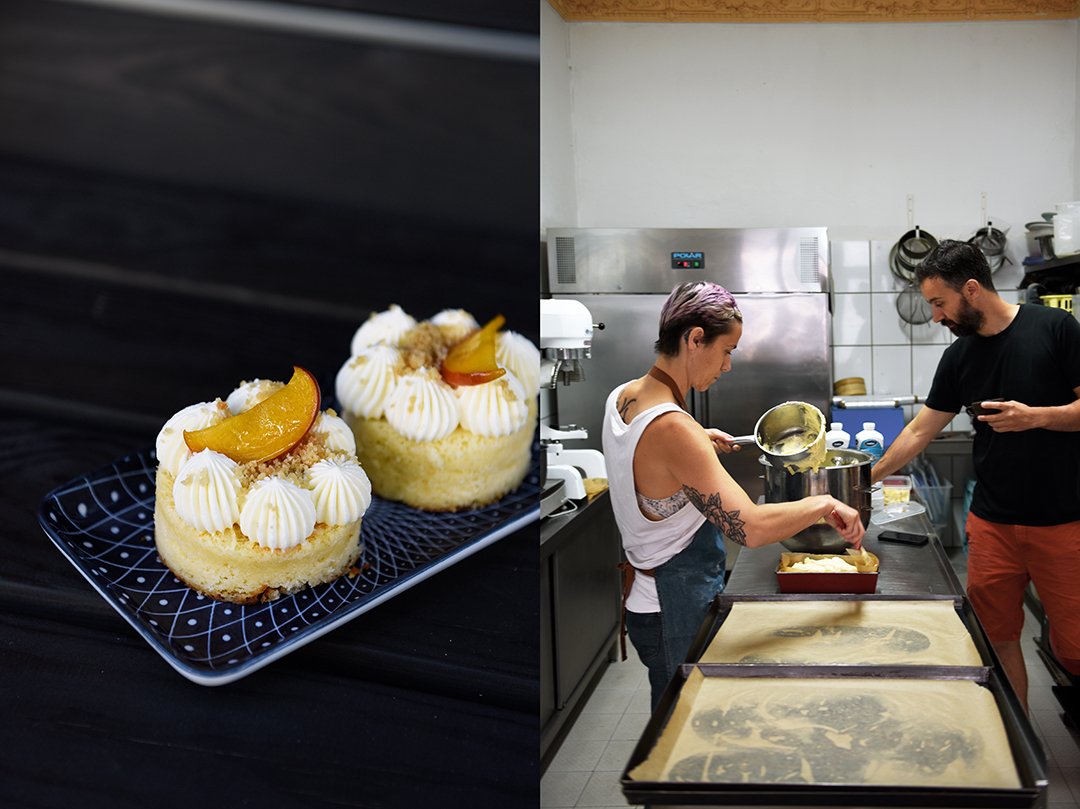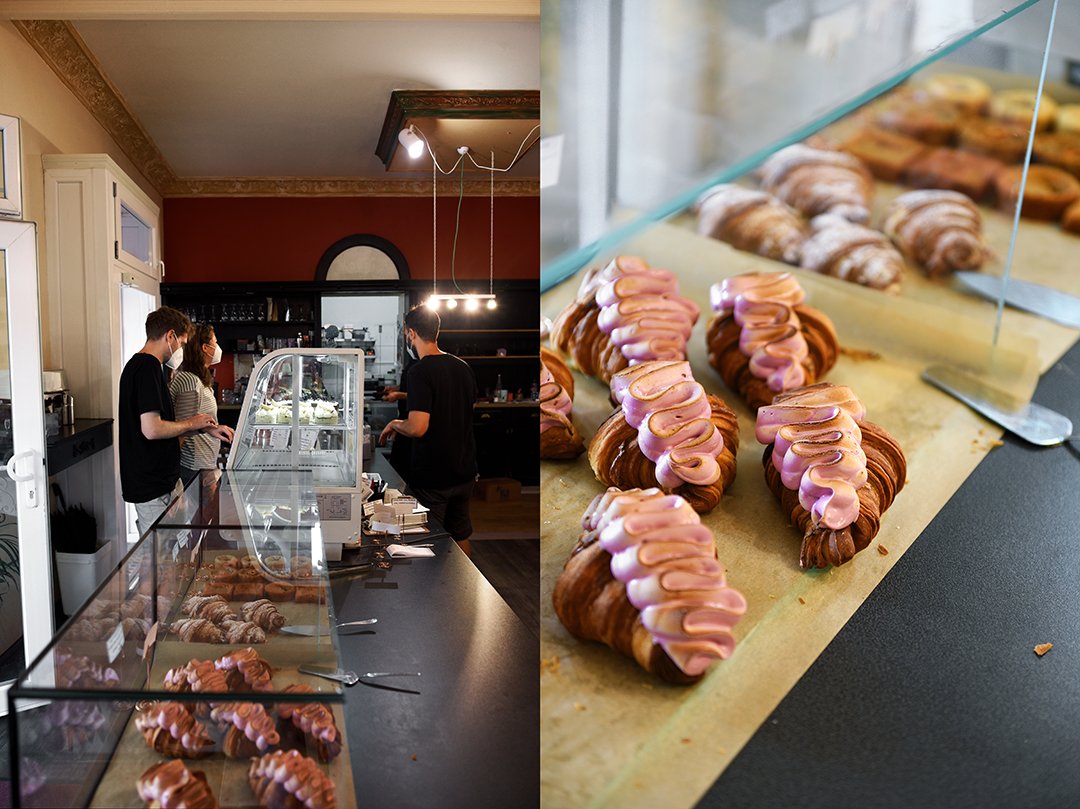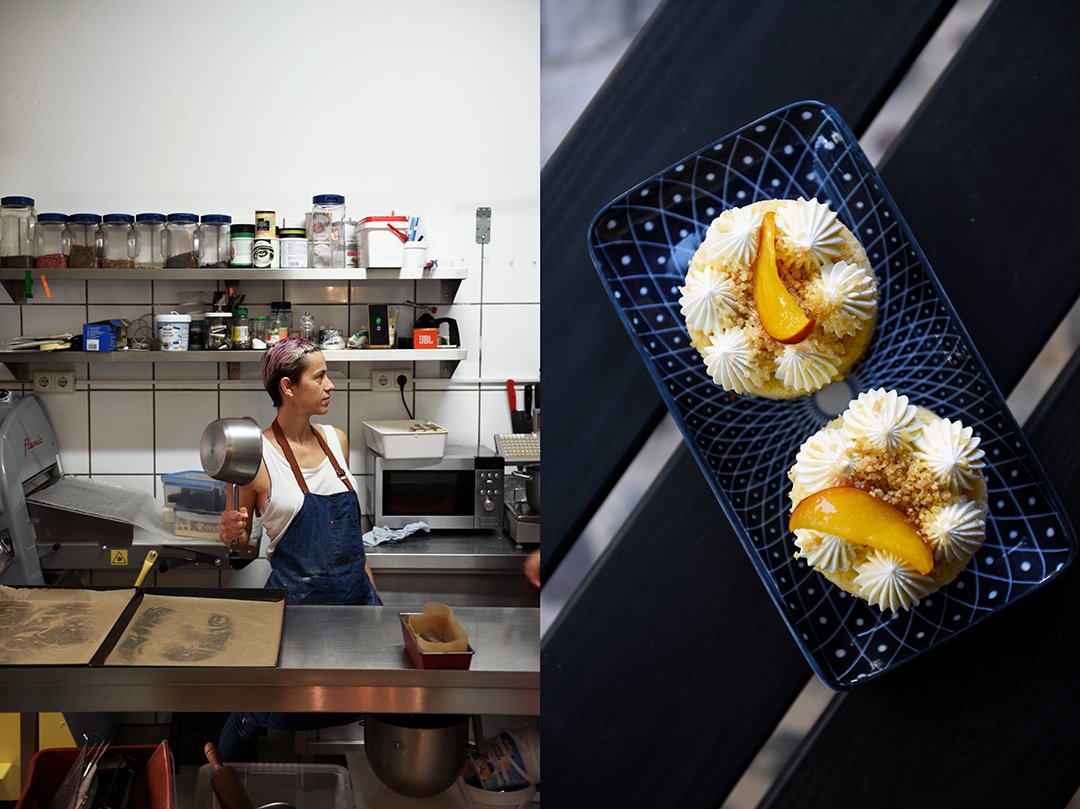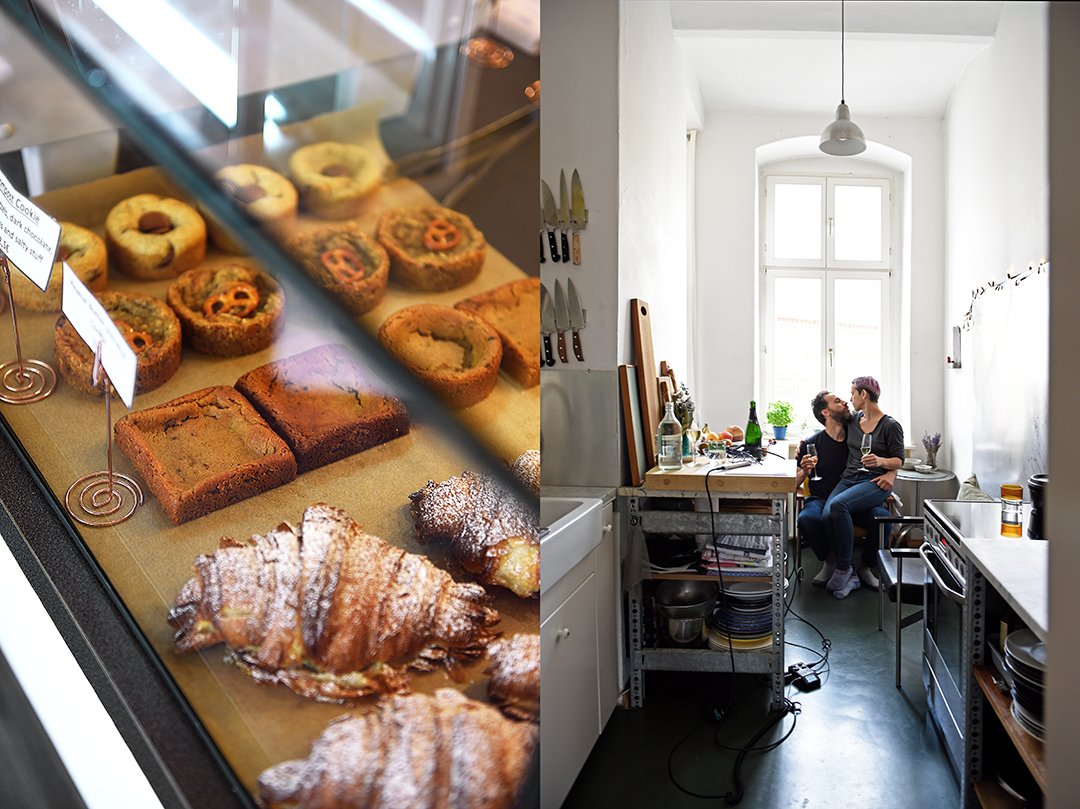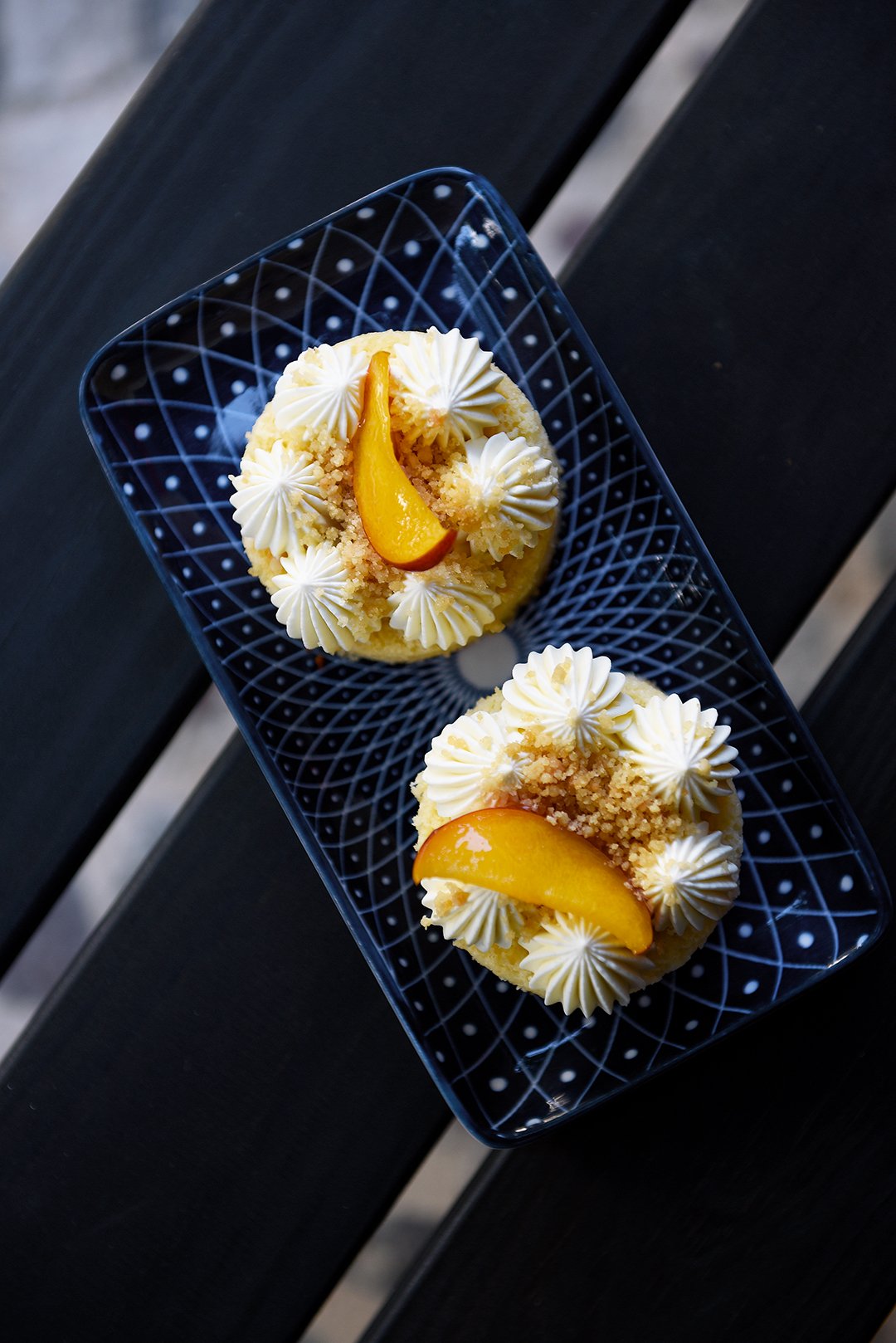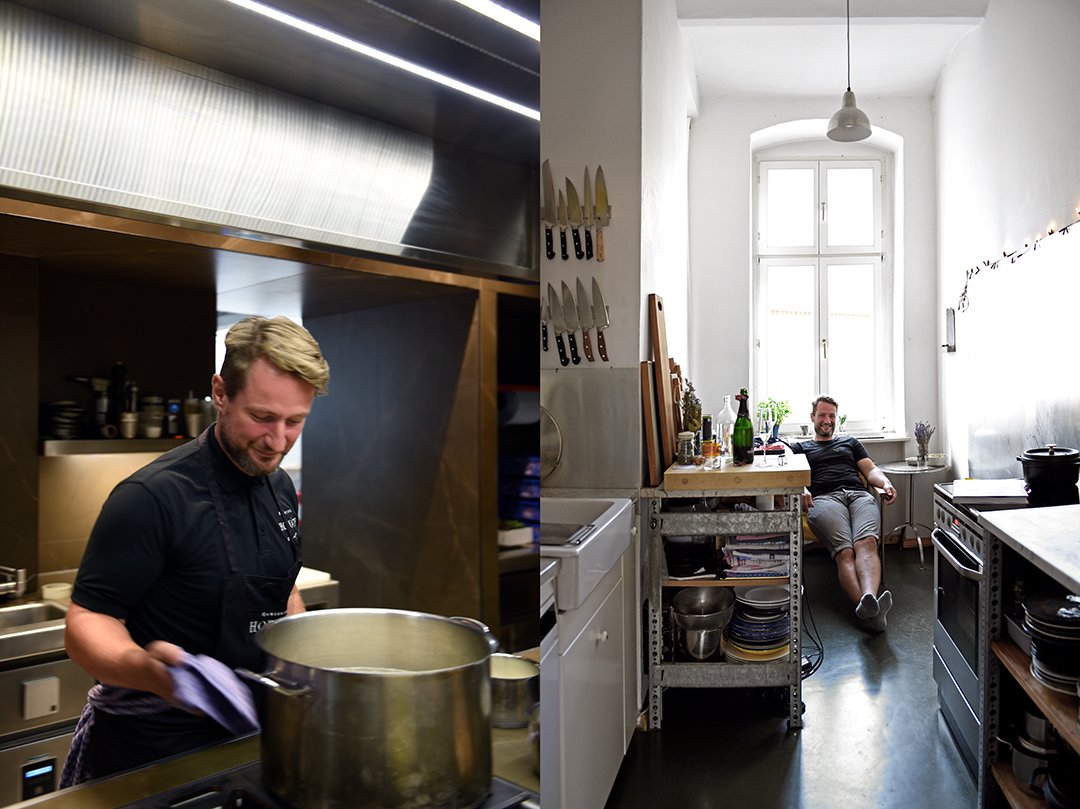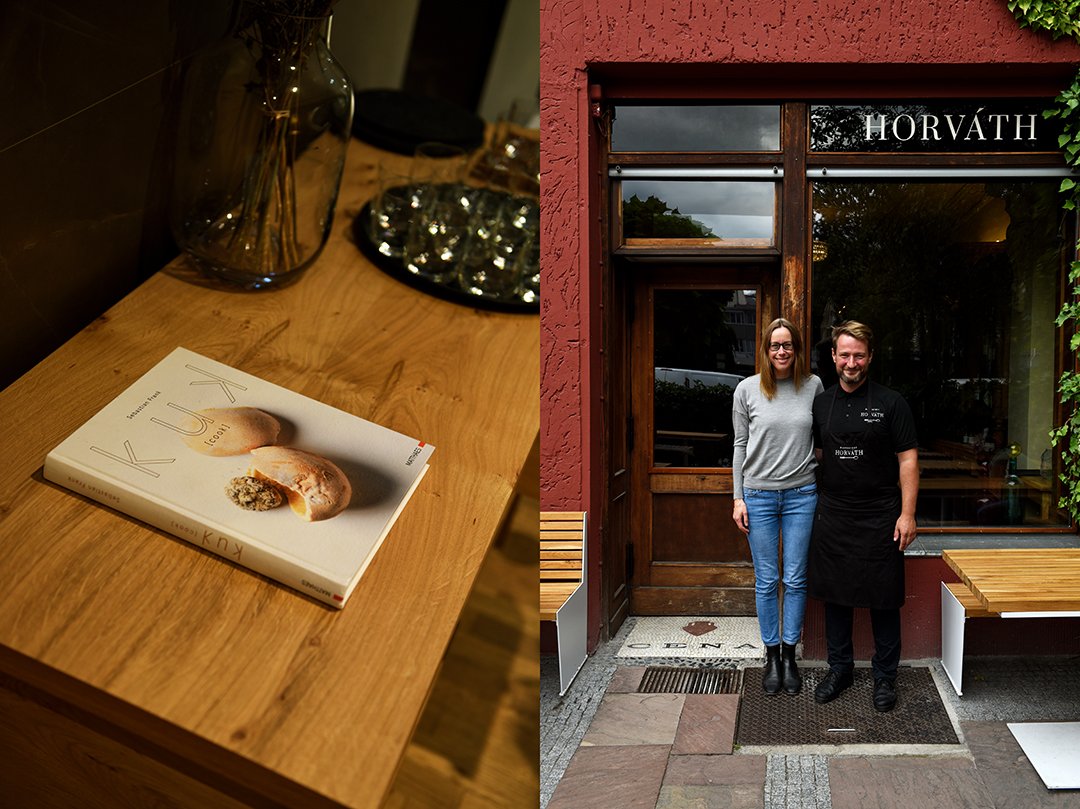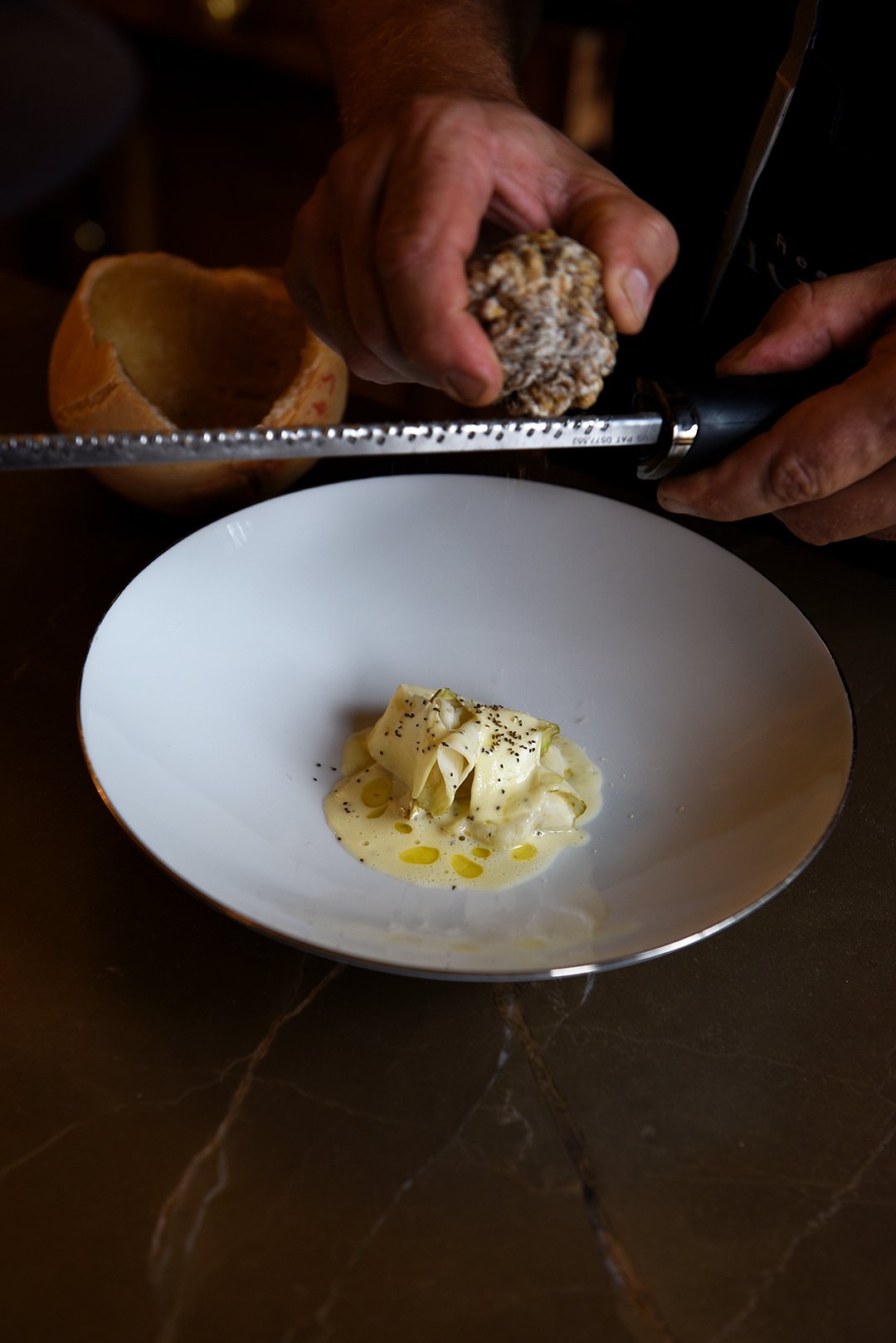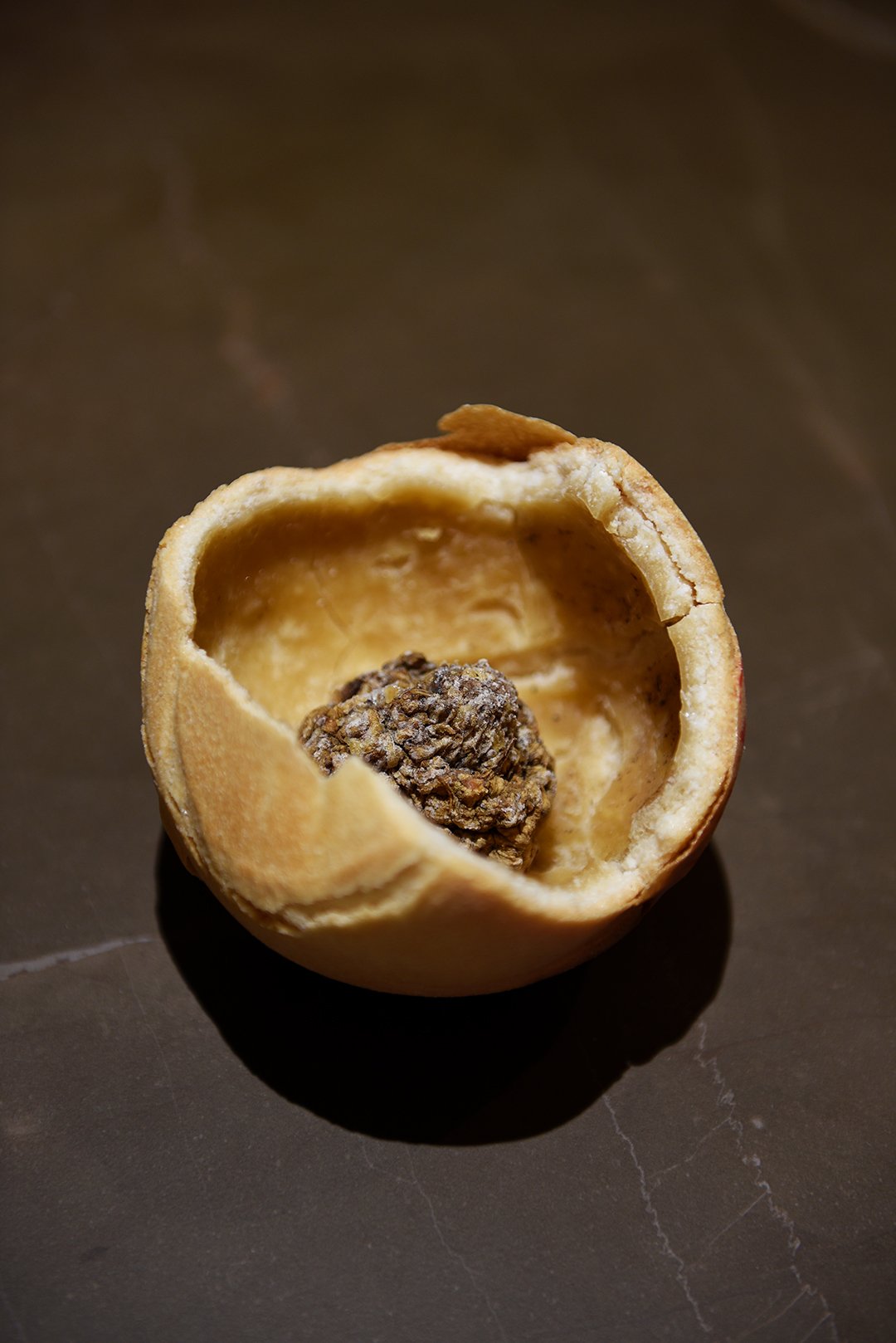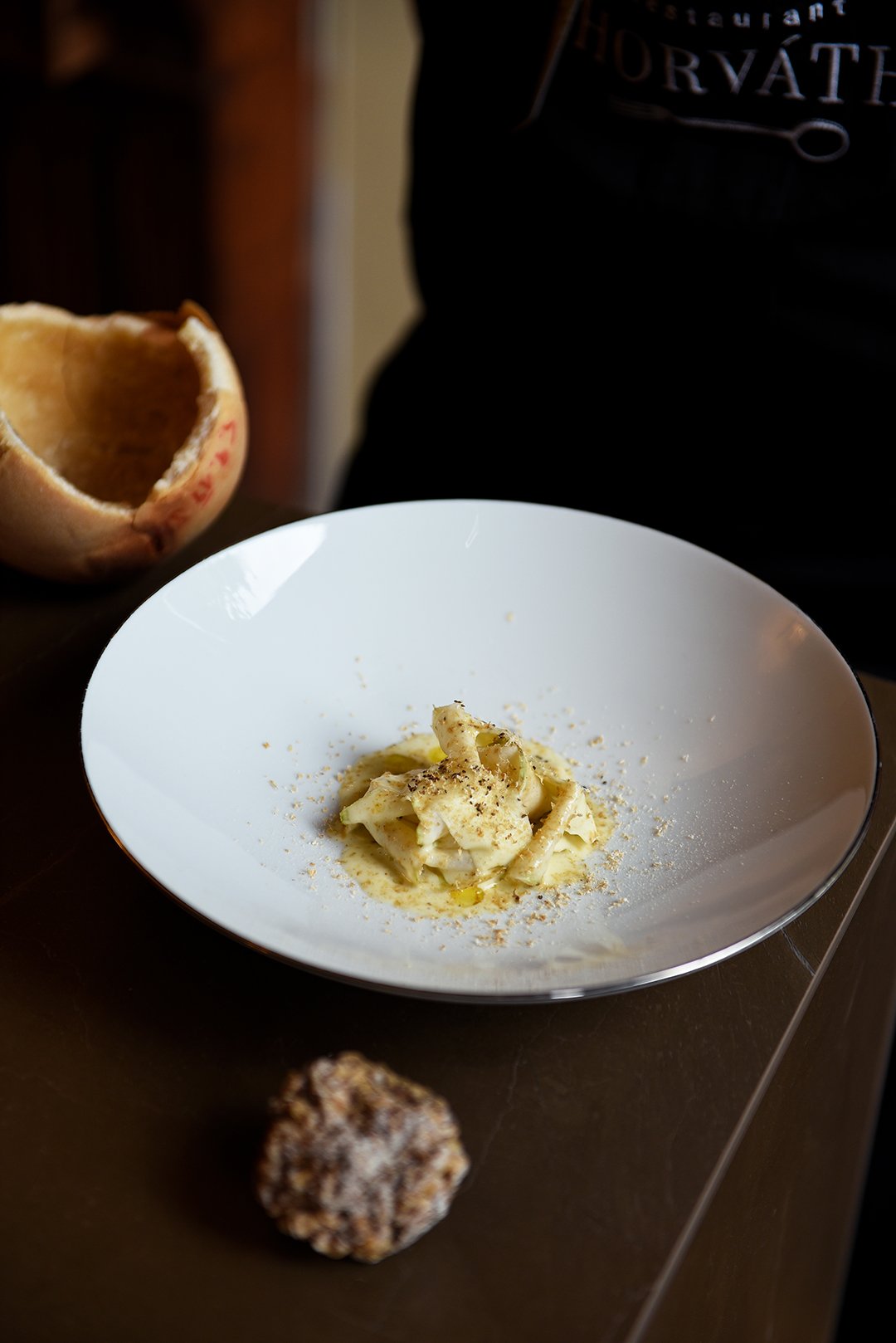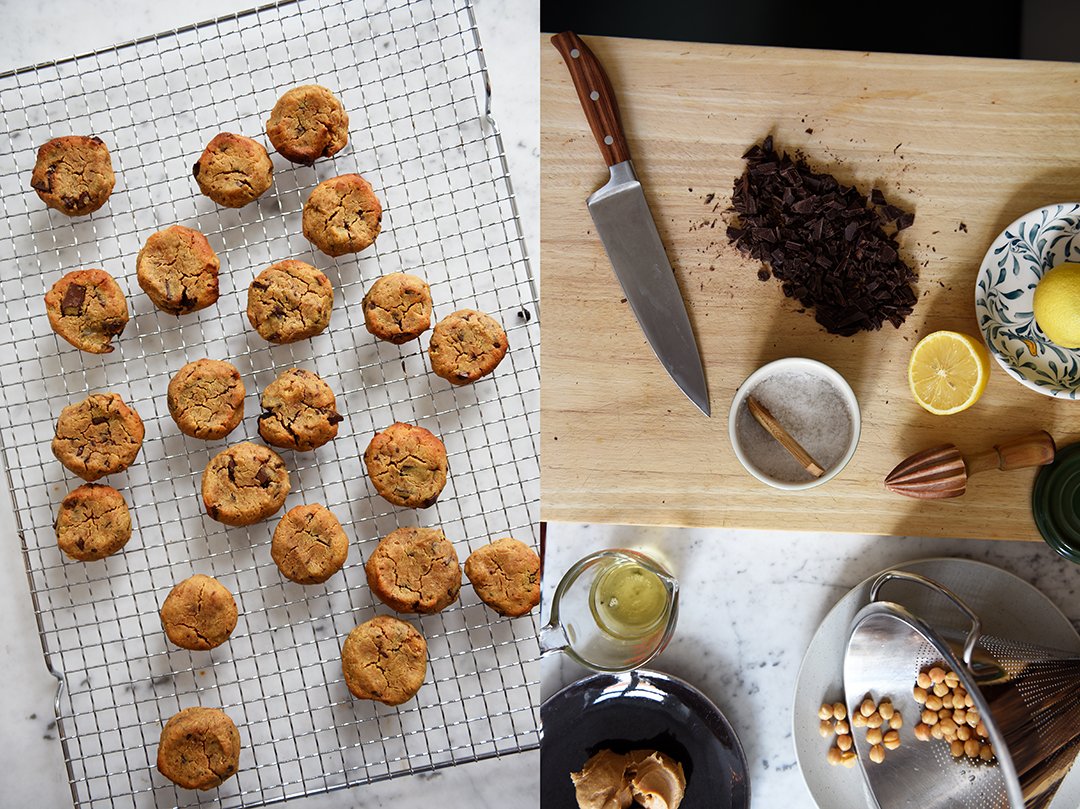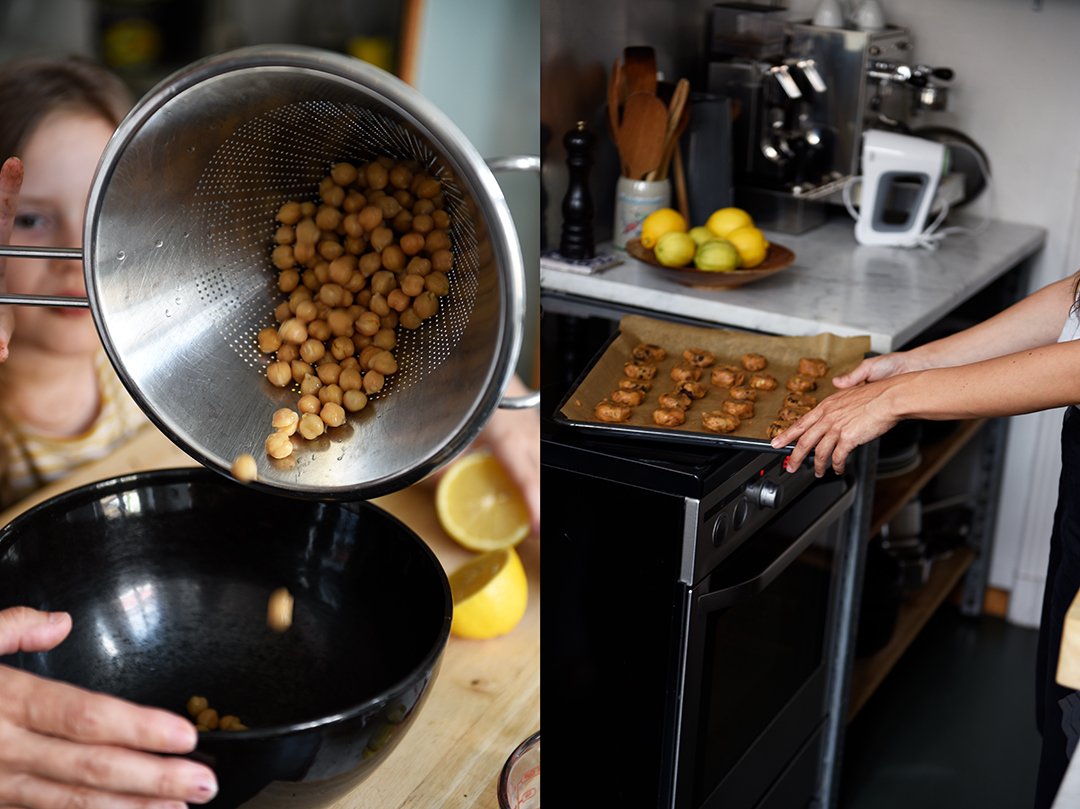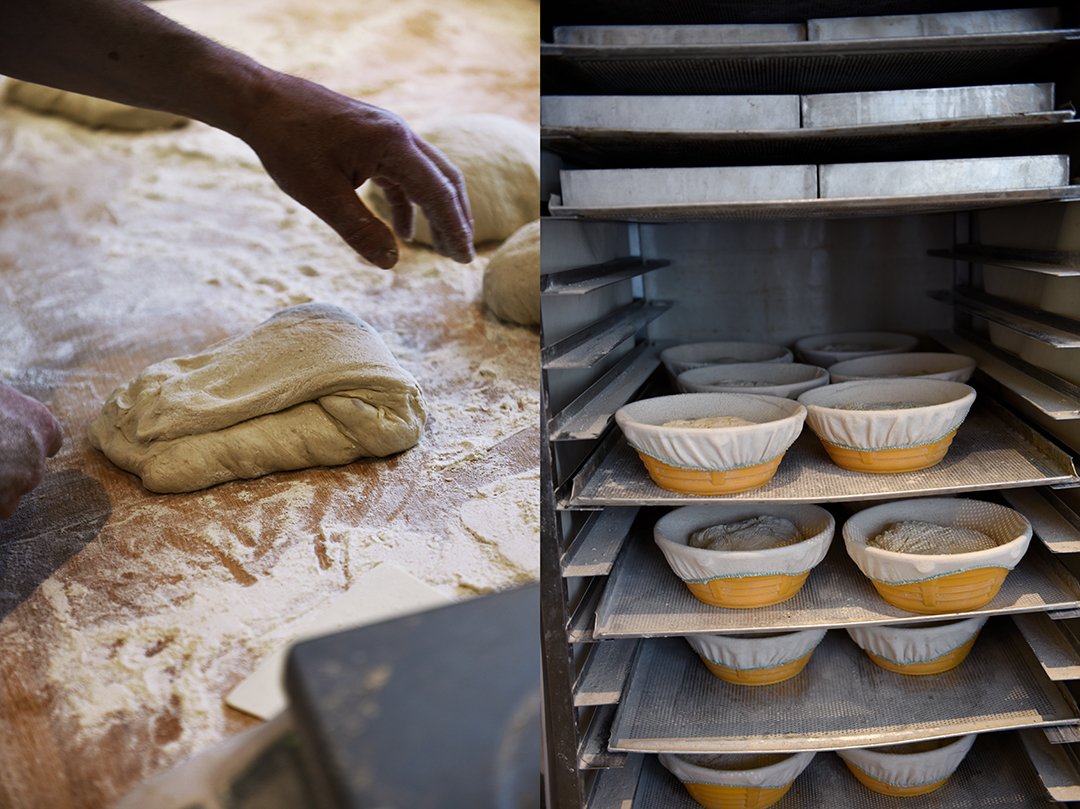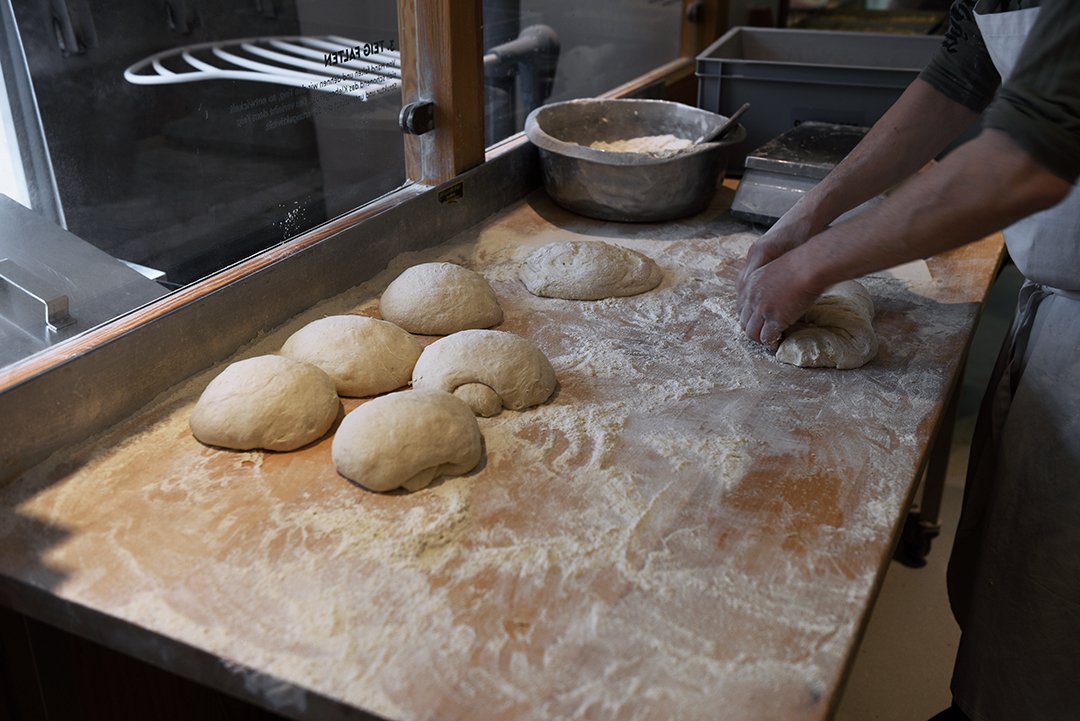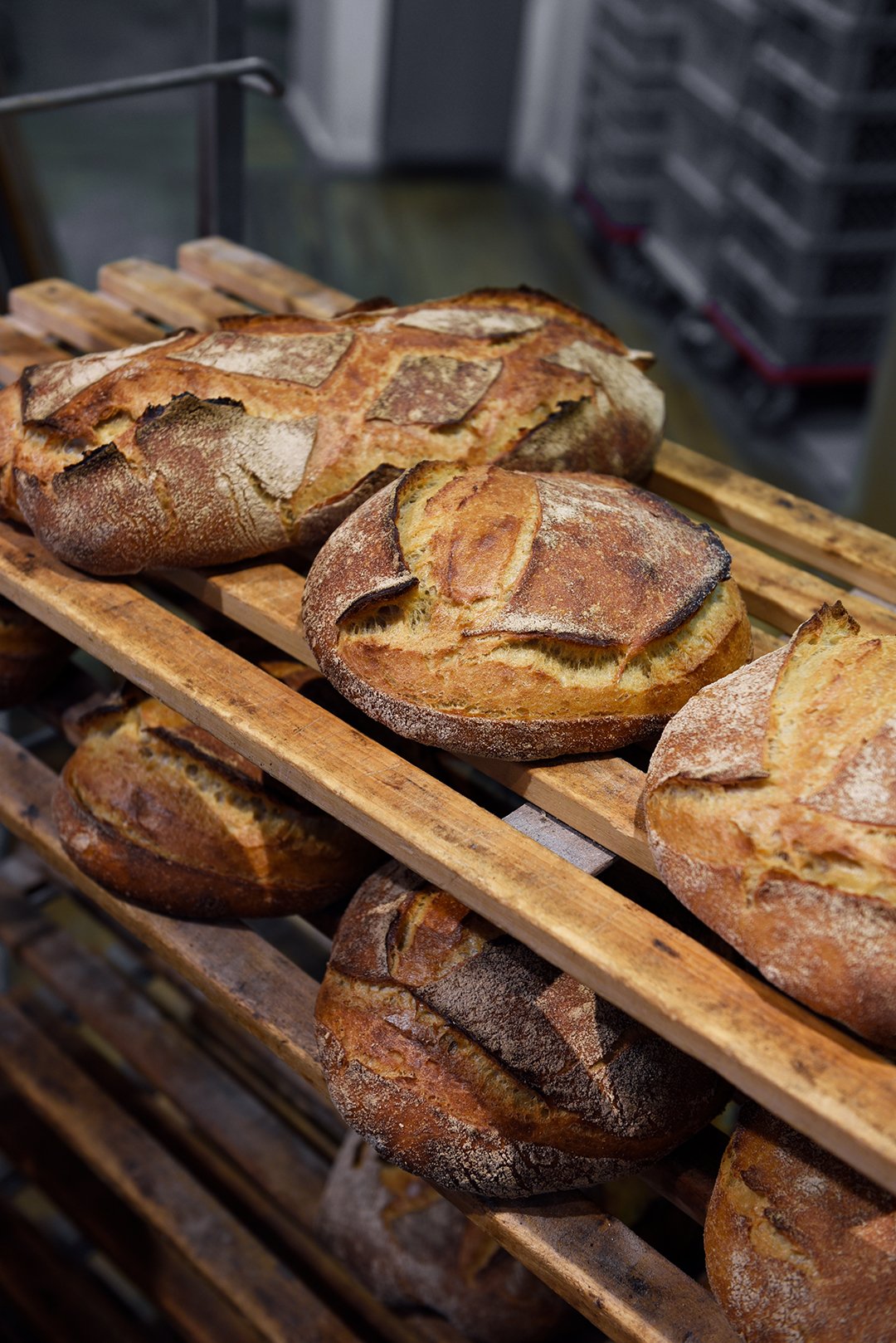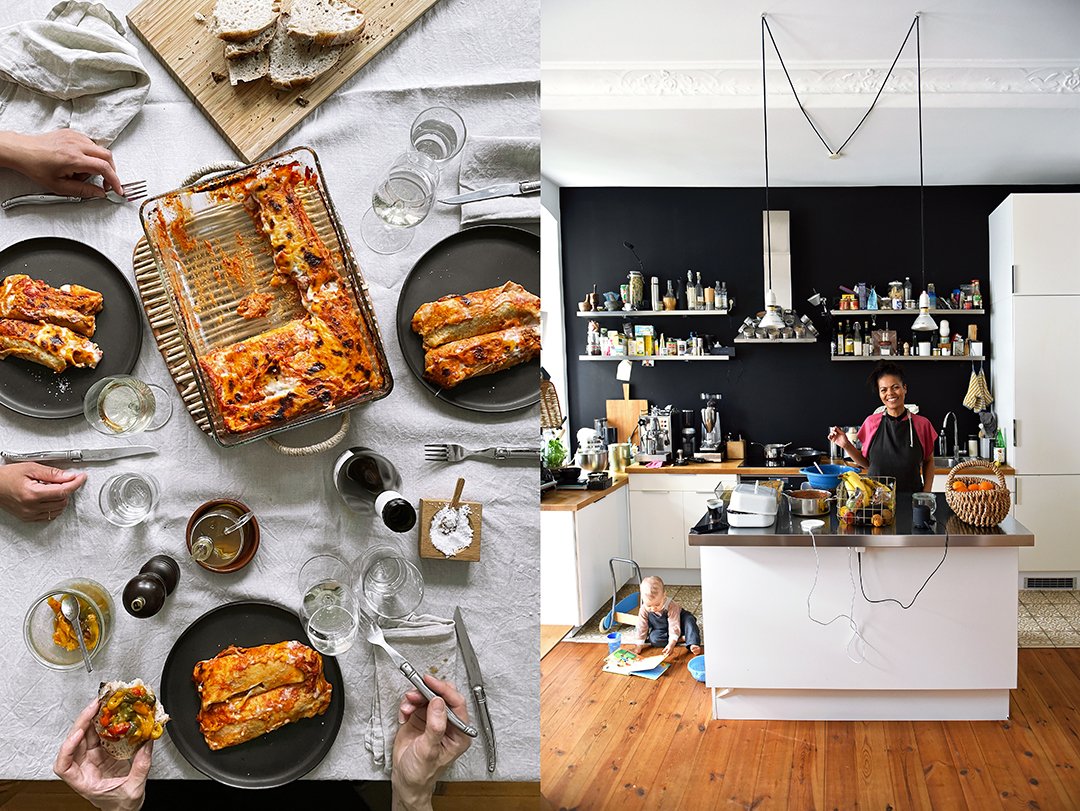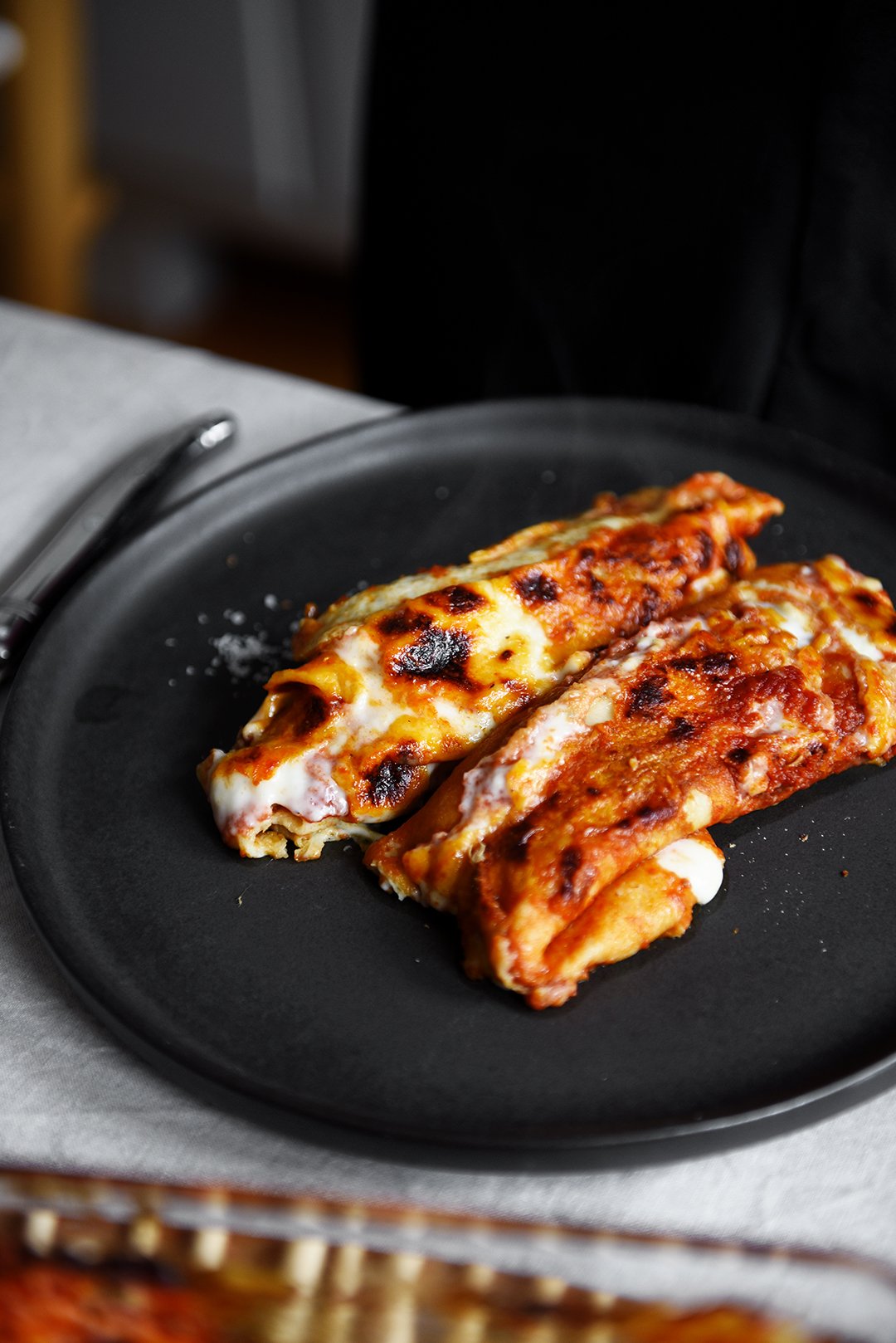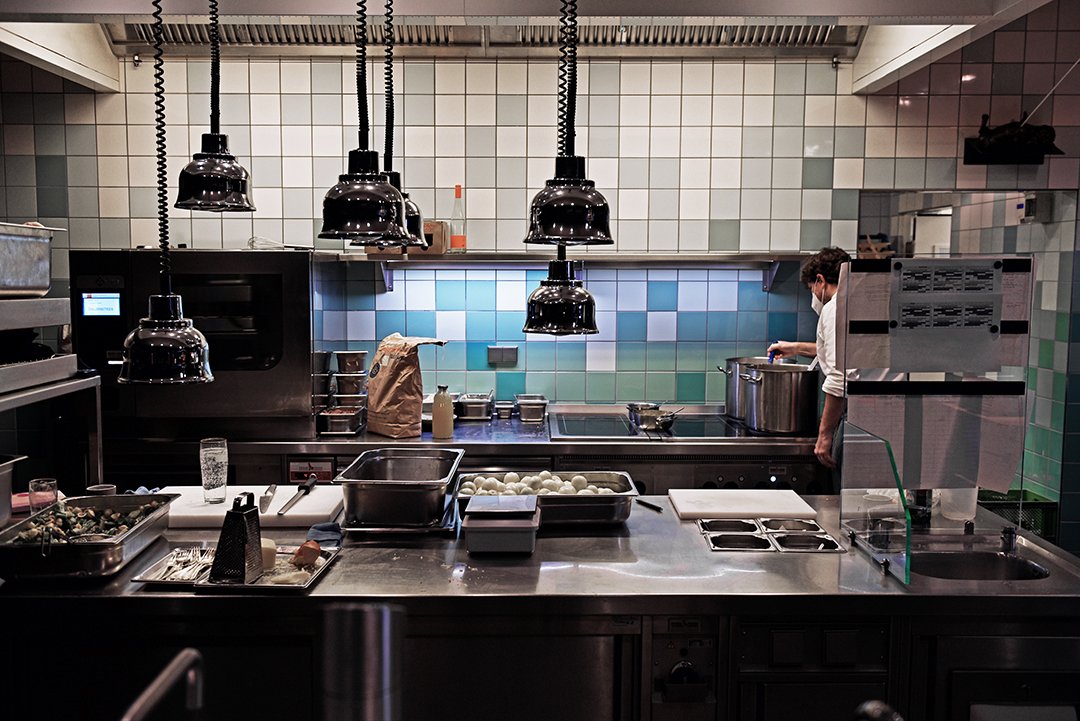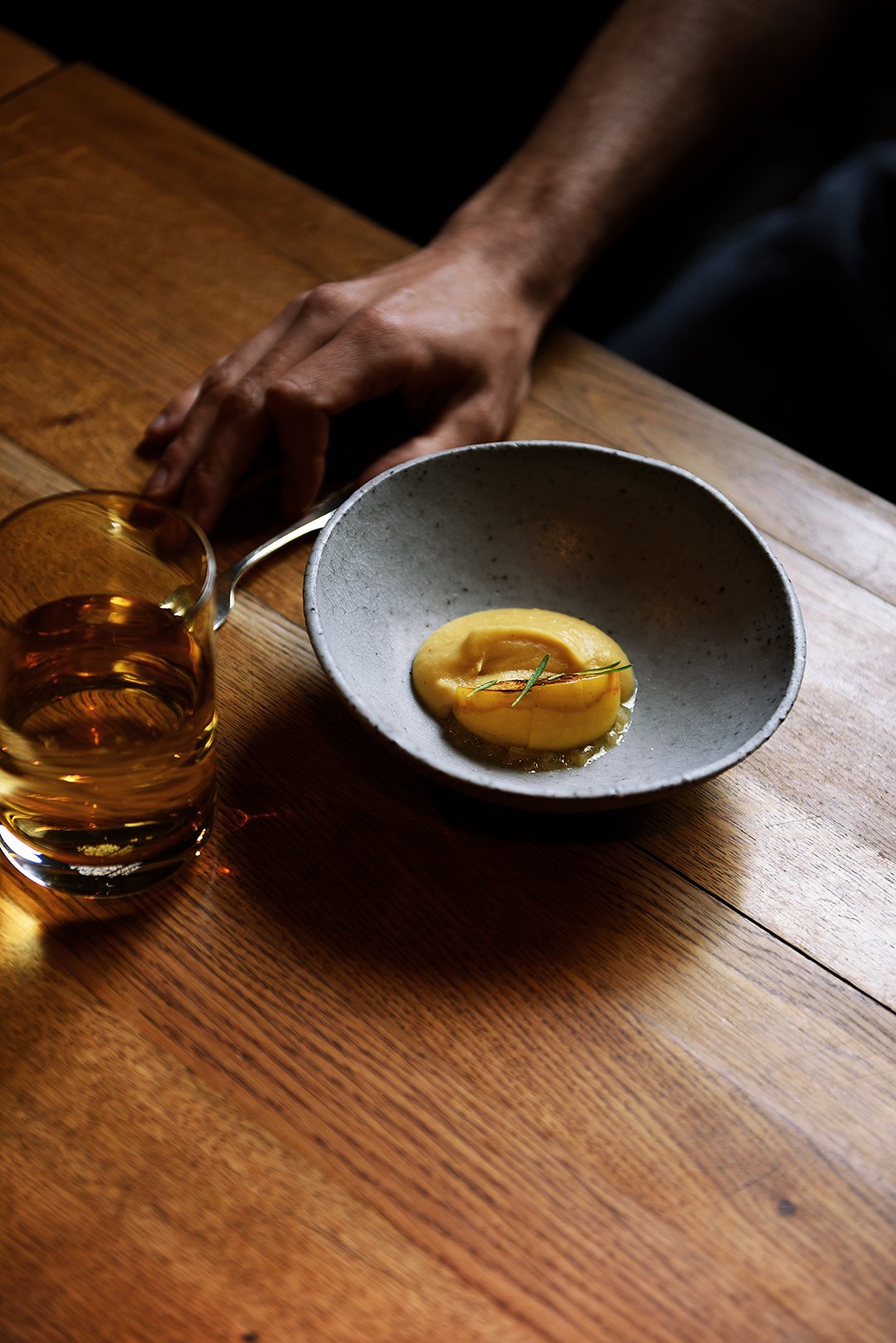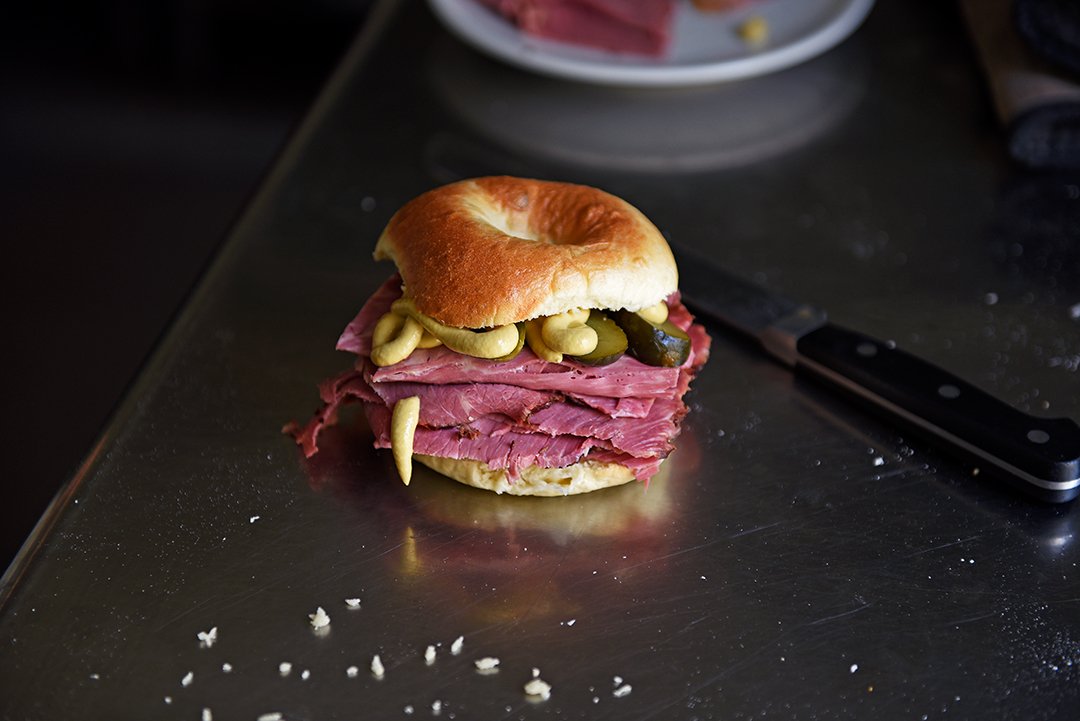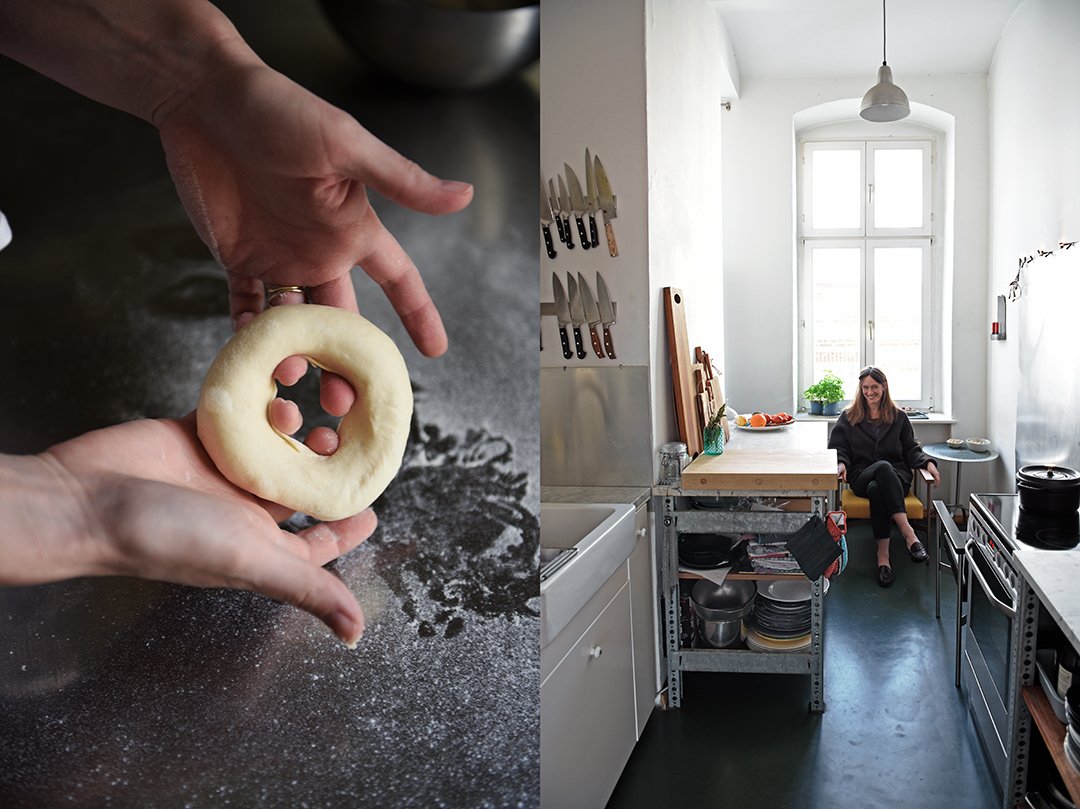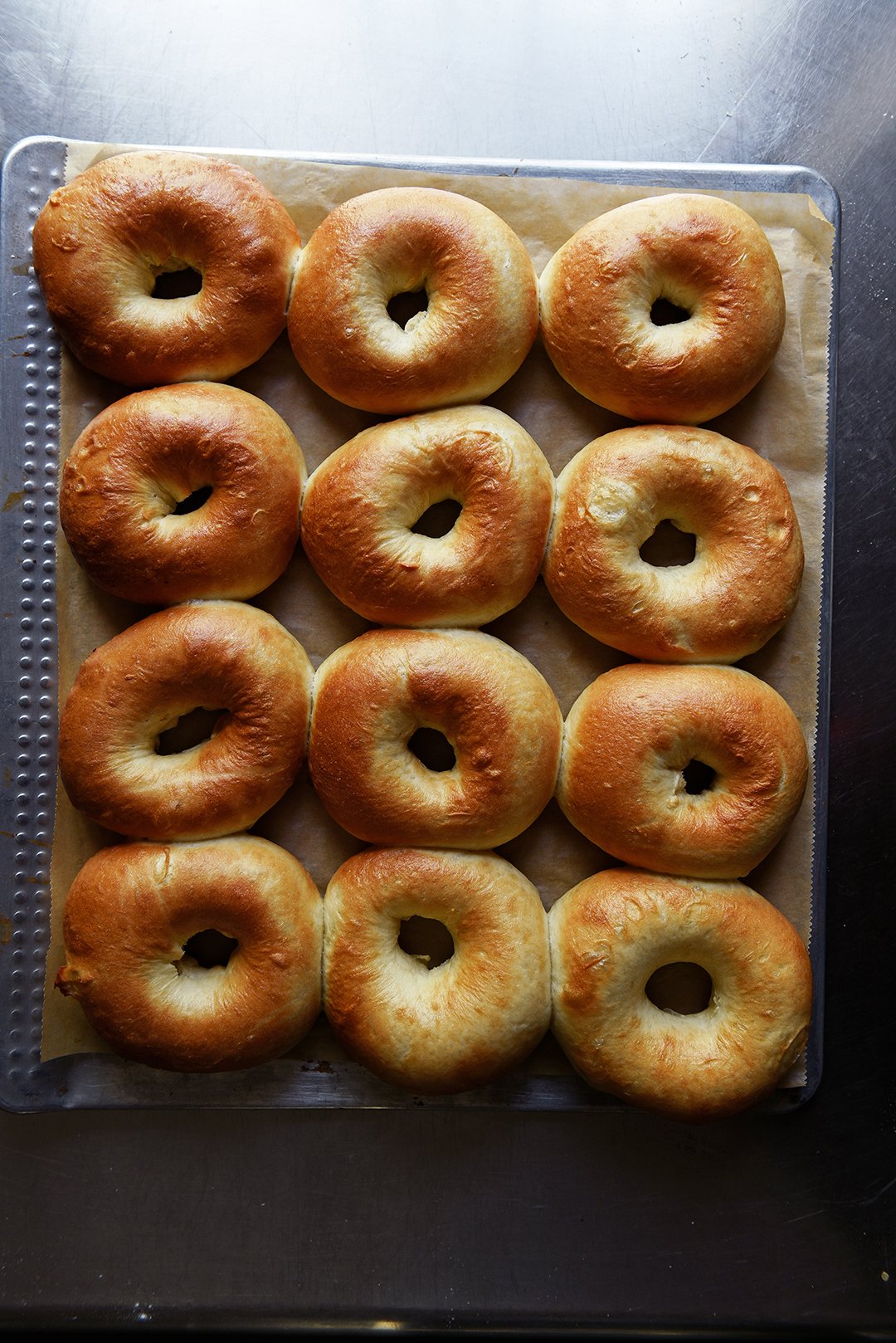Meet In Your Kitchen | Berlin's Best Beet at Vadim's Otto
This post is part of my Meet in My Kitchen podcast: How did we get to where we are in life & what does food have to do with it
"That was probably the most intense time of my life. It was the restaurant I looked up to the most. I thought this is the best restaurant in the world." - Vadim Otto Ursus
Smoky pans and blazing fire at Noma's Pop Up in Tulum, screaming and rushing, the air filled with adrenalin like a ballon ready to burst, tweezers in your hand to arrange plates to fragile perfection - Vadim Otto Ursus wanted to experience all of this and he got it. Born in Berlin, raised in Berlin, and he even returned to his city although he had the chance to keep working at Noma and other illustrious restaurants.
Vadim's parents lived in a squat in Berlin Mitte, one of the many empty houses in the 90s that people just moved into, put a lock on the door, and called it their home. It was common, no one cared. You payed one D-Mark, symbolically. There was no heating or warm water but lots of freedom and all the possibilities in the world. Vadim's mother is an artist, his father is a media historian, the wall had just fallen, and they decided to move to Berlin. Galleries popped up all around their apartment, there were exhibitions at every street corner - and young Vadim was right in the middle of it.
"You did the same thing most of the time, just when everything worked smoothly, the chef, René Redzepi, would say OK, change positions! to keep the adrenalin level at 120% so that you wouldn’t rest but always be pushed to maximum pressure." - Vadim Otto Ursus
Before he even had a chance to get lost in Berlin's party world, which he loved and that was equally exciting at that time as the art world, his mother involved him in her art projects and his father introduced him to a little restaurant on Schönhauser Allee. A bunch of young chefs, pioneers in Berlin's - at that point - culinarily wild and not very refined East, sparked something in Vadim. After having been surrounded by the arts, boundless creativity and freedom, he was hungry for a life that was a bit more structured, where cause and effect were a bit more predictable; less interpretation, more facts. Cooking is a craft, you cut your ingredients, you choose a technique, you improve your skills, and at one point you can pretty much say what the result is going to be like. Vadim liked that idea.
For an art project, the mother-son duo went on a trip to Mexico together. For two months, Vadim cooked in a food truck at a market in Mexico City and his mother curated a flow of people from different backgrounds bringing ingredients to the truck, or just their stories, all of them coming together at the table for lunch. Working with local produce, working with fire, using techniques he had learned in Germany, the puzzle slowly started to come together.
"The plates, the dishes were delicious and looked almost perfect but I don’t understand how anything good should come out if it was created with so much hate, anger, and fear."- Vadim Otto Ursus
The freedom and harmony that had surrounded him all his life was something the young chef never took for granted. He was curious about the other side where chefs scream in steaming kitchens, where pots are flying, and single leaves are meticulously arranged with tweezers for hours. So he ended up at Quintonil, no. 27 in the World's 50 Best, and just at that time René Redzepi and his team visited Quintonil's kitchen right before their Noma Pop Up started in Tulum. Coincidence or destiny, Vadim joined their team and cooked at the world's most famous Pop Up. Vadim calls it one of the most intense experiences of his life, teaching him bold techniques and wild freedom in cooking he had never seen before, but also introducing him to a way of working that he didn't want to assimilate in his life.
Koks on the Faroe Islands, Maaemo in Oslo, Loco in Lisbon, Vadim got his fair amount of Michelin stars, flying pots, and tweezers - and he missed Berlin. In 2019, at the age of 25, he opened his own restaurant close to where he grew up, in Prenzlauer Berg: OTTO. The ingredients are local, the techniques are international, the atmosphere is very relaxed, and community - on both sides of the kitchen - is at the core of this restaurant. Various plates to share with each other fill the tables, honest fireworks, almost humble and not pretentious, convince your palate within split seconds that the best often lies very close to us.
"I knew it before I went there but Mexico made it so clear to me: eating together, plates often placed in the middle of the table, huge piles of tortillas, using your hands, it can get messy, it’s spicy, bold flavors, that’s so much fun!"- Vadim Otto Ursus
And what does Otto taste like? The smokey, earthy note of a whole grilled butterflied boneless brook trout from a local farmer served with garum - a fermented fish sauce made at the restaurant of the fish's leftover bones and fins. This dish combines strong flavors from two culinary worlds: earthy local German trout and a fish sauce packed with umami, originated in Asia but made from a very common German fish.
Beet, cooked twice in sloe berry juice and dried in between, with a unique texture close to prunes meets labneh and brown butter (this is also the recipe Vadim shared with me,see below). Grilled sourdough bread from a local bakery is served with koji butter, fermented buckwheat that lends the fat a very ripe, cheesy note and that you can also buy from them online. Grilled kale is tossed with a green salsa made of herbs that Vadim harvests in the countryside outside Berlin. So what do we learn? Traveling and experiencing the world outside of our box doesn't detach us from ourselves, from our roots, it refines who we are and makes the bond even closer.
The podcast episode with Vadim Otto Ursus is in German. You can listen to the Meet in My Kitchen podcast on all common podcast platforms; there are English and German episodes. You can find all the blog posts about these podcast episodes including my guests’ recipes here on the blog under Meet in Your Kitchen.
Listen to the podcast episode with Vadim on:
Spotify / Apple / Deezer / Google / Amazon / Podimo
On Instagram you can follow the podcast @meetinmykitchenpodcast!
Beet, Sloe Berry, Labneh and Brown Butter
by Vadim Otto Ursus
Mind that you have to start preparing the beet and labneh a day in advance. The beet is cooked then it sits overnight, is dried in the oven for 7-8 hours the next day, and then briefly warmed up in the juice again.
Serves 4 to 6
1kg / 2 1/4 pounds medium beet (with skin)
Fine sea salt
1l / 4 1/4 cups sloe berry juice - alternatively, you can use700ml / 3 cups plum juice mixed with 200ml / 3/4 cup plus 2 tablespoons water, 100ml / 1/3 cup plus 1 tablespoon cider vinegar
500g / 17 1/2 ounces full-fat yoghurt (cow milk or sheep milk)
100g / 1/3 cup plus 1 1/2 tablespoons unsalted butter
A few leaves of Belgian endive, radicchio, or sorrel, torn into bite size pieces, for serving
Day 1
Add the beet to a large pot and cover with water then add 3 tablespoons of salt and bring to a boil. Cook for about 50 minutes or until tender. Transfer the beet to a colander placed in the sink and, while you keep the water running, use your hands to rub the skin off the beets. Cut each beet into 6 wedges and transfer to a large bowl then mix the sloe berry juice with 2 tablespoons of salt and pour over the beet. Cover the bowl with a lid and let it sit overnight at room temperature.
To make the labneh, line a colander with a cotton kitchen towel or muslin cloth then place it over a large, deep plate. Mix the yoghurt with 1 tablespoon of salt and transfer to the lined colander; let it sit overnight at room temperature.
Day 2
In the morning, preheat the oven to 70°C / 155°F. Line 1-2 baking sheets with baking paper.
Transfer the strained yoghurt to a bowl and keep it in the fridge, discard the liquid. Remove it from the fridge and keep it at room temperature about 30 minutes before serving.
Reserving the juice, transfer the beet to a colander to drain for a few minutes then spread them on the prepared baking sheet(s). Leaving the oven door slightly ajar by using the stick of a wooden spoon, dry the beet in the oven for 7-8 hours, or until they resemble soft (and not too dry) prunes. Season the reserved sloe juice with a little salt and set aside.
Just before serving, slowly cook the butter in a large pan over medium heat until it is golden brown and smells nutty (it shouldn't burn!); set aside and keep warm.
Transfer the dried beet to a large pot, add enough of the reserved sloe juice so that the beet is almost covered then bring to a boil and immediately remove the pot from the heat.
Arrange some of the beet and a little of the sloe juice that it's been warmed up in, in the middle of a deep plate. Drizzle with a couple spoons of the brown butter and place a generous dollop of the labneh next to the beet. Arrange a few pieces of Belgian endive (or other leaves) on top and serve immediately.
Meet in Your Kitchen | Kristiane's Kaiserschmarrn, Pars and Pralinés
This post is part of my Meet in My Kitchen podcast: How did we get to where we are in life & what does food have to do with it
"I thought I wasn’t allowed to do something that was different from what I had learned. I felt trapped in the traditional framework of the patisserie. I was very nervous to dive into a new scene where I felt I didn’t belong to." - Kristiane Kegelmann
Whenever we create something we use our senses. No matter if it's about the arts or crafts, we see, we feel, we smell, and when it comes to food, we also use our taste. Kristiane Kegelmann loves working with the whole sensory spectrum, in her art and in the food she creates - and especially when they both merge.
During her early years as a pastry chef in Vienna, at the traditional Demel confectionery founded in 1786, Kristiane often pushed the boundaries of her craft. Although the budgets for customized cakes, torten, and gateaux were often almost bottomless, the freedom, the expectation of how a sweet creation should look like was limited. In size larger than herself, the costs sometimes reaching the price of a small car, yet her creativity was forced to stay within a certain range, the rigid range of the classic patisserie, of its craft and creations, defined over hundreds of years.
There was no tolerance when her aesthetic feeling, and her curiosity, left the frilly cream toppings and sugary ruffles and roses behind. Kristiane likes cubistic shapes reminding of the concrete architecture of the 60s and 70s, of brutalism, Le Corbusier and Gottfried Böhm, or the angular shapes of Daniel Libeskind's buildings. Her approach is far from sweet, cute, and superficially pleasing. Her aesthetic is definitely challenging for the stubborn pastry traditionalist.
It was only through the arts that she felt able to free herself, to go beyond her own expectations in her craft. Working with an Austrian sculptor, experimenting with architectural forms and structures, combining edible and non-organic material both in her art and in her pastries and chocolates, and in the end leaving Vienna to move to Berlin, were the necessary steps to become the artist and pâtissière she wanted to be.
"Chocolate allowed me to fill a shape with a surprise. I felt, seeing that this is what I’m good at, I’m allowed to turn it into art." - Kristiane Kegelmann
Growing up in Munich in a family where food in general, but each ingredient in particular, was given a lot of attention, a huge effort was made to strive for quality and track the origin of the products that ended up in her mother's kitchen. Kristiane knew about buckwheat - and wasn't particularly fond of it - when the other kids were still munching on soft wheat bread sandwiches with flappy cheese. Her sense for flavors, for quality, started to become more and more refined even before she became aware of it.
Arriving Berlin in 2015, all of a sudden Kristiane had all the freedom, and the space, to create art and food according to her own ideas. Some of her works are edible, like her chocolates and pralinés, some aren't, which turned into a new conflict: where are the two disciplines interwoven, where shouldn't they, where does one start and the other one end? It's an ongoing process and the price you pay for creative freedom.
"In our traditional food, we used to be much closer to the original produce than we are today. It’s a process of simplification, of industrialization." - Kristiane Kegelmann
At least at her pars pralinés shop, you can eat everything the pastry chef puts in front of you - and that is spectacular. Kristiane puts the same attention into her sweet creations' fillings as she puts into their shapes and (natural) coloring. Once you bite into the delicate chocolate shell, you might be surprised by a fragile crunchy dill flower, or pear combined with sesame - which is a fantastic combination. Hops and lavender also go very well together, and a classic hazelnut praliné impresses with the intense, pure taste of hazelnuts that come from Kristiane's home region, from Bavaria.
We would have loved to share a praliné recipe with you but unfortunately, the preparation is too complex, so instead we went for a very comforting Austrian breakfast/ brunch/ teatime/ dessert classic: kaiserschmarrn - a torn pancake - with hazelnuts and apple purée.
The podcast episode with Kristiane Kegelmann is in German. You can listen to the Meet in My Kitchen podcast on all common podcast platforms; there are English and German episodes. You can find all the blog posts about these podcast episodes including my guests’ recipes here on the blog under Meet in Your Kitchen.
Listen to the podcast episode with Kristiane on:
Spotify / Apple / Deezer / Google / Amazon / Podimo
On Instagram you can follow the podcast @meetinmykitchenpodcast!
Kaiserschmarrn with Hazelnuts and Apple Purée
by Kristiane Kegelmann / pars
Kristiane uses her own pure hazelnut spread (Nussmus) for serving, which you can buy online from her shop, but you can of course replace it with any other quality hazelnut spread (although hers is particularly delicious!).
She refines the apple purée with cherry blossom sugar (fresh cherry flowers mixed with sugar and stored in a jar, it's divine!) but you can also use regular sugar.
Serves 4
For the cherry blossom sugar (optional)
1kg / 5 cups granulated sugar
1 handful fresh cherry blossoms
Combine the sugar and cherry blossoms, rubbing the sugar and blossoms with your hands to intensify the flavor, and store in a large jar.
For the apple purée
50g / 1/4 cup cherry blossom sugar (or granulated sugar)
120ml / 1/2 cup apple juice
4 medium, sour, firm apples, cored and cut into small pieces (don't peel the apples)
In a large pan, caramelize the sugar over medium heat then add the apple juice and stir until the caramel dissolves. Add the apples and cook until soft then sweeten with sugar to taste. Using a blender or a blender stick, purée the apples until smooth. If you prefer the apple purée a bit thicker, transfer it to the pan and cook, stirring constantly, until it reaches the desired texture.
For the kaiserschmarrn
1 ounce / 25g whole hazelnuts with skin
4 large eggs
A pinch of salt
30g / 2 generous tablespoons granulated sugar
350ml / 1 1/2 cups whole milk
160g / 1 1/4 cups all-purpose flour
Unsalted butter, to cook the kaiserschmarrn
About 4 tablespoons hazelnut spread, whipped until soft, for serving
1-2 tablespoons confectioners' sugar, sifted, for serving
In a medium pan, roast the hazelnuts, stirring constantly, over medium heat for about 2 minutes or until fragrant; let them cool for a few minutes. Using your hands, rub the skin off the hazelnuts then chop them roughly and set aside.
In the large bowl of a stand mixer, fitted with the whisk attachment, whisk the egg whites and salt for a few minutes until stiff then transfer to a large bowl and whisk the egg yolks and sugar for a few minutes until light yellow and creamy. Using a wooden spoon, gently fold 1/3 of the milk into the egg yolk mixture, followed by 1/3 of the flour. Repeat with the remaining milk and flour, folding until combined, then gently fold the egg white into the batter just until combined.
In a large pan, heat a generous tablespoon of butter over medium-high heat, add half the batter, reduce the heat to medium, and cook for a few minutes or until the bottom of the pancake is golden. Cut the pancake into 4 pieces, add a little more butter to the pan, then flip each piece and cook until the bottom is golden. Using 2 forks or spatulas, tear the pancake into chunky pieces. Sprinkle with a little sugar, add a bit more butter if necessary, and cook the torn pancake, stirring, for a few more minutes or until golden brown then transfer to a large platter, cover, and cook the remaining batter in the same way.
Divide the kaiserschmarrn between 4 plates, sprinkle with the hazelnuts, drizzle with the hazelnut spread, and dust with confectioners' sugar. Add a dollop of the apple purée and serve immediately. Enjoy!
Meet In Your Kitchen | Rhinoçéros Bar, Jazz and Béné's Shrimp Cocktail
This post is part of my Meet in My Kitchen podcast: How did we get to where we are in life & what does food have to do with it
"Music is love, food is fun." - Bénédict Berna
From French rap music via Berlin's club scene right into jazz: Bénédict Berna's musical journey reflects the chapters in his life. Each musical genre is woven into his work projects, musical fragments becoming the tune of his life.
As a music producer in France, it was the beat and the political message of rap pulling him into the studio. This, and the fact that there was no place to go to as a teenager, made him organize concerts and parties at the age of 16. He admits that it wasn't an altruistic move, he wanted to play in bands but the other kids wouldn't let him. So at his parties and concerts, Béné would add himself on the lineup - and place himself at the drum machine - and the other kids had to give in.
He was hooked, he loved the energy bursting out of these events. Creating a place, a period of time, that makes other people simply happy became his passion and profession.
"Berlin was like a huge kindergarten. There was space, air to breathe, you didn’t have to fight for your place."- Bénédict Berna
Born in Valence and growing up in Donzère, a small and not too exciting town in the Rhone valley between Lyon, Montpellier, and Marseille, Béné got used to moving around, networking, and organizing concerts wherever the crowd was hungry for it. His appetite also grew yet he felt the creative limitations of the smaller towns and cities. Paris wasn't an option for him. He says it's too snob and rigid, all places have been taken and occupied a long time ago. But Berlin was the exact opposite to that.
In 2003 things were still rather wild in Germany's capital, especially in the party world. So when Béné arrived it didn't take too long for him to find his way straight into the clubs, soon taking care of the set lists, bands, and DJs of Club Maria and Club Chez Jacki. The clubs and bars were the pumping heart of a city that didn't know any limits or regulations. It was total freedom - and innocence - at least for a little while.
"I don’t want to become an icon, I don’t want to be an institution. I want people to have a good time."- Bénédict Berna
Berlin changed and grew up, at least a little bit, but change isn't necessarily a bad thing. Béné left the clubs behind and became the manager of a wine bar, Brut on Torstraße. It was one of the earlier places where finally wine, cheese, and bread all tasted fantastic. Something that shouldn't surprise but back then it did because the general quality level in the city was just so bad. At Brut, you were never really sure who was a guest and who worked there. It was one big family.
All those years and experiences shaped the formula for Béné's own bar that he opened in 2017 together with his wife, Martina. So it's not a surprise that Rhinoçéros is a bar that does everything right. French wine and cheese, crunchy baguette, Japanese whiskey, the atmosphere warm and intimate, it feels a bit like home, just more special.
All this would already be enough to win my heart but Béné's love for jazz, vinyl, and vintage hi-fi sound systems - and for organizing events - made him turn towards a Japanese phenomenon: the Tokyo Jazz Kissa. It's basically a bar (or coffee shop) where people listen to vinyls while drinking tea - or whiskey, or wine. So at Rhinoçéros, they have special nights, curated listening sessions, where no one talks but sits still in front of 1976 wooden Bowers & Wilkins speakers, kind of like at a concert, to peacefully listen to the whole length of legendary jazz recordings. Béné says that he himself is surprised at times by the intimacy that these nights create. But that's the power of great music, food, and wine - and great hosts.
When I asked Béné which recipe he'd like to share with us, he suggested a Shrimp Cocktail. First I was surprised then I indulged in nostalgia. So thanks to this dinner party classic, we'll have a proper 80s revival in the kitchen (Béné says it's actually from the 60s). Béné's version is super quick to prepare, perfectly balanced, and, thanks to tangerines giving it a hint of acidity, it's even refreshing. And it goes extremely well with oysters and champagne for lunch, that's what we did - just don't expect you'll get anything done after this so save it for the weekend.
The podcast episode with Bénédict Berna is in German. You can listen to the Meet in My Kitchen podcast on all common podcast platforms; there are English and German episodes. You can find all the blog posts about these podcast episodes including my guests’ recipes here on the blog under Meet in Your Kitchen.
Listen to the podcast episode with Béné on:
Spotify / Apple / Deezer / Google / Amazon / Podimo
On Instagram you can follow the podcast @meetinmykitchenpodcast!
Shrimp Cocktail
by Bénédict Berna
Serves 4
5 tablespoons mayonnaise
2 tablespoons ketchup
2 teaspoons cognac
4-5 drops Tabasco
Freshly grated orange zest, to taste
450g / 1 pound medium shrimps or prawns, cooked and peeled, cold
2 large Belgian endives, very thinly sliced crosswise
2 tangerines, peeled (skin and white pith removed) and cut into segments
In a large bowl, whisk together the mayonnaise, ketchup, cognac, Tabasco, and a pinch (or more) of orange zest. Add the shrimps and toss to combine.
Divide the Belgian endive, shrimps, and tangerines among 4 bowls (or wide champagne glasses) and serve immediately.
Update: this recipe will also be in my NOON cookbook!
Meet In Your Kitchen | Erik Spiekermann's Lemony Mushroom Risotto
This post is part of my Meet in My Kitchen podcast: How did we get to where we are in life & what does food have to do with it
"I’m incredibly chaotic and I’m incredibly precise. When I do work like typesetting and stuff, I’m 100% precise. I do the shittiest detail that nobody would ever know, but I’m also incredibly chaotic in my approach." - Erik Spiekermann
Erik Spiekermann's greatest gift is that he never stopped thinking like a child. He's still driven by the same stubborn persistence, by a tireless curiosity, and the imperturbable will to find out what lies underneath the surface. The acclaimed designer and typographer, responsible for the corporate looks of brands like Audi, Bosch, and Deutsche Bahn, creator of Meta - the Helvetica of the 90s - and the man who decided that the BVG, Berlin's public transportation system, needs to be yellow, is basically still a child, just in the body of a man.
"My curiosity is my biggest feature. I’ve always been curious, so much so that I have been careless. I mean I’ve done things like hitchhike to fucking Norway at 9, which is stupid, it’s the dumbest thing to do if I look back now but I was curious and I was innocent, and innocent and curious are the same. You’re innocent about something so you wanna find out how it works. And I’m still curious and I will try everything because it’s interesting and I think curiosity is one of the greatest human features otherwise we wouldn’t have invented the wheel nor the fire." - Erik Spiekermann
When Erik was nine years old he hitchhiked to Norway on his own. He was part of a Boy Scouts group, his older travel companion didn't show up so he decided to go up north on his own. I asked what his mother said, and Erik's brief answer was "She didn't know, only when I came back weeks later, rather tanned."
As a teenage boy, he was already fascinated by press printing. He got his first printing machine from his father, a mechanic who Erik thinks passed his strong passion for heavy machinery and their mysteries on to him. Whenever he got the chance, he sneaked into a friend's printing firm at night, trying to figure out how all of this works. Setting type and ruining one plate after the other until he internalized the concept - letting any proof of his failed attempts vanish by dawn - but when he finally filled the white pages with his own hands and ideas he was hooked.
Post-war Germany wasn't an easy playing field for a pubescent boy and young man, chances had to be made by yourself and Erik created plenty of them. First in Berlin, then he moved to London in the 60s with his young family, always managing to convince the people around him that he has the ideas that they need.
"We need to make things, we need to touch things with our hands, otherwise we’re gonna become very funny sort of reptiles or robots." - Erik Spiekermann
It only takes a few seconds to understand how Erik always manages to get people's full attention - and their trust. He is very charming but he is also a road roller. For the podcast recording at my place, he ran up the stairs with his racing bicycle on his shoulder (mind he's born 1947), he wasn't out of breath at all but ready to dive into hours of talking about design, life, and food. Erik used to often bake with his mother, never measuring anything, but sensitively adjusting texture, taste, and smell by feeling. Even then he didn't need anyone to tell him what to do, just a mother who taught him to refine his senses and listen to them. He is still very protective of his ideas and visions, fighting for them if need be, summed up in one of his many popular quotes: "Don’t work for assholes. Don’t work with assholes."
After years of designing and teaching, Erik decided to go back to his roots. All his printing equipment burnt in a severe fire in London in the 70s. A painful chapter that he never felt he had closed, a story he still wanted to continue writing, so he founded p98a a few years ago. It's a Berlin based non-profit experimental letterpress workshop stuffed with old equipment dedicated to letters, printing, and papers. Together with a group of designers, he passes his knowledge and skills on to the next generation and enjoys the play of old traditional analogue equipment and new digital technologies. You can order books, or posters and postcards with Erik's quotes and wisdoms, and join workshops with the master himself.
Although Erik would have loved to share his no-recipe-cantuccini recipe with me, I was worried that no one would be in the mood for cookies in January so instead, Erik and his wife, Susanna, shared the recipe for their delicious Lemony Mushroom Risotto with me.
The podcast episode with Erik Spiekermann is in English. You can listen to the Meet in My Kitchen podcast on all common podcast platforms; there are English and German episodes. You can find all the blog posts about these podcast episodes including my guests’ recipes here on the blog under Meet in Your Kitchen.
Listen to the podcast episode with Erik on:
Spotify / Apple / Deezer / Google / Amazon / Podimo
On Instagram you can follow the podcast @meetinmykitchenpodcast!
Mushroom Risotto with Lemon and Thyme
by Susanna and Erik
Serves 4 to 6
For the risotto
Fine sea salt
Olive oil
1 medium onion, finely chopped
420g / 2 cups Carnaroli rice, or Arborio rice
240ml / 1 cup dry white wine
70g / 5 tablespoons unsalted butter
60g / 2 ounces Parmesan, finely grated, plus 30g / 1 ounce for serving
4 tablespoons freshly squeezed lemon juice, plus more to taste
For the mushrooms
450g / 1 pound cremini or white mushrooms, trimmed, torn into bite-size pieces
Freshly ground black pepper
30g / 2 tablespoons unsalted butter
8 medium sprigs fresh thyme
3 small garlic cloves, crushed (optional, Susanna loves it, Erik doesn't)
For the risotto, bring 2.5 liters / 10 1/2 cups of water and 1 tablespoon of salt to a boil in a medium saucepan then remove the pan from the heat, cover, and keep warm.
In a large pan, heat a generous splash of olive oil over medium heat. Add the onion and a pinch of salt and cook, stirring constantly, for about 10 minutes or until golden and soft. Add the rice and cook, stirring, for 5 minutes. Add the wine and let it simmer for a few minutes then add a ladle of the hot salted water, the rice should be covered. Let it simmer very gently and, as soon as the liquid is almost fully absorbed, add more of the salted water. Keep adding a little water at a time, stirring gently once in a while. When the rice is al dente and the liquid is more or less absorbed, you might not need all the salted water, take the pan off the heat, and stir in the butter and Parmesan. Add more of the salted water if the texture isn't creamy (not soupy!) and season to taste with additional salt if necessary. Gently stir in the lemon juice, adding more juice to taste, then cover the pan and set aside.
For the mushrooms, heat a generous splash of olive oil over medium-high heat, briefly cook the mushrooms, stirring occasionally, for 2-3 minutes or until browned and still firm (not mushy!). Season to taste with salt and pepper, add the butter, 6 sprigs of thyme (keeping 2 sprigs for serving), and the garlic then reduce the heat to low and cook for a few minutes until the mushrooms are al dente but not soft.
Divide the risotto and mushrooms among bowls, sprinkle with a little Parmesan, some ground pepper, and the leaves of the remaining 2 thyme sprigs, and enjoy immediately.
Meet In Your Kitchen | Alfredo Sironi's Pizza with Cima di Rapa and Salsiccia
This post is part of my Meet in My Kitchen podcast: How did we get to where we are in life & what does food have to do with it
"Food means a lot, not everything, but a lot. I enjoy cooking more than eating." - Alfredo Sironi
There are two things Alfredo Sironi does all the time: chatting and eating while constantly moving around. When I sat with him outside his Sironi La Pizza restaurant in Berlin's Goltz Kiez, an endless flow of children, neighbors, staff, and guests stopped by to talk to the baker, always having his full attention. When we were at his Sironi il Pane di Milano bakery, at Kreuzberg's Markthalle Neun, he grabbed the pepper grinder from one of the stalls next to him, exchanging it for a piece of pizza and a quick chat with the chef. He nibbles bites of warm salsiccia from a tray while passing by and allows himself a couple minutes to indulge in the pizza bianca that we just baked together, but he won't sit still. Only quick moments of pleasure, before the man moves on to the next venture.
Alfredo says he's a better cook than eater. He blames his childhood. When you basically grow up right in a family restaurant you're always on the run, always looking out for problems that need to be solved and people who need to be taken care of. You have a quick nibble in between chats but you barely sit down to eat. It runs through his family, he says.
"Everything we describe as tradition is fake. There weren’t potatoes in Germany, there weren’t tomatoes in Italy. Noodles, pasta come from China. It’s a cultural process, every day rewritten over and over again." - Alfredo Sironi
Growing up on a farm in Lombardy - between Milan and Como, close to northern Italy's buzzing industrial center yet at the same time, you're surrounded by lush green fields, paddocks, and horses - his life was about his parent's restaurant, his family and friends, and the restaurant's regular guests. Women always played an important role in his world. Although his father started the business, and he's also the most passionate cook in the family, it was Alfredo's mother who kept the motor running smoothly. Due to the region's economic success, the women in northern Italy already ran thriving businesses in the 50s. The cliché of the mother, cooking and staying at home in the kitchen, wasn't Alfredo's reality.
The Sironi family comes from Piedmont, Lombardy, Veneto, and Emilia-Romagna so the family's home cooking mirrors the best of what the four regions bring to the table. Bread and pasta is a staple, always homemade and part of every day's lunch and dinner. Everyone knows how to make it, it's in their blood. And exactly this would become one of Alfredo's greatest assets.
"You can’t prepare yourself for your failure but you have to be prepared for your success. When you start a business, you only focus on avoiding that it crashes. You hope that customers will come, that you can pay your bills, and that it will all work out. But in reality, everything can be totally different, that you are successful. And then the bakery was too small, I hadn’t considered this option in the beginning." - Alfredo Sironi
Until Alfredo moved to Berlin at the age of thirty, he never questioned his cosmos circling around the food and the people that were simply there all his life. It could have been so easy for him to just stay there, to take over the family business at one point, to live this beautiful life in this beautiful place with all the people he loves - but he was hungry for something else. So when Alfredo came up north to move to Germany's capital, he used his memories of the people and the food in Italy, the memories of his daily life, to found his own bakery. Although he studied history in Milan and already saw himself following an academic career, things changed.
In 2010, Berlin's food scene was buzzing and hungry for the new. Carbs are Alfredo's passion. Every day, bread was freshly baked and pasta freshly rolled at his family's restaurant and he helped out whenever a hand was needed. For him, good bread isn't science, it's knowledge and experience. He knew Berlin didn't have anything like the Milan-style bread he grew up with and felt the city would love it yet he was also aware of the risks.
In the end, there was nothing to worry about. It only took a few months for the Berliners to fall in love with the baker and his goods. Right from the start, you could always find Signor Sironi on the annual Berlin's Best Bread lists. His sourdough loaves are praised, his sheet-pan pizza is the reason for ongoing pilgrimages of the carb loving crowds to his bakery in Kreuzberg and to his new pizzeria where the pizza is round. Alfredo Sironi knows his dough, maybe it's as simple as that.
Alfredo shared the recipe for his Pizza Bianca with Cima di Rapa and Salsiccia with me. It's a recipe that I love so much that when I first ate it a few years ago, I came up with my own take on it for the blog. It proves that reducing the toppings for pizza often leads to the best results.
The podcast episode with Alfredo Sironi is in German. You can listen to the Meet in My Kitchen podcast on all common podcast platforms; there are English and German episodes. You can find all the blog posts about these podcast episodes including my guests’ recipes here on the blog under Meet in Your Kitchen.
Listen to the podcast episode with Alfredo on:
Spotify / Apple / Deezer / Google / Amazon / Podimo
On Instagram you can follow the podcast @meetinmykitchenpodcast!
Pizza Bianca with Cima di Rapa and Salsiccia
by Alfredo Sironi
Makes 2 to 3 pizza sheets (using 30 x 40cm / 12 x 16“ baking sheets; if you make 3 sheets the pizza base will be thinner and crunchier, 2 sheets will lead to a thicker, softer base)
For the dough
700ml / 3 cups water, lukewarm, plus more as needed
10g / 1/3 ounce fresh yeast, crumbled
1kg / 7 2/3 cups high gluten wheat flour (German flour type 1050)
20g / 1 tablespoon barley malt syrup (or rice syrup, or molasses)
20g / 4 teaspoons fine sea salt
For the topping
4 - 6 salsiccie (or any other coarse sausage), skin removed, sausage torn into bite size pieces
800g - 1.2kg / 1 3/4 pounds - 2 2/3 pounds cime di rapa, blanched or sautéed (you can also use drained jarred cime di rapa or replace it with broccoli)
500 - 750g / 1 - 1 2/3 pounds drained mozzarella, cut into french fries-shapes
Olive oil
Freshly ground black pepper
In the large bowl of a stand mixer, fitted with the hook attachment, whisk together the water and yeast and let it sit for a minute. Add the flour, syrup, and salt and knead well for about 5 minutes or until smooth; add more water if the dough is too firm. Cover the bowl and let the dough sit for 10 minutes (the ideal ambient temperature is 26-30°C / 80-86°F; you can use the oven or place the bowl on a heater).
After 10 minutes, leaving the dough in the bowl, grab the dough from underneath and fold it on top of itself then turn the bowl by 90° and repeat folding and turning the bowl for 4-5 times. Let the dough sit for 15 minutes then repeat the same procedure once again. Cover the bowl with plastic wrap, or put it in a rubbish bag and close it; you can also use a container with a tight fitting lid. Keep the dough in the fridge for 18-24 hours.
After 18-24 hours, divide the dough in 2 or 3 portions, roll out each portion so that it’s roughly the size of your baking sheet then oil 2-3 baking sheets and arrange the prepared dough on top and cover with kitchen towels. In a warm place, let the dough rise until it roughly doubles in size; depending on the ambient temperature, this will take 30-60 minutes.
Preheat the oven to the highest temperature setting (at least 250°C / 480°F).
Divide the salsiccia, cime di rapa, and mozzarella among the prepared baking sheets and bake for about 10-13 minutes or until golden brown and crunchy. Drizzle with a little olive oil, sprinkle with some pepper, and enjoy immediately!
Meet In Your Kitchen | Champagne, Scallops & Squash Soup with Vitalie Taittinger
This post is part of my Meet in My Kitchen podcast: How did we get to where we are in life & what does food have to do with it
"Food is love. It's the attention we can give to the people we are sharing life with." - Vitalie Taittinger
48 hours in the Champagne with Vitalie Taittinger - many bottles were popped and no dessert was missed in the making of this podcast episode!
Vitalie was born in Reims, she's the great-granddaughter of Champagne Taittinger's founder Pierre Taittinger and now she is the President of the champagne house. Two years ago, she took over from her father, Pierre-Emmanuel. When I first met the young woman a few years ago, I asked myself if it's a gift or a burden to be born into one of the world's most famous champagne families, if it's freedom or pressure.
"The fact that today we are both responsible for the company, I think this is something very strong in terms of complicité." - Vitalie Taittinger
Clovis is Vitalie's brother, he's the company's Managing Director. When it came to the decision who of the two children would follow into their father's footsteps, the father specifically didn't want to be part of the final decision making process. Instead, for a whole year, the entire team, including the two siblings, pondered on what would be best for the company. For them it was neither about ego nor about clever career moves. It was simply about finding a solution that would be best for Champagne Taittinger; that would be best to keep a tradition alive and thriving. This story says so much about a family and about a region and its mystified product. It says so much about what champagne is about.
The Champagne region is a tiny cosmos built on history, values, tradition, and trust. It goes beyond family although the families that founded the big houses and cultivated champagne over hundreds of years are at the core of this cosmos. It's important to understand that all the champagne houses on their own can't cover the demand of grapes for their production just by using the produce from their own vineyards. It's just not enough. They depend on a large network of small independent growers in the region. There are contracts yet if the growers don't want to cooperate with a champagne house, the champagne house won't survive. They both depend on each other, which is fruitful and only works when their cooperation is built on trust, respect, and the same values. Land is precious and limited - and a UNESCO world heritage since 2015. It's one of the most expensive in the wine world. € 1 million per acre, only topped by Bordeaux's and Burgundy's top appellations.
"A company is a human adventure and when you’re a family you stay very close to these human values." - Vitalie Taittinger
When Taittinger was sold by the extended family in 2005 - a step Vitalie's father didn't agree with - it only took him a year to have the support from a local bank and the backup from the growers to buy the company back and be assured that he would manage to keep producing outstanding champagne.
So when Vitalie joined the company in 2007 quite spontaneously, after studying art and establishing a life independent of Taittinger, she was aware of the responsibility given into her hands but also about the chance she got to keep the story of her family's champagne alive so that one day she could pass it on to the next generation: "The fact that we are a family running the company puts the adventure into a longterm process. I think we are not fighting for figures we fight to make this adventure last and transmit it to the next generation. We want to transmit the best terroir to the next generation and we want to pay attention to the health of the next generation."
"Déjeuner en l'Honneur de Madame Meike Peters" - Merci beaucoup, Vitalie!
The past is deeply woven into the region, it's constantly present, contributing to the mystique of the Champagne: no matter if your in Reims visiting Notre-Dame de Reims, the cathedral chosen for the coronation of the kings of France; if your in Taittinger's cellars 18 meters underground in the Abbey of Saint-Nicaise built in the 13th century in Roman chalk pits dating from the 4th century; or driving to the family's Château de la Marquetterie, an 18th century residence 40 minutes outside Reims, which Vitalie's great-grandfather Pierre bought in 1930. He had fallen in love with this place, a headquarter during World War I, when he spent time there as a cavalry officer in 1915.
It's not a surprise that Pierre was smitten. When I drove passed the vines and through the chateau's gate to visit Vitalie in her kitchen, and record our podcast episode in one of the salons, I was smitten, too, with Vitalie and the chateau.
Vitalie shared a recipe with me that's both cozy and sumptuous, Squash Soup with Chestnut Purée and Scallop Carpaccio with Spinach Pesto and Caviar - easy to prepare in advance and perfect for a New Year's Eve dinner!
Bonne année!
The podcast episode with Vitalie Taittinger is in English. You can listen to the Meet in My Kitchen podcast on all common podcast platforms; there are English and German episodes. You can find all the blog posts about these podcast episodes including my guests’ recipes here on the blog under Meet in Your Kitchen.
Listen to the podcast episode with Vitalie on:
Spotify / Apple / Deezer / Google / Amazon / Podimo
On Instagram you can follow the podcast @meetinmykitchenpodcast!
Squash Soup with Chestnuts, Scallop Carpaccio and Caviar
by Vitalie Taittinger
The scallops are eaten raw and need to be very fresh. If this seems too risky for you, sear the scallops quickly in a little olive oil over high heat on both sides (this takes 2-3 minutes) and season with salt and pepper.
Serves 4
For the scallop carpaccio
10 very fresh scallops
Caviar, adjust the amount to your budget
For the spinach pesto
1 large handful fresh baby spinach leaves, plus 16 small spinach leaves for serving
Olive oil
1 lime
Fine sea salt
Ground black pepper
For the soup
1 liter / 4 1/4 cups vegetable broth
1 butternut squash (about 3 pounds), peeled, seeds removed, and cut into cubes
1 star anise
2 bay leaves
Fine sea salt
Ground black pepper
Crème fraîche, to taste
For the chestnut purée and topping
200g / 7 ounces vacuum-packed whole cooked chestnuts
120ml / 1/2 cup heavy cream, whipped until stiff
2 teaspoons granulated sugar
1 tablespoon freshly grated, or very finely chopped, orange zest
For the scallop carpaccio, keep the scallops in the freezer for a couple hour; this will make it easier to cut them.
For the soup, bring the broth to a boil then add the squash, star anise, and bay leaves, season to taste with salt and pepper, reduce the heat, and simmer for about 30 minutes or until the squash is soft. Remove and discard the star anise and bay leaves. Using a blender stick or blender, purée the soup until smooth then season to taste with salt, pepper, and crème fraîche and cook, stirring constantly, until it reaches the desired taste and texture; cover the pot and keep warm.
For the chestnut purée, set 3 chestnuts aside then purée the remaining chestnuts until smooth (add a little water if necessary) and, using a spoon, gently mix with the whipped cream.
Crumble the 3 reserved chestnuts. In a small, heavy pan, heat the sugar over medium-high heat until caramelized then add the crumbled chestnuts and orange zest; stir and keep warm for serving.
For the spinach pesto, purée the spinach leaves and a little olive oil in a blender until smooth. Add more olive oil until the texture is quite runny then season to taste with freshly squeezed lime juice, salt, and pepper.
Take the scallops out of the freezer. Using a large, sharp knife, cut the scallops very thinly; if they are too hard to cut keep them at room temperature for a few minutes.
Arrange the scallop slices on 4 large plates, drizzle with a little spinach pesto (you might not need all of the pesto), sprinkle with a few spinach leaves and a little caviar. Fill the soup in 4 deep bowls and arrange the bowls on the large plates with the carpaccio. Arrange the caramelized chestnuts and a dollop of the puréed chestnuts on top of the soup and serve immediately.
Meet In Your Your Kitchen | Husarenkrapferl - Stefanie Hering's Christmas Family Cookies
This post is part of my Meet in My Kitchen podcast: How did we get to where we are in life & what does food have to do with it
"Innovation - but always based on tradition. Never neglect tradition." - Stefanie Hering
There's something very calm and focussed about this woman. Stefanie Hering is the opposite of agitated. Things feel possible, manageable, even in times of disruption she doesn't forget that the potential to create joy and beauty always lies in her hands, literally.
Stefanie is the founder of Hering Berlin, a traditional Berlin based ceramic manufacturer who changed the way we experience porcelain tableware. Lenny Kravitz, Nicole Kidman, Oprah Winfrey, and the chefs of more than 250 Michelin starred restaurants fall for her bold and uncompromising design. Tom Aikens, Heinz Winkler, Thomas Keller, Daniel Boulud, they all trust the designer's vision to present their culinary creations, allowing her to create a frame for their food that's anything but shy yet doesn't distract from the chefs' work.
"We were at the fair in Chicago and there were Charlie Trotter and Thomas Keller talking, saying It’s bloody expensive but damn good." - Stefanie Hering
The first plate from Hering's manufactory that I held in my hands many years ago gave me a sense of a designer who had traveled into the future and came back with an approach to design that dared to question the prevalent, established ideas of porcelain. It was a plate of the Cielo collection, the rim perforated with a pattern of small holes that are drilled into the unglazed biscuit (or bisque) porcelain by hand.
It takes 80 steps to make this plate. So, 80 times, this plate can break or crack, but also, 80 times, the craftsperson gets the chance to approach perfection in a plate that seems so fragile, so delicate, but that is so robust. When I anxiously asked Stefanie how to clean it, she answered "Just put it in the dishwasher." She's pragmatic and never forgets that good design should work but also create and accumulate fun and satisfaction in your kitchen.
Hering's success came sudden, almost too sudden. When Bergdorf Goodman ordered their products for their NYC department store, when MoMA put a picture of one of Stefanie's objects on their annual catalogue, she became famous and noticed that she would soon reach the limits of her manufactory's oven capacities. The time had come to expand and grow, which she managed to do several times in her career, which also included setbacks. But somehow Stefanie always manages to connect with that deep trust in herself and her work that she was already aware of when she was young.
Stefanie is her hardest critic, she wants to excite and surprise her customers with her creations, she wants to impress them with her high standards of hand-crafting, but most importantly, when she started her career, she said to herself "I'll stopp doing this job as soon as it bores me and I don't enjoy it anymore. That's 30 years ago and it never bored me a single day."
"Food is love. It’s an elixir. It’s something I could never live without." - Stefanie Hering
It's tempting to romanticize a career like Stefanie's. Working with a craft that is so rewarding in the process of creating and also in the final products that become a part of many people's everyday life all over the world, yet Stefanie doesn't hide the tough times and painful decisions. The more successful a company becomes, the higher the risk, the more people are affected by your decisions. You do need to stay calm within yourself to deal with the pressure, the uncertainties, the fact that the final responsibility will always be on your plate.
Stefanie shared one of her Christmas family cookie recipes with me, the Husarenkrapferl that she's been baking for her children for years, can now fill your pretty cookie jars. These are Austrian-style thumbprint cookies, however, Stefanie doesn't use her thumb but the stick of a wooden spoon and she fills the cookies twice, before and after baking them.
The podcast episode with Stefanie Hering is in German. You can listen to the Meet in My Kitchen podcast on all common podcast platforms; there are English and German episodes. You can find all the blog posts about these podcast episodes including my guests’ recipes here on the blog under Meet in Your Kitchen.
Listen to the podcast episode with Stefanie on:
Spotify / Apple / Deezer / Google / Amazon / Podimo
On Instagram you can follow the podcast @meetinmykitchenpodcast!
Husarenkrapferl
by Stefanie Hering
Mind that the dough needs to cool in the fridge for at least 1 hour.
Makes about 40 cookies
140g / 1 cup plus 1 tablespoon all-purpose flour
70g / 1/2 cup plus 1 tablespoon ground hazelnuts (or almonds)
70g / 1/3 cup granulated sugar
1/4 teaspoon ground cinnamon
A pinch of salt
140g / 1/2 cup plus 1 tablespoon unsalted butter, at room temperature, cut into small pieces
2 large egg yolks
150g / 5 ounces black currant jelly (or any other red jam or jelly)
Confectioners' sugar, for dusting the cookies
In a large bowl, combine the flour, ground hazelnuts, sugar, cinnamon, and salt. Add the butter and egg yolks and, using a knife, chop the butter and egg yolks to combine them with the flour mixture until crumbly. Quickly crumble the dough with your fingers and squeeze and form it into a ball and then into a thick log. Wrap the dough in plastic wrap and put it in the fridge for at least 1 hour.
Preheat the oven to 175°C / 350°F and line 2 baking sheets with parchment paper.
In a saucepan, briefly warm up the jelly over medium heat, whisking constantly, until liquid; this will make it easier to fill the cookies.
Cut slices of dough off the log and, using your hands, roll each piece into a ball, around the size of a small walnut. Spread the balls of dough on the prepared baking sheets, leaving enough space between them as they will expand during baking. Using the stick of a wooden spoon, make a small hole in the middle of each cookie.
Using a teaspoon or an icing bag with a small tip, fill the cookies with the jelly then bake for 15-18 minutes or until the cookies are golden and tender; mind that they don't get dark. Let the cookies cool on the baking sheet for a few minutes then transfer to a large plate or cooling rack. Dust them with confectioners' sugar and fill up the holes with a little more jelly. Let them cool completely then enjoy them or gently layer them in a cookie box or jar.
Meet In Your Kitchen | Cynthia Barcomi's Pecan Pie with Chocolate and Cranberries
This post is part of my Meet in My Kitchen podcast: How did we get to where we are in life & what does food have to do with it
“I do feel that with time I have learned the necessity to calculate my risk. In the beginning I was uninterested in calculating risk, I wasn’t even necessarily interested in spending the time of thinking How risky is this. I was much more focussed on what I wanted to do.” – Cynthia Barcomi
Before I moved to Berlin I used to have a little ritual, every time I came here I made it a point to visit Cynthia Barcomi's Deli at Hackescher Markt. I was in love with this place, obsessed with her chocolate cherry muffins, with her tuna sandwich made with the juiciest potato bread, and the world's best New York cheesecake. Whenever I set on the black and white leather benches in the tall lofty room of her Deli, Cynthia managed to make me feel home and taken care of but at the same time hungry and excited for everything that was new to me in this big city.
There was a lot that this American lady taught me - without ever meeting her: my first carrot cake was hers and the frosting of that cake seemed like a miracle for a German girl in the nineties, almost impossible that something tasting so good is only made of cream cheese, lemon, butter, and sugar. Four simple ingredients creating sweet magic. No one masters the genius simplicity of comforting American-style baking like she does, at least in my world. She approaches her recipes like everything else in her life: with curiosity, discipline, passion, and stubborn persistence. Cynthia only stops working on a recipe - be it for her café, for one of her nine books, or for her TV shows - when she's 100% sure that she nailed it. She never compromises.
"There was definitely a time when I was like I have to do this and this, more and more, and now I kind of feel like it is really important for me to stay focussed. And it is really important for me to protect this part of myself, which feels incredibly inspired and curious and creative and all these different things, where I know if I get too bogged down by the many other things that are going on in the world or in my life that I cannot access that."– Cynthia Barcomi
Cynthia came to Berlin in the nineties, tumbling out of a rather protected childhood in Seattle, Washington State, and a few wild years in New York City, studying philosophy, theatre and drama at Columbia University and becoming a dancer at the same time. Those were the eighties and Cynthia lived the Flashdance-life. Although it can't really get much better than that Cynthia felt pulled to Europe, to Pina Bausch, Paris, Florence, and at one point to Berlin.
Always moving, she can't stand still. With two kids, she started looking for a more steady life in the food world (maybe the only thing she ever miscalculated), so she decided to roast her own coffee beans and open her first café in Kreuzberg. Today this wouldn't be such an adventurous career move, but back in 1994, this was a risky endeavor. There were no American-style cafés, people didn't really care much about American cakes, pies, and cookies, there was simply no demand for it. Germans drank their old-fashioned filter coffee in questionable quality, and were happy with it, and enjoyed their German cakes for their Kaffee und Kuchen. So now Cynthia popped up in the city, ready to conquer and change it all - and she succeeded.
"I think it’s really important that you do stay true to yourself and that you spend less time comparing yourself and your work to other people, which I think is going down a rabbit hole that will suck all the energy out of you. And I really do encourage especially women to kind of not have quite so much shit in their head and just do it."– Cynthia Barcomi
Three years after starting her first café, she opened her Deli, which is the reason why I moved to the area where I live now. I had to be close to that place. Almost 30 years ago, Cynthia changed they way people eat in the capital. Less competition may make it sound easier compared to today but this also meant that the risk was much higher. She had to pioneer a market that was so unfamiliar with her vision that even the banks told her "Look lady, if this were a really good idea, we'd already have it." Her answer was "What are you talking about. Society lives from new ideas. We wouldn't have washing machines, we wouldn't have cars, we'd be lighting fire, we'd be cavemen. I mean come on. Jesus!" So she just put a plate of her cookies on the guy's desk and at one point she got the loan.
Sometimes in life you have to swim against the current, ignoring the anxious voices around you. It worked out in Cynthia's case but it wasn't always a smooth journey. Last year she had to close her Deli to save her business. A decision so painful that it still hurts her to talk about it. A chapter came to an end, after writing a beautiful story that will always be a part of Berlin, but Cynthia wouldn't be the person who she is if she didn't get back on her feet to write another story - to be continued.
Cynthia shared the ultimate Christmas or New Year's Eve dessert with me: Pecan Pie with Chocolate and Dried Cranberries.
The podcast episode with Cynthia Barcomi is in English. You can listen to the Meet in My Kitchen podcast on all common podcast platforms; there are English and German episodes. You can find all the blog posts about these podcast episodes including my guests’ recipes here on the blog under Meet in Your Kitchen.
Listen to the podcast episode with Cynthia on:
Spotify / Apple / Deezer / Google / Amazon / Podimo
On Instagram you can follow the podcast @meetinmykitchenpodcast!
Pecan Pie with Chocolate and Dried Cranberries
by Cynthia Barcomi
Makes one 23cm / 9" - pie
For the crust
125g / 1/2 cup cold unsalted butter
25g / 1 1/2 tablespoons vegetable shortening
180g / 1 1/4 cups all-purpose flour
25g / 3 1/2 tablespoons cornstarch or wholegrain flour
1 teaspoon granulated sugar
1/2 teaspoon salt
75ml / 1/4 cup plus 1 tablespoon ice cold water
For the filling
100g / 1/2 cup muscovado sugar
3 large eggs
200ml / 3/4 cup plus 2 tablespoons maple syrup
1/4 teaspoon salt
1 tablespoon vanilla extract
25g / 1 1/2 tablespoons unsalted butter, melted
100g / 3 1/2 ounces dark chocolate, coarsely chopped
100g / 3 1/2 ounces dried cranberries or dried cherries, lightly floured
200g / 7 ounces pecans, left whole
For a light and flaky crust, cut the butter and the shortening into small pieces and chill in the fridge while you prepare the rest of the ingredients.
In a large bowl, combine the flour, starch, sugar, and salt. Blend in the cold butter and shortening with your fingertips or a pastry blender until the mixture resembles coarse meal. Add cold water and stir with a fork until a dough just forms. Transfer the dough onto a lightly floured work surface and quickly knead the dough into a circle. Wrap the dough in parchment and chill for about 2 hours (the dough will keep in the fridge for several days and in the freezer for several months).
Preheat the oven to 200°C / 400°F (convection setting). Have a 23cm / 9"-pie or tart form at your side. No need to butter it.
On a lightly floured work surface, roll out the dough to about 3mm / 1/8" thick. Work with a light dusting of flour on your rolling pin and on your work surface. Do not use too much flour or the crust will become hard and dry. Place the rolled-out dough into the pie dish and gently press into the sides. Trim the edges to an about 5mm / 1/4" overhang. With your fingertips, crimp the edges. Chill while you make the filling.
Make the filling. In a large bowl, whisk the brown sugar with the eggs, then stir in the syrup. Add the salt, vanilla extract, and melted butter and stir to combine.
Place the chopped chocolate onto the bottom of the pie dough, followed by the dried fruit, and the pecans. Carefully pour the egg mixture over the pecans. Bake for 10 minutes at 200°C / 400°F, then reduce the heat to 190°C / 375°F and bake for another 10 minutes. If it seems to be getting brown too quickly, cover the pie with parchment. Reduce the heat once again to 180°C / 350°F and bake for another 14–16 minutes until golden. Leave to cool on a rack for several hours before serving.
Meet In Your Kitchen | Krautkopf's Roasted Kale, Apples and Potatoes
This post is part of my Meet in My Kitchen podcast: How did we get to where we are in life & what does food have to do with it
"It's really the story of simplicity. You can create great taste with just a few really good ingredients. You won’t need much." - Susann Probst
When I hopped onto the empty platform after a 2.5 hour train ride I found myself in front of an old red brick building with broken windows and a faded sign painted over the door. I smiled as I thought of the last sentence I had written to Susann Probst and Yannic Schon of Krautkopf"If you won't manage to pick me up in time, don't worry, I'll walk around in the village." There was no village.
The first Meet in My Kitchen Podcast On Tour took me right into the picturesque countryside of Mecklenburg Vorpommern (Mecklenburg-Western Pomerania) in the north-east of Germany. Golden hills draw their rolling lines into the landscape right where the cloudy sky begins, old trees frame the endless alleys, and villages are rare. This is the place that a young couple chose as their new home, after 10 years in Berlin building up one of Germany's most successful food blogs, publishing a cookbook, and releasing a recipe app.
An old post-war Siedlerhaus (settlers house) rustically built in 1948 out of leftover bricks and beams, compiling of a barn, a couple rooms, and a vast amount of land made Susann and Yannic fall in love with a region that couldn't be more of a contrast to buzzing life in Berlin. However, exactly that - and the creative potential of the two old buildings and the huge garden - were the reason why they both felt ready for a new chapter in their life.
"You see what is in season just because that’s how you planted it. There was all this creativity happening, you went outside and looked into your harvesting basket or in general, you looked at the plants and what was going on there." - Yannic Schon
The Krautkopf cosmos is the inspiring symbiosis of two minds, well attuned, who express themselves through photography, food, design, and now also gardening. Susann and Yannic found a new playing field for their creative energies initiated through the big move in 2020.
The house's interior brings together warm hues, all shades of earthy colors, it plays harmonically with darkness and light, and it treasures all the old features. The dining room feels like a cozy cave, the kitchen, which used to be the barn, still has the old uneven brick flooring, the little lattice windows letting in beams of light. It wouldn't really surprise you if you saw a sheep munching on hay next to you. It's all very rustic but then at the same time it doesn't have the dusty layer of the past covering up the fact that it's 2021. It's minimalist and modern without neglecting the past, here, the presence lovingly embraces the past.
Susann and Yannic always keep all creative decisions in their own hands, be it a blog, a book, a sofa, or the new field of gardening. They read and learned everything they could possibly find about seeds and seedlings, flowers and orchard meadows, bees and bushes. The couple created a garden that combines all the romantic ideas of living in the countryside with the modern desire of a sustainable life with nature and not against it. The huge vegetable garden offers every ingredient a cook could ask for. Tomatoes, zucchini, squash, peppers, peas, beans, and potatoes - all popping when their season has come. There's really everything right at hand in front of the kitchen door that a cook could ask for - and it all looks so perfect and pretty.
When Susann and Yannic worked on their new book, Erde, Salz und Glut (soil, salt and heat; only in German) they just had to walk into their garden to create all the colorful recipes circling around vegetables that fill their book's pages. The concept for the book came up during a trip to Scotland. Living in a tent and reducing ingredients, tools, and techniques to a minimum for their travel cooking, the ingredients basically only needed salt and heat. When they moved to their new house shortly after the trip and when gardening and harvesting became such a big part of their everyday life, they added 'soil' to the book's title.
The recipe they shared with me is from their new book. It's a celebration of their garden and of their favorite season, of autumn, its flavors and its colors: Roasted Kale, Potatoes and Apple.
The podcast episode with Susann and Yannic is in German. You can listen to the Meet in My Kitchen podcast on all common podcast platforms; there are English and German episodes. You can find all the blog posts about these podcast episodes including my guests’ recipes here on the blog under Meet in Your Kitchen.
Listen to the podcast episode with Susann and Yannic on:
Spotify / Apple / Deezer / Google / Amazon / Podimo
On Instagram you can follow the podcast @meetinmykitchenpodcast!
Roasted Kale, Potatoes and Apple
by Susann Probst and Yannic Schon (from Erde, Salz & Glut)
Serves 2
700g / 1 1/2 pounds small waxy potatoes (with skin)
2 tablespoons vegetable oil
1 medium red onion, peeled
2 medium baking apples
100g / 3 1/2 ounces kale
1 handful walnut kernels
Salt
2 tablespoons walnut oil
1 tablespoon mustard
70ml / 1/4 cup plus 1 teaspoon apple juice
4 medium sprigs tarragon
Preheat the oven to 180°C / 355°F.
Cut the potatoes into 4 wedges each. Drizzle 1 tablespoon of the vegetable oil on a baking sheet, add the potatoes, toss them in the oil and spread them out. Roast the potatoes, on the middle rack, for 10 minutes.
While the potatoes are roasting, cut the onion into slim wedges, cut each apple into 8 wedges then cut out and remove the core. Trim the kale leaves and tear large leaves into smaller pieces. Chop the walnuts roughly.
Add the onion, apples, and kale to the potatoes, add 1 tablespoon of vegetable oil, mix with your hands, and season to taste with salt then bake for another 15 minutes or until the potatoes are golden and just cooked through. Add the walnuts and roast for 1 more minute.
In a small bowl, whisk together the walnut oil, mustard, and apple juice and season to taste with salt. Remove the tarragon leaves from the sprigs then drizzle the dressing over the roasted vegetables and sprinkle with the tarragon. Serve immediately.
Meet In Your Kitchen | Kiduk Reus' Bonanza - The Perfect Coffee
This post is part of my Meet in My Kitchen podcast: How did we get to where we are in life & what does food have to do with it
"There was no movement there. We were the movement." - Kiduk Reus
When a friend took me to Bonanza Coffee on Berlin's buzzing Oderberger Strasse back in 2006, I felt disturbed and suspicious about the whole thing. This had nothing to do with my beloved old-fashioned Italian-style espresso places where I'd usually have a cup of the dark, thick, bitter drink, a bite of flaky sfogliatella, while Italian opera was soothing my mind, playing in the background. It took me years to understand this new kind of coffee, to taste, to smell, and appreciate the whole complex flavor and aroma profile; to accept that an old tradition was taken in the hands of a bunch of young people to experiment and to create something different with the good old coffee bean that's been a part of our culinary heritage since at least the 15th century.
Young Kiduk Reus, one of the founders of Bonanza, was one of those kids - curious, brave, and fearless, and ready for a new chapter in his life. After studying design at the Willem de Kooning Academy in Rotterdam and at the Rietveld Academy of Arts in Amsterdam, after successfully working in the advertising industry, he felt that Berlin was calling his name in 2004. He packed his bags, the vague idea of starting a speciality coffee shop at the back of his mind. That was the beginning of a time that would later become known as the worldwide Third Wave Coffee Movement.
"I did it all myself. I fixed it. It wasn’t like the machines were actually working. I had figured out how to get them running and put modern equipment into it so it ran even better. And honestly, that even also took off. That actually saved our business in the end because what happened one day, it became a trend this thing with the cast-iron machines. And then I had a whole side business on that in the evening, which financed the whole Bonanza thing. I must have helped over 250 roasteries worldwide getting their equipment. It was huge." - Kiduk Reus
Born in Seoul, South Korea, adopted at the age of 4 by an American mother and a Dutch father, Kiduk grew up in the Netherlands in a town famous for cheese, in Gouda. Food played an important role. He remembers being a picky child knowing exactly what he wanted to eat and what he didn't. His palate was already refined, a skill that would come in handy later in his life. In the following years, Kiduk learned what would become a mantra in his life: I need this, it needs to be better, I improve it. And then, miraculously (or not), other people pick up on it.
Understanding that he has to be the motor to bring movement to his ideas, he always had the soul of an entrepreneur. Not waiting for others to come up with something great or to improve something existing, he jumped in first to create what he needed to move on and fulfill his mission. So when he started the first Bonanza coffee shop together with his partner he knew he wanted to roast his own beans as soon as possible to simply reach and keep the quality that he had in mind.
Coincidentally, Kiduk noticed that some old cast-iron equipment - stored in an old airplane hangar by a friend of his and that he had access to - was the best possible equipment for roasting coffee beans. So he jumped on the occasion and spontaneously started a business that would in the end finance Bonanza for a long time. He bought the old parts and machines, added new parts to make them work even better, and became the Berlin man to supply roasting machines to all the big names in the speciality coffee roasting business worldwide. Blue Bottle, Seven Seeds, and about another 250 coffee roasters went to Kiduk Reus' workshop and got their vintage equipment, customized by Kiduk himself and his growing team of mechanics.
Kiduk says he listens to his mind more than to his feeling. His intuition is definitely absolutely reliable. Many of his decisions seem random at first but then turn into something great. The street where his first shop is on, on Oderberger Strasse, was called Street of Death by house owners and estate agents as none of the businesses lasted long. This street changed a couple years after Kiduk arrived. Leading to Mauerpark - a park that would become famous and turn into a weekly festival scene attracting 30,000 people on a Sunday, all passing by Kiduk's coffee shop - this street would become one of the most buzzing spots in the city. In hindsight, he couldn't have chosen a better location.
"I get also pushback from my staff because they are again more like It should be like wine, it should be the terroir, it should be the way we’re roasting it, you should be tasting the processing and the varietal! And I’m like But this is so boring, we’ve been doing that all the time, can we not do this!But no, that is not a serious drink! and then I look at the cashier and I’m like Aha, you didn’t sell any of it! No, we recommend them away from that drink, and I’m like Ok." - Kiduk Reus
When you pay so much attention to each single bean, when you know the farmers, when you set the quality bar so high, you want your customers to taste the whole range of flavors packed into that little bean by nature. Bad beans strongly roasted taste bitter, which covers up bad taste, but you don't want that to happen with good beans.
And now coffee geeks like Scott Tedder from Leeds (pictured below during a coffee tasting to prep for a coffee competition), Bonanza's head roaster and green bean buyer for years, come in to define the perfect roasting process that each bean will go through so that I can actually enjoy the complete complex flavor profile. This means that I have to - or rather want to - question my rigid ideas of how an espresso should taste. I want to give people like Scott a chance to show me something I haven't experienced before and to allow my taste to develop. And I must admit, it did change. The coffee beans that I buy now aren't as dark, aren't roasted as strong anymore. I'm slowly discovering the profiles of good coffee beans.
Kiduk and I might always be a little more experimental and willing to compromise than Scott when it comes to creating new drinks including espresso or hand-brewed coffee, but that's fine. A baker will always tell you to eat the warm bread just with butter, a farmer will recommend to enjoy the soil-studded carrot on its own, the wine maker wants you to stand in between the vines to feel the terroir when you take the first sip. It's an appreciation for nature and its miraculous creations, for the pure flavor. Maybe there's also a little pride involved - which isn't a bad thing - that they all manage to make nature's produce shine without distracting from the inner qualities.
Kiduk showed me how to hand-brew the perfect coffee with affordable equipment (you can find the recipe below). You can work with the most basic equipment you have in your kitchen but it's definitely worth investing a) in a digital gram scale and b) in good coffee beans from a coffee roaster who understands what you're looking for in taste and who will also grind the beans for you. However, go for small quantities as ground beans will lose their aroma quicker. You will slowly discover flavors in a hand-brewed coffee that you never tasted before and that's quite an experience. It turns making and drinking coffee into a ritual, like making a cup of special tea.
The podcast episode with Kiduk Reus of Bonanza Coffee is in English. You can listen to the Meet in My Kitchen podcast on all common podcast platforms; there are English and German episodes. You can find all the blog posts about these podcast episodes including my guests’ recipes here on the blog under Meet in Your Kitchen.
Listen to the podcast episode with Kiduk on:
Spotify / Apple / Deezer / Google / Amazon / Podimo
On Instagram you can follow the podcast @meetinmykitchenpodcast!
The Perfect Hand-Brewed Coffee
by Kiduk Reus / Bonanza
Makes 2 small cups, or 1 large cup
Equipment
1 coffee paper filter (such as Melita, Hario or Kalita)
Coffee dripper / filter (such as Melita, Hario or Kalita)
Glass hand drip coffee pot (or any other heat resistant glass pot)
Digital gram scale (Kiduk uses an Acaia scale)
Kettle with spout (or pour the boiling water into a tea pot with a spout)
Ingredients
220g water (at 95°C / 203°F)
16g coffee, medium grind (most speciality coffee shops will grind your coffee beans if you don't have a coffee grinder at home; the baristi at Bonanza will happily grind the beans for you if you happen to be in Berlin)
Type of coffee* used by Kiduk (which is also Scott Tedder's competition coffee)
Country: Costa Rica
Producer: William Mora
Varietal: Geisha
Processing method: natural / anaerobic (anaerobic coffee is fermented / processed in an environment that lacks oxygen)
* Ask your local speciality coffee shop for recommendations for coffee beans suitable for hand-brewing.
Place the paper filter in the coffee dripper, put the dripper on top of the heat resistant glass pot then place the pot on top of the scale.
Fill roughly 240ml / 1 cup of water into your kettle and bring to a boil. Let the water cool in the kettle for a minute until the temperature drops down to roughly 95°C / 203°F.
Add the ground coffee to the paper filter. Tare the scale so that it's on zero then wet the coffee with a little of the hot water. Wait a few seconds then pour 110g of water on top of the coffee in the paper filter, pouring circular, and wait a minute. Pour the other 110g of water on top, this time straight in the middle. Don't pour the water in at once, let it drip through the coffee gradually and evenly and make sure that the ground coffee doesn't swim in water. The brewing time (or water to coffee contact time) should be around 2:20 minutes.
Pour the coffee into 2 cups and enjoy immediately.
Meet In Your Kitchen | Daniel Schreiber's Sourdough Waffles with Plum-Apple Jam
This post is part of my Meet in My Kitchen podcast: How did we get to where we are in life & what does food have to do with it
"Through food we connect with the world’s gift and also with the gift of the knowledge of other generations." - Daniel Schreiber
Daniel Schreiber writes books that touch a sensitive spot. He writes about his own experiences yet these are experiences that we all share in one way or the other. In his last three books - 'Nüchtern' (Sober), 'Zuhause' (Home), and 'Allein' (Alone) - he touches the fears we know but learned to sail around, he writes about his own life but reminds us of our own.
Every word he chooses says the truth, very direct, very blunt, you can feel that, and by this, in a way that is hard to describe, he creates a fragile beauty. It's the beauty of togetherness, that we are all in this together, that we're not alone, we're not the only one struggling, and that we can share our struggles and be open about them. It sounds almost too sweet but despite the pain that is present in his books, there is so much warmth. Like in real life.
It's like your favorite tea cup, it's cracked, it's chipped, you glued it back together, but when you feel its uneven surface drinking your tea in the morning, you don't think of the pain you felt when it broke. Each crack makes it even more familiar, makes it even more a part of yourself, your story, and who you are. You learn to love these cracks. Daniel manages to transport this feeling in his books. Each crack we have makes us the person who we are. It's a long and beautiful story of life, love, and learning, and yes, sometimes it also hurts.
"When I came to New York it was quite a depressive period for me but something happened at that time in connection with food that helped me a lot. I started cooking through the Larousse Gastronomique and practically cooked every evening. I went shopping to the market or supermarket every day to try out new recipes. That gave me a lot of strength." - Daniel Schreiber
And what does food have to do with it? Daniel's eyes start sparkling when he's talking about his mother's garden in a tiny village in Mecklenburg-Vorpommern (Mecklenburg-Western Pomerania) where he grew up. When he talks about picking fruit and vegetables and filling a bucket up to the rim with the harvest to take home to his kitchen in Berlin every time he visits his parents. His mother's cooking and recipes - some of which she keeps secret until today - laid the foundation for Daniel's love for cooking. A love that taught him that there's light even in the darkest of times - and he can choose to switch it on.
Food and literature were held up high in his family's house and became his companions on his own journey. Studying literature in Berlin and New York City put the young man in touch with buzzing metropolitan life and helped him shape his identity as a young man. His original academic dreams faded and instead he worked for newspapers and magazines. He wrote a celebrated Susan Sontag biography followed by three books, weaving his own experiences into a scientific, psychological, and philosophical context.
"Most of us have problems to say what we really want to say. Society and our families don’t educate us to really find an authentic relationship with ourselves. We have to fulfill certain roles, certain expectations, that we ourselves and society force upon us, economical and social expectations. And these internalized expectations and roles are in our way most of the time." - Daniel Schreiber
No matter how rocky his life got at times, no matter how far he drifted away, Daniel always searched for and found the way to the kitchen and with this, a way back to himself. Working as a private chef, cooking and catering for families and events in Manhattan and the Hamptons, strengthened his confidence as a cook and sparked his curiosity. Cooking through a vast collection of books, experimenting with recipes, turned Daniel into a person who knows the tastiest recipes for almost every dish you can think of.
His sourdough bread and waffles reach perfection in taste and texture, the homemade jam collection on his kitchen shelves can easily compete with a professional jam manufactory. Whatever he sets his mind on becomes his passion. His terrace looks like a dense green jungle speckled with colorful blossoms in all shapes and sizes - and he can tell you the name of every single plant there is in his green kingdom. He turns piles of wool into the favorite scarves, quilts, and sweaters of family and friends. And he puts words and letters together in ways that I want to read his books even when they force me to face my own fears.
Daniel shared two recipes with me that are perfect for an autumn brunch or cozy teatime: Sourdough waffles, crisp on the outside and spongy inside, crowned by dollops of crème fraîche and crimson colored jam made of dark plums and firm apples infused with star-anise and vanilla.
The podcast episode with Daniel Schreiber is in German. You can listen to the Meet in My Kitchen podcast on all common podcast platforms; there are English and German episodes. You can find all the blog posts about these podcast episodes including my guests’ recipes here on the blog under Meet in Your Kitchen.
Listen to the podcast episode with Daniel on:
Spotify / Apple / Deezer / Google / Amazon / Podimo
On Instagram you can follow the podcast @meetinmykitchenpodcast!
Sourdough Waffles with Plum-Apple Jamand Crème Fraîche
by Daniel Schreiber *
* The waffle recipe is adapted from a New York Times recipe and the jam recipe is adapted from a recipe by Christine Ferber.
For the plum-apple jam
Mind that the jam needs to sit overnight before you finish cooking it the next day.
Makes 6-7 small jars
680g / 1 1/2 pounds dark plums (Zwetschgen, Italian Prune Plums), cut in half and pitted (weight without pits: 500g / 18 ounces)
750g / 1 2/3 pounds firm, sour apples (Granny Smith, Golden Delicious, Idared), peeled, quartered, cored, cut crosswise into very thin slices (final weight: 500g / 18 ounces)
800g / 1 3/4 pounds granulated sugar
2 star-anise
1 vanilla pod, split in half
2 medium lemons, juice only
7 small jars with their lids, sterilized
The day before you want to cook the jam, combine all the ingredients in a tall, large pot and let it sit for 1 hour. Over high heat, stirring gently, bring the jam to a boil. When the jam starts bubbling and rising, immediately remove the pot from the heat, cover with a lid, and let it sit overnight.
The next day, place a saucer in the freezer. Remove the lid from the pot and bring the jam to a boil over high heat, stirring gently. Cook the jam for 10-15 minutes or until it thickens and reaches its setting point. To see if the jam reached its setting point either use a sugar thermometer, the temperature should be 105°C / 220°F, or place a small spoonful of jam on the chilled saucer that you kept in the freezer, wait 20-30 seconds then push the jam with your finger. The jam should wrinkle up. Remove and discard the vanilla pod and star-anise. Using a ladle, fill the jam into the sterilized jars, close them tightly with their lids, and store in a dark place.
For the sourdough waffles
For this waffle recipes, you make use of the sourdough starter that you usually discard every day when you refresh your sourdough starter. Just make sure that you take 240g / 1 cup sourdough starter aside before (!) you refresh your starter. Mind that you need to prepare the batter the night before you want to bake your waffles and finish it the next day.
Serves 2-4
240g / 1 cup sourdough starter that hasn't been refreshed (fed)
220g / 1 cup buttermilk
120g / 1 cup all-purpose flour (German flour type 550)
1 tablespoon light brown sugar or granulated sugar
1 vanilla pod, split and scraped, or 1/2 teaspoon vanilla extract
1 large egg
60ml / 1/4 cup olive oil
1/2 teaspoon fine salt
1 teaspoon baking soda
The night before you want to bake the waffles, whisk together the sourdough starter, buttermilk, flour, sugar, and vanilla seeds in a large bowl until smooth. Cover with plastic wrap and let it sit at room temperature overnight.
The next day, when you're ready to bake the waffles, preheat a waffle iron (ideally a square Belgian waffle iron). Add the egg, olive oil, salt, and baking soda to the sourdough mixture and whisk to combine.
Pour a ladle of the batter into the hot waffle iron and bake until golden brown and crisp. Transfer the waffle to a cooling rack and let cool for a few minutes. Continue baking more waffles with the remaining batter.
For serving
Crème fraîche
Place a dollop of crème fraîche and a dollop of jam on a warm waffle and serve immediately.
Meet In Your Kitchen | Cookies & Co's Ricotta Lemon Cake with Yuzu Cream
This post is part of my Meet in My Kitchen podcast: How did we get to where we are in life & what does food have to do with it
“Food is existence. It’s therapy. In our case, food is a way of expression. It’s a reflection of our personalities and our believes. Food in general is pure pleasure.” – Mira and Ori
She loves baking, he loves coffee. She grew up in the Soviet Union before it became Russia, he grew up under the hot sun of Israel. She calls herself a lazy perfectionist - she's anything but lazy - and dances around with her two little kids while preparing filigree cakes for the bakery, tired but happy. He tells you about the most painful moment in his life and how it became one of the most beautiful moments of his life. Mira Koretsky and Ori Kidron of Cookies & Co are two opposite poles, two planets orbiting and dancing around each other. There's so much energy, so much trust. They are one of the most positive couples I've ever met and together they are riding life's turbulent waves as they come.
Cookies & Co is one of Berlin's highly praised cafés / bakeries. The two owners never compromise to please everybody. Instead, they attentively take care that their place keeps its unique soul. A lot comes from Mira's style of baking, which - despite its perfect look and taste - never loses its charm. She's a professional baker with the soul of a flexibel home baker. Unpredictable influences cause that not every pastry looks the same. Taste and texture vary slightly according to the seasons or changing weather conditions, which means that every cookie, every cake, and croissant is unique. This is not a baking factory, it's the opposite. All pastries are made by Mira and her assisting pastry chef, Lior - who is at least as passionate about baking as he is about Beyoncé. The two bakers share the same quality standards and values and also curiosity to dive into unexplored baking adventures.
"Once you move your body, you’re moving forward. That’s the circle of life. As long as there is movement something is happening." - Mira
Maybe it's because Mira grew up in a political system that didn't allow culinary abundance but had a strong baking tradition, her recipes simply work and impress even if she left out the firework. However, let her start her firework and you will see the most colorful sweet feast. Fascinated by Japan's modern baking culture, she tops her perfectly moist Ricotta Lemon Pound Cake with a flowery-sour Yuzu Cream (recipe below). Her Black Forest Cake is refined with miso and the bakery's popular Compost Cookies stay true to their name: take a thick and chewy cookie and add chunky pretzels, chocolate, and potato chips to it. It sounds funky but it's so good!
One of the masterpieces from the Cookies & Co bakery, it's like the movie star that everybody wants to take a picture of, is their glorious, beautifully laminated Croissant with Yuzu Filling and flamboyant purple Italian Meringue. It's a diva, you're almost too shy to cut it. It's dramatic, it's loud but it keeps its promise: it looks like something that will excite you and it definitely does. And then the husband comes in, serving you a cappuccino or espresso that is just right. Ori is the barista in the family, obsessed with good coffee, and also taking care of the guests while his wife is getting creative in the kitchen. Sometimes Ori has to slow Mira down otherwise the guests would never see their beloved Cookies & Co classics on the menu again. If she could, Mira would change the menu every day. Luckily, he stops her so that we can enjoy her creations more than once.
"And you’re thinking to yourself, how do I deal with this now, how do I go on, how do I make the most out of this, how do I optimize myself 'cause this requires so much more out of me, out of us as people, as parents, actually being there for someone who needs you so desperately. And you don’t even know in what sense, what is going to be required of you. Then all of a sudden came a song by Sade. It’s called Long Hard Road and the chorus says There’s a long hard road ahead but a voice inside me said it's gonna be alright. It was just exactly what I needed at that point. And I just started crying right there in the street and as emotional as all of this was, I remember telling myself this is one of the most beautiful moments I have ever had in my life." - Ori
There are many bakeries offering perfect pastries all over the world but the ones we stick to, we keep going back to, are the ones that touch us, the ones that have a soul. Mira and Ori do almost everything on their own, keeping the quality level they once defined for themselves without compromises. Even if their energy is running low, they keep the motor running constantly. They are young parents, their youngest daughter was born with trisomy 21. The situation challenged them but they decided to face it with the same stubborn energy and positivity that they, individually and as a couple, activate every day to deal with all facets of life. They are honest, they know the gifts they got. They don't look for the easiest way but they always find a beautiful way to enjoy life as it is: an endless circle of ups and downs. And in Mira's and Ori's case it's a dance.
Mira shared the recipe for her Ricotta Lemon Pound Cake with Yuzu Cream with me. You can either bake the cake in a loaf tin and serve it with dollops of the fruity cream or go for the pâtissier-style serving and bake the cake in a deep baking dish, cut out circles, and pipe the cream delicately on top. Just like they do at the Cookies & Co bakery.
The podcast episode with Mira and Ori is in English. You can listen to the Meet in My Kitchen podcast on all common podcast platforms; there are English and German episodes. You can find all the blog posts about these podcast episodes including my guests’ recipes here on the blog under Meet in Your Kitchen.
Listen to the podcast episode with Mira and Ori on:
Spotify / Apple / Deezer / Google / Amazon / Podimo
On Instagram you can follow the podcast @meetinmykitchenpodcast!
Ricotta Lemon Pound Cake with Yuzu Cream
by Mira Koretsky / Cookies & Co
It's best to prepare the yuzu cream the night before you serve the cake.
For the yuzu cream
2g / 2/3 teaspoon powdered gelatin
1 tablespoon cold water
80g / 3 ounces white chocolate
120ml / 1/2 cup heavy cream (divided into 2 x 60ml / 1/4 cup)
70ml / 1/4 cup plus 1 teaspoon yuzu juice
For the pound cake
You can either bake the cake in a 26 x 12cm / 10 x 5" loaf tin or for the pâtissier-style serving, cutting the cake into circles or squares, use a baking dish of roughly double the size.
170g / 3/4 cup unsalted butter, at room temperature
350g / 1 3/4 cups granulated sugar (or 300g / 1 1/2 cups sugar if you prefer it less sweet)
3 large eggs, at room temperature
360g / 13 ounces ricotta, at room temperature
1 tablespoon freshly squeezed lemon juice
200g / 1 2/3 cups all-purpose flour
2 teaspoons baking powder
1 teaspoon salt
For the yuzu cream, stir the gelatin into the water in a small bowl and let sit for 5 minutes. In a small saucepan, melt the white chocolate in 60ml / 1/4 cup of heavy cream over medium heat, whisking constantly; remove the pan from the heat. Add the cream mixture to a blender (or leave it in the saucepan and use a whisk), add the remaining 60ml / 1/4 cup of heavy cream, the yuzu juice, and the gelatin-water mixture and blend, or whisk, until smooth; cover and let sit overnight.
The next day, preheat the oven to 160°C / 325°F. Butter and line a 26 x 12cm / 10 x 5" loaf tin with parchment paper, or a baking dish of roughly double the size.
In the bowl of a stand mixer, fitted with the paddle attachment, beat the butter and sugar until light and fluffy. Add the eggs, one at a time, incorporating each egg before adding the next one, and continue beating for a few minutes until creamy and light yellow. Mix in the ricotta and lemon juice then add the flour, baking powder, and salt and mix until smooth and shiny. Transfer the dough to the prepared loaf tin or baking dish and bake for around 40-50 minutes, checking after 30 minutes, or until the cake is golden; if you insert a skewer in the middle of the cake it should come out clean. Let the cake cool completely.
For serving, whisk the yuzu cream to fluff it up. You can either cut the cake into slices and serve the yuzu cream separately or cut the cake baked in a baking dish into circles (using a round cookie cutter) or squares and, using a piping bag, pipe the yuzu cream on top.
Enjoy!
Meet In Your Kitchen | Sebastian Frank's Horváth - Austrian Roots in Berlin
This post is part of my Meet in My Kitchen podcast: How did we get to where we are in life & what does food have to do with it
"When there’s a feeling coming up like Can this dish compete with the one before, did I go a step further? then I try to push it away. It does come up, there’s nothing I can do to avoid it, especially when I remove a dish from the menu that was the bomb. That’s just the way it is, the quality in developing new dishes can’t always be the same. If I were a machine and I could only create dishes that are the bomb, I’d do it, but I can’t." - Sebastian Frank
Two worlds fruitfully combined in the midst of Kreuzberg: Austria and Berlin. His home country, Austria, feeds the chef Sebastian Frank with the knowledge, passion, and inspiration he needs to create unique dishes of rare honesty. He built up one of the capital's most praised restaurants, he has been rewarded with 2 Michelin Stars but when you talk to him, he makes it sound so easy. And somehow it is. Some people have a genius mind and still manage to keep their feet on the ground.
Together with his partner, Jeannine Kessler, Sebastian moved to her home city, Berlin, 10 years ago and thanks to fortunate circumstances they both took over the Horváth restaurant and turned into the gem it is today.
"Women are just better chefs and I’m convinced that every man who is a good chef has a strong feminine side."- Sebastian Frank
For a long time, the Austrian chef thought he missed out on international experiences, that he couldn't compete with other chefs who did work abroad, particularly the chefs who worked in French kitchens celebrating haute cuisine. Little did he know that exactly this would become his greatest asset.
Although Sebastian started to learn in kitchens at a young age, at 14, it was only in his late teens and twenties that he learned about all those praised culinary luxury products, about a way of cooking that could possibly be rewarded with Michelin Stars and Gault Millau rankings. He was hooked but he still needed time to find himself in the vast culinary universe and all its possibilities. Yet when he stopped looking outside but opened up towards what he already had inside himself, he found the answer he was looking for. He says that he only discovered the confidence to trust himself and work with what he had found inside himself when he was 30, when he started working at Horváth.
Growing up in eastern Austria, close to the border to Hungary, only experiencing the local cuisine until he reached his twenties, smelling, tasting, and working with just local produce and products of exceptional quality, left a mark deeper than he expected at that time. Sebastian noticed that when it comes to the cuisine and the products that he up grew with, no one can fool him.
Being limited opened up his mind - and the flood gates - to a more profound knowledge and understanding of the food that he had had on his plate all his life. He experienced a much deeper level of tastes and textures by working with just a small range of vegetables. He wasn't distracted anymore. He could study a celery root, carrots, beets, potatoes until he totally understood their flavor profile. He could dive into the regional recipes until he totally understood what makes or breaks them. And at that point, he could start playing. Sebastian also had another great advantage, he already had the emotional connection that you need for true inspiration. And this emotional connection took him right back to his childhood, to his own roots and memories.
Today, Sebastian Frank plays with an imperturbable down-to-earth confidence that is impressive. He only needs to visit his culinary archive in his head to find an endless source of old knowledge and new ideas to feed his kitchen repertoire. It's not arrogance, he is open to other opinions and criticism, but he himself knows best when something is right - and then he makes his decision within seconds.
Usually I'm a rather chatty person when I go to restaurants but when I indulged into a 9-course dinner at Horváth, accompanied by non-alcoholic drinks based on vegetables, fruit, and broth that were just as refined as the compositions on the plates, even I had to keep my mouth shut and just enjoy the full range of tones that Sebastian plays with; sometimes they are harmonic or a harsh contrast, familiar or a surprise, quiet or loud, sometimes they build up slowly but then explode so vibrantly that it makes you smile.
The recipe Sebastian shared with me is called Celery, Young and Aged. One part of this recipe is a celery root that has aged in salt dough for a year and that's being grated over the dish. It looks like white truffle, is packed with umami, tastes like concentrated salted celery, and looks absolutely stunning. The crusty salt dough shell, when it's cracked open, looks a bit like Parmesan rind. You automatically feel a lot of respect for this product that needed so much time to age and that people have been taking care of for a whole year. You can't really detach this feeling from this dish. However, if you don't feel like waiting a year to try out Sebastian's recipe you can either make the alternative celery salt (which I bagged him to come up with) or order an aged celery from the Horváth shop (which I highly recommend).
The podcast episode with Sebastian Frank is in German. You can listen to the Meet in My Kitchen podcast on all common podcast platforms; there are English and German episodes. You can find all the blog posts about these podcast episodes including my guests’ recipes here on the blog under Meet in Your Kitchen.
Listen to the podcast episode with Sebastian on:
Spotify / Apple / Deezer / Google / Amazon / Podimo
On Instagram you can follow the podcast @meetinmykitchenpodcast!
Celery, Aged and Young
by Sebastian Frank / Horváth
(from his book KuK - cook, published by Matthaes Verlag, 2019, in German, you can order the book here)
The aged celery in this recipe ripens in salt dough for 1 year*. Alternatively, you can order an aged celery from the Horváth online shop or use celery salt instead - you can find both recipes for the aged celery and celery salt below! You can buy the celery seeds used in this recipe in spice shops or online.
Serves 2
* For the aged celery in salt dough
You'll only need some of the aged celery for this recipe. Please weigh the ingredients for accuracy and don't use cups.
250g / 9 ounces instant flour (doppelgriffiges Mehl)
165g / 6 ounces fine salt
160ml / 2/3 cup water, at room temperature
1 whole knob celery, roughly as large as a fist, with skin but without the green
In a medium bowl, combine the flour, salt, and water until smooth. Form into a ball, cover with a kitchen towel, and let rest, at room temperature, over night.
Preheat the oven to 220°C / 425°F.
Rinse the celery, pat dry, and cover evenly with the salt dough then transfer the celery to a baking sheet and bake for 20 minutes. Reduce the heat to 180°C / 350°F and bake for another 40 minutes. Transfer to a cooling rack and let cool completely (don't remove the salt dough crust!).
Store the celery in the salt dough crust in a place with a constant temperature of about 15-20°C / 60-70°F. In the first 2 months, flip the celery every second day so that the moist bottom side is at the top. In the following 6 months, turn the celery once a week. In the last 4 months, you don't need to turn the celery at all.
For the celery salt
2 tablespoon celery seeds
5 tablespoons Maldon sea salt flakes (or another flaky sea salt)
In a medium, heavy pan, toast the celery seeds for a few seconds; they shouldn't get dark. Transfer to a mortar and crush lightly with a pestle, add the salt, and mix to combine. Store the celery salt in an airtight container.
For the chicken soup
You'll only need 200ml / about 3/4 cup of the soup; you can use the remaining soup for other recipes.
500g / 18 ounces chicken carcass
300g / 11 ounces chicken skin
1 medium onion, peeled and cut in half
1 garlic bulb, with skin, cut in half
100g / 4 ounces carrots, peeled and diced
150g / 5 ounces celery, peeled and diced
100g / 4 ounces leek, cut in half
30g / 1 ounce parsley stalks
5 allspice berries
3 star-anise
10 cloves
5 juniper berries
2 bay leaves
In a large pot, bring the chicken carcass, chicken skin, and 2.5 liters / 10 1/2 cups of cold water to a boil.
In a small pot or pan, sear the onion and garlic, cut side down, until very dark then transfer to the pot with the chicken carcass, along with the carrots, celery, leek, parsley, and spices, and gently simmer for 90 minutes.
With a large spoon, remove the chicken fat on top of the soup, transfer to a bowl, and set aside (you'll need the chicken fat warm and liquid for serving). Strain the soup through a very fine sieve and muslin towel and set aside.
Young celery
1 knob celery, roughly as large as a fist, with skin but without the green
Rinse the celery and, using a mandoline slicer, carefully cut into paper thin slices. Steam the celery slices for 2 minutes at 90°C / 190°F or until tender but al dente. Let them cool.
Toasted celery seeds (for serving)
20g / 3/4 ounce celery seeds
In a hot, dry pan, toast the celery seeds briefly until dark.
For finishing the chicken soup
200ml / 3/4 cup plus 2 tablespoons of the chicken soup
30g / 2 tablespoons unsalted butter
3 large egg yolks
Salt
In a small saucepan, warm up the chicken soup and butter until hot, it shouldn't start boiling (it should be 80°C / 175°F). Remove the pan from the heat, whisk in the egg yolks to bind the soup, and season to taste with salt.
For serving, arrange the steamed celery slices on a large, deep plate. Pour a little bit of the whipped chicken soup around the celery slices. Sprinkle with the toasted celery seeds, and drizzle some of the chicken fat on top. Break open the salt dough crust of the aged celery, remove and discard the salt shell, and grate some of the aged celery all over the plates. Alternatively, sprinkle with a little celery salt. Enjoy immediately.
Meet In Your Kitchen | Marta Greber's Chocolate Chickpea Cookies for Breakfast
This post is part of my Meet in My Kitchen podcast: How did we get to where we are in life & what does food have to do with it
"Food is comfort. Food makes me happy." - Marta Greber
Marta is an adventurer - driven by curiosity and trust. She explored New Zealand in a camper van with her 2-year old daughter and even when the van broke in the middle of nowhere she felt they were safe. She travelled around South America on her own, taking precautions and cutting her hair short as matches and adorning her face with not the cutest glasses to cause anything but attraction. Marta avoids risks but she doesn't miss a chance when she sees it. Australia, South East Asia, Europe, there isn't really a dirt road she hasn't been on yet.
When it comes to very spontaneous, very intuitive decisions that always lead to a good ending, no one beats the Grebers: be it on her own or together with her husband, Tomasz, and their daughter, Mia, living in their camper van called Thelma - Marta says she's Louise but hopes for a better ending than in the movie; be it backpacking, or moving to a new country for good.
I first heard of Marta when I started my own blog and found endless inspiration in hers, on What Should I Eat for Breakfast Today?. Her photography drew me into her digital wonderland of breakfasts and traveling. Her pictures are full of joy, depth, and color. Marta has a great talent, she can tell a story in a single picture. Once, many years ago, she shared a picture of a dish that was shoot on an old Yves Klein-blue door. The contrast of the blue surface and the spring green food made the dish almost pop out of the screen. Marta is the reason why both of my books have blue covers.
Always drawn to breakfasts - years ago she told me it's the only time of the day that you can really plan - it was in Australia when she felt overwhelmed by the variety and excitement that this meal of the day can bring to your life and table. Banana bread and pancakes, Dutch baby and chunky cookies, Finish pannukakku, shakshuka, Portuguese pastel de nata - her insatiable Wanderlust and appetite became the endless source of inspiration for her food blog, one of the most popular blogs in the last 10 years.
"It’s about living in a van. Imagine when it’s raining, you sit in your apartment, you have this awesome window, you look through the window, you look at people running on the street and hurry somewhere and I am always in a different place. So when it’s raining I’m looking, for instance, at the sea, and at the storm over the sea. There’s the wind, the beach is empty, a bird is fighting with the wind. For me it’s amazing and whenever things like this happen, it’s like each second day, I tell Tomasz: This is the reason why we’re here!" - Marta Greber
Her life wasn't meant to be so adventures from the beginning. Marta grew up in Poland, still experiencing the communist system in her childhood years. She studied law, married early, and for a long time she didn't even question that she would live a settled life in Poland. However, her first long trips to the US, staying in Las Vegas as part of a work and travel program for Polish students - there couldn't have been a bigger contrast between her country's communist past and this flashing capital of capitalism - living in and exploring Australia together with her husband followed by various adventures in South East Asia, they all changed her.
So as she went back to Poland, reflecting about where she sees herself at that point in her life, after all those impressions and experiences, she decided to take the time to figure exactly that out. She didn't want to be a lawyer but she had no idea what the next steps should be, she couldn't see her future yet as a successful blogger, photographer, and journalist but she grabbed the chance to find that out.
When you hear her talk about her beloved mornings when the family is on the road, stepping out of her camper van welcomed by silence and the sun rising over a lonely beach, or misty hilltops, her cup of coffee in one hand, she's the happiest person in the world. And I totally understand why. To see someone being so brave to actually make all those radical changes in her life and to do what many just talk about, to see the peace she found, this is very touching. There's so much I learn from this woman and I'm sure this will never change.
Recently Marta had to change her diet and she reduced her consumption of flour but she didn't want to spoil the fun so she got experimental. For the Meet in My Kitchen podcast, she shared a flourless cookie recipe with me, made of chickpeas, peanut butter, bittersweet chocolate, and a squeeze of lemon. The cookies taste so good and have such a moist texture that we emptied the tray before the cookies had a chance to cool. The recipe is adapted from one of Marta's blogger friends, Texanerin.
Giving up their apartment in Berlin - actually while we recorded the podcast - and now moving to Lisbon, the Grebers are ready for a new chapter in their life. This is the reason why we shot the recipe in my kitchen and not in Marta's. Thank you, Mia, for being an awesome kitchen assistant, reliable cookie tester, and for patiently waiting behind the closed kitchen door until Marta and I finished the podcast recording before we could start baking together.
The podcast episode with Marta Greber is in English. You can listen to the Meet in My Kitchen podcast on all common podcast platforms; there are English and German episodes. You can find all the blog posts about these podcast episodes including my guests’ recipes here on the blog under Meet in Your Kitchen.
Listen to the podcast episode with Marta on:
Spotify / Apple / Deezer / Google / Amazon / Podimo
On Instagram you can follow the podcast @meetinmykitchenpodcast!
Chocolate Chickpea Cookies
by Marta Greber
Makes about 22 small cookies
240g / 1 1/3 cup drained and rinsed canned chickpeas
175g / 2/3 cup smooth peanut butter, at room temperature
60ml / 1/4 cup agave syrup, or maple syrup
1 teaspoon baking powder
A pinch of salt
A squeeze of lemon
100g / 3,5 ounces bittersweet chocolate, roughly chopped
Preheat the oven to 175°C / 350°F (preferably convection setting) and line a baking sheet with parchment paper.
Combine the chickpeas, peanut butter, agave syrup, baking powder, salt, and lemon juice and, using a food processor or blender stick, briefly puree but keep the mixture a little chunky. Using a large spoon, fold in the chocolate.
Shovel a spoonful of dough into your hand, form into a ball, and transfer to the prepared baking sheet. Slightly flatten the dough with a teaspoon. Repeat to make around 21 more cookies, leaving a little space between them.
Bake for around 10 minutes or until golden; they will still be very soft and moist in the center. Let them cool for at least 10 minutes before you transfer them to a cooling rack; they will stay quite soft. Enjoy!
Meet In Your Kitchen | Mr. Susan's Kimchi Michelada
This post is part of my Meet in My Kitchen podcast: How did we get to where we are in life & what does food have to do with it
“Food really helped carve out my identity, it made me realize who I am, but it was also entrée into other cultures.”- Susan Choi
What happens when you grow up in Germany, move to LA to a Mexican neighborhood at the age of six together with your Korean parents then replace California with NYC and finally end up in Berlin with a Dutch husband? You love schnitzel, traditional German food and traditions like Sunday afternoon Kaffee und Kuchen (coffee and cake); your mother’s Korean cooking becomes a safe home inside yourself, a culinary bond to your roots; you develop a weak spot for Mexican ice cream, and adapt to the culinary playfulness that Americans master to perfection so easily.
This is the culinary map of Susan Choi, the owner of Berlin’s acclaimed Mr. Susan bar. Why Mr. Susan? - Susan says "Why not!" Susan embraces, no she celebrates all the colors and shapes, the flavors and textures, the stories and people that this map keeps bringing into her life. She dove deep into each of these cultures, they became a part of who she is today. She welcomes them with respect, curiosity, and infinite excitement and she finds in them endless inspiration to feed her mantra: Life’s a feast!
"My parents worked so hard for us. It is the classic kind of immigrant story where your parents work like a bajillion jobs, bajillion hours to make sure that you have everything that you could want in the world. Every single opportunity I have is because of my parents.“ - Susan Choi
Susan is one of the most positive and energetic people I know - I can’t really imagine her having a bad day. The obstacles in her life were tough, from brutal racism to having to learn to assimilate to a new culture over and over again yet she never let go of staying true to herself. She always knew, even at a very young age, that she either learns to stand her ground or lose the battle and drown. The headwind made her stronger, she’s a tough woman but she managed to keep her soft side. And this combination makes her so lovable, so irresistible, and charming, and also - especially when she stands, smiling, at the counter of her bar sipping an iced coffee - it makes her the cutest. I could just squeeze her.
Her New York life was quite glamorous. Working as a consultant, being a regular in the city’s spectacular restaurants, she developed an even deeper fascination for food in general but also for the people who create it. She learned about the magic of a place, thriving from the dishes, the guests, the location, the interior, and first and foremost, she learned that you lose everything without keeping quality on a constant high level. When you visit Mr. Susan bar today, you can see that she soaked up every detail during her journey. Susan truly understands what makes or breaks a bar, or a restaurant.
Germany’s culinary traditions left a deep mark in her memory. The food, the rituals, the smells, and taste, she finds home in them and they paved her move to Berlin. During one of her first nights in the city, she sat on a swing over the Spree river sipping an Aperol Spritz on a warm summer’s eve and she knew, this is my home. Catering pop-ups and events quickly opened the door to another new city. Berlin welcomed this vivid woman with open arms, thankful for the excitement she brought to the Berliners’ palates.
Be it her food or her drinks, there’s always something unique and thrilling in Susan’s compositions. Visually and in taste. Maybe because she learned to go through life with open eyes, she never misses a detail. The first drink I had at her bar was served with a paper straw with pink flamingos on it. The straw - and the flamingos - were upside down. It bugged her so much that she had to flip it. Together with her husband Robbert - the two are one of the most complementary couples I've ever met - she created a bar that excites, that is fun, and invites you to have a chat at the bar just like you were at home in your kitchen throwing a house party with only fabulous drinks and people (of course).
The recipe Susan shared with me for the Meet in My Kitchen podcast is her playful version of a Korean inspired Mexican drink: Kimchi Michelada! She makes a popsicle of tomato juice refined with kimchi juice and lime juice, Worcestershire sauce and soy sauce then she puts the bright red frozen juices into a glass and pours ice-cold beer over it. Despite the fact that I’m German, I’m not the most passionate about beer, but this drink got me hooked. There’s nothing better to have in your glass on a hot summer’s night! If you don’t have popsicle molds, you can use ice cube molds, that’s totally fine. Susan shows how to make the drink in a tutorial in the Highlights of the podcast's Instagram Stories, click here and go to the Highlight #5 Mr. Susan.
The podcast episode with Susan Choi is in English. You can listen to the Meet in My Kitchen podcast on all common podcast platforms; there are English and German episodes. You can find all the blog posts about these podcast episodes including my guests’ recipes here on the blog under Meet in Your Kitchen.
Listen to the podcast episode with Susan on:
Spotify / Apple / Deezer / Google / Amazon / Podimo
On Instagram you can follow the podcast @meetinmykitchenpodcast!
Kimchi Michelada
by Susan Choi/ Mr. Susan
No popsicle molds? No problem, try using ice trays for ice cubes!
Makes 6-8 popsicles
For the Kimchi Michelada Popsicles
0.5 Liter / 2 cups plus 1 tablespoon of unsalted organic tomato juice
250 ml / 1 cup plus 2 teaspoons freshly squeezed lime juice
100 ml / 1/3 cup plus 1 tablespoon kimchi juice*, or to taste, you can buy the kimchi directly from Susan (click here) or at any Asian shop and many organic shops
100 ml / 1/3 cup plus 1 tablespoon soy sauce
8-10 dashes of Worcestershire sauce (Susan uses L&P)
* Kimchi is a live product, it will continue to ferment over time thus have different flavor profiles so adjust to taste! You'll need to buy roughly 500g / 17 1/2 ounces of kimchi and then drain it for the right amount of kimchi juice. You only use the liquid for the popsicles, you can use the drained kimchi for other recipes or snacks.The more fermented the kimchi, the juicier it'll be.
For serving
About 2-4 tablespoons lime juice, to brush the outside of the glasses
Tajin (chili-lime sea salt), to sprinkle the outside of the glasses
Your favorite beer. We suggest a crisp lager. It can also be enjoyed with alcohol free beer!
For the popsicles, mix the ingredients together and pour into your favorite popsicle molds (or ice trays for ice cubes). Freeze for minimum 12 hours.
For serving, brush some lime juice on the outside of a tall glass (just a wide strip) and sprinkle with chili salt. Place a popsicle in the glass and pour in your favorite beer. Or pour the beer into the glass and lay the popsicle on top of the glass (looks prettier and more dramatic).
Meet In Your Kitchen | Domberger Brot-Werk's Secret to German Bread
This post is part of my Meet in My Kitchen podcast: How did we get to where we are in life & what does food have to do with it
“Food is kind of everything. It’s a source of conflicts, of love. It connects, it’s sharing, it differentiates. It’s absolutely underrated in Germany.” - Florian Domberger
The first time I visited Florian Domberger's bakery, Domberger Brot-Werk, in Berlin's Moabit neighborhood I tried (almost) everything I saw on the wooden shelves: pretzels, croissants, fragrant loaves of crusty German rye and spice bread and traditional buns, such as Vinschgerl, Schrippen, Seelen, and Schusterjungs. All made with sourdough, all made with love. I was hooked. So I sat outside on a bench in front of the bakery in the golden late morning sunlight, all that baked deliciousness spread out in front of me, and every bite reminded me of how bread used to taste in my childhood.
Florian and his team master more than just savory traditional German baking, their sweets are also a generous gift to your palate and hips. His Butterkuchen (a yeasted sheet cake topped with lots of butter and sugar) and his Zimtschnecken (cinnamon rolls) are both the best I ever had in my life. So what is the secret behind this bakery? Florian says it's just "flour, water, salt, time - and love!", and I agree, he and his bakers truly understand the core of what their craft is about.
The craft of a baker demands a lot of fascination - and love - for the ingredients, for the flour, the process, the desire to approach perfection and improve each move every day. A baker needs the humble understanding of the importance of time, working and watching your dough slowly and attentively, you can't rush sourdough bread. And that's the tricky point where commercial bakeries lost the craft and with this loss they turned the taste of good bread into a faded memory. Commercial yeast and ready-made bread mixes replaced the elaborate simplicity of "flour, water, salt, and time" and paved the way for an industrialization that is conflicting when it comes to food that achieves its taste and quality from a slow process. An undertaking that could only fail and threaten the tradition and variety that once Germany became famous for.
Twenty years ago, driving through my home country, I could stop at almost any bakery in any town, village, and city. Those were still individual bakeries who had their family name written outside on the shop's sign and inseparably connected to their name was the responsibility, and the pride, to only deliver quality to their customers. And that's where Florian decided to go back to. He put his name on the sign. After a successful international career in shipping and logistics, after leaving his family's business and telling his father he's not going to follow in his footsteps, he learned the craft of the baker with the goal to open his own bakery. Five years ago, his wife, Vanessa, and their two daughters followed their husband and father to Berlin and together they built up one of Berlin's most acclaimed bakeries.
One of Florian's most popular breads - and the recipe that he shared with me (see below) - is his Beutebrot. A white sourdough bread made with wheat and a little spelt flour, with a firm crust and an open almost moist crumb (the double-picture at the bottom of this post showing the loaf cut in half is the bread that I baked in my kitchen, which worked out perfectly). If you happen to have an active sourdough starter in your kitchen you can enjoy Florian's Beutebrot in less than 24 hours and feel the sweet satisfaction of a real bread baker.
The podcast episode with Florian Domberger is in German. You can listen to the Meet in My Kitchen podcast on all common podcast platforms; there are English and German episodes. You can find all the blog posts about these podcast episodes including my guests' recipes here on the blog under Meet in Your Kitchen.
Listen to the podcast episode with Florian on:
Spotify / Apple / Deezer / Google / Amazon / Podimo
On Instagram you can follow the podcast @meetinmykitchenpodcast!
Beutebrot / Wheat and Spelt Sourdough Bread
by Florian Domberger / Brot-Werk
You will need a cast iron cocotte (Dutch oven) with a lid to bake the bread and a very sharp razor blade (bread lame / scoring knife) to score the loaves before baking - and of course, you will need an active sourdough starter.
Makes 2 loaves of sourdough bread
900g / 7 cups unbleached wheat flour (type 550)
100g / ¾ cup whole spelt flour
750ml / 3 cups plus 2 tablespoons lukewarm water
100g / 3 ½ ounces active sourdough starter *
25g / 5 teaspoons fine sea salt
* Your sourdough starter is active when you refresh it and it doubles its volume within roughly 4-5 hours. For this recipe, use the refreshed sourdough starter as soon as it has risen to its peak, before deflating. To test the activity of your starter, you can add a spoonful of it to a glass of water: it should float, it should not sink, then it's ready to be added to the dough. On my Instagram you see how I grew a sourdough starter from scratch, it's in the Highlight Story 'Sourdough', click here.
This is my bread baking schedule: On Day 1, I refresh my sourdough starter in the late morning/ around noon, I start mixing the dough at around 5 pm then, after folding and shaping the dough, I leave it in the fridge overnight and remove it from the fridge the next day at around 8:30am. On Day 2 at around 10am, I preheat the oven and bake one loaf after the other in a round cast iron cocotte (Dutch oven) with a lid.At the bakery, Florian shapes the loaves on Day 2, however I find that my schedule works easier for a home baker.
Day 1
In a medium bowl, combine the wheat flour and the spelt flour. In a large bowl, whisk together the water and sourdough starter. Add the flour mixture and, using your hands, mix for about 3 minutes until well combined; it will be a little sticky. Cover with a kitchen towel and let it rest at room temperature for about 40 minutes.
Sprinkle the salt on top of the dough and, using your fingers, push and rub the salt into the dough. Fold the dough on top of itself a few times then cover with a kitchen towel and let it rest at room temperature (about 21°C / 70°F in my kitchen) for 30 minutes.
Now the bulk fermentation starts, which will take about 3-4 hours: Every 30 minutes, wet your hands with a little water and , grabbing underneath the dough on one side, lift the dough and fold it on top of itself then turn the bowl by 90° and repeat folding the dough the same way on top of itself; turn the bowl by 90° and repeat folding the dough two more times so that the dough has been folded on top of itself from all 4 sides. Cover the bowl, let the dough rest at room temperature for 30 minutes then repeat folding the dough the same way (each time from all 4 sides) every 30 minutes. After 3-4 hours the dough will feel softer and smoother, more cohesive and less stretchy, and it will have risen by roughly 30%. This process will fasten when the room temperature is higher and take longer when the room is colder.
After the bulk fermentation, gently pour or scrape the dough out of the bowl and onto a work surface, dust the dough's top with a little flour then flip the dough and gently cut the dough into 2 pieces. Take one piece of dough, fold it onto itself so that the top and the bottom surface is dusted with flour. Using a bench knife or your hands, gently pull and turn the dough, giving it a round shape and building surface tension (you can find tutorials about shaping sourdough loaves online). The top should be round, smooth, and very taut. Shape the second piece of dough the same way then let both pieces rest for about 10 minutes.
Line 2 bread baskets or bowls (about 20cm / 8" diameter) with kitchen towels and dust the towels with flour. For the final shaping, dust one piece of dough with a little flour and, using a bench knife, flip the dough. Gently stretch and pull the side of the dough that's lying closest to you a little up and fold it over the middle of the dough. Pull the right side of the dough up and fold it to the left generously over the middle of the dough then pull the left side up and fold it to the right generously over the middle of the dough. Now pull the side furthest away from you up and fold the dough onto itself towards you then lay your hands, shaped like a dome, on top of the dough and pull and rotate the dough, while the seams stay at the bottom, towards you. This builds surface tension and creates a taut, round top. Using a bench knife, lift the dough then transfer and flip it into the prepared basket; the seam should be at the top and the round surface at the bottom. Repeat the same way with the second piece of dough. Wrap both baskets with the loaves in large freezer or rubbish bags and transfer to the refrigerator. Leave the dough to rise in the fridge overnight (for about 11-12 hours).
Day 2
After 11-12 hours, remove both baskets from the fridge, leaving them in the bags at room temperature. After 2 hours, place a cocotte (Dutch oven) closed with its lid on the bottom rack of the oven and preheat the oven to the highest setting (at least 250°C / 475°F) for about 30 minutes. The cocotte should be very hot. Remove one basket from the bag. Line a large wooden board with parchment paper, place it on top of the basket, and flip the basket so that the loaf lies on the parchment paper. Quickly score the top of the loaf with the razor blade (you can find tutorials about scoring sourdough loaves and different scoring patterns online) then immediately, and very carefully (!), remove the hot cocotte from the oven, placing it onto a trivet. Be cautious and mind that the cocotte is very hot and can cause severe injuries! Immediately remove the lid from the cocotte then transfer the loaf (on the parchment paper) to the hot cocotte and quickly but carefully place the loaf (on the parchment paper) in the cocotte. Close with the lid, place the cocotte on the rack in the oven then reduce the heat to 230°C / 450°F and bake for 20 minutes. Remove the lid and bake open for another 20-25 minutes until golden brown. Transfer the bread to a cooling rack. Let the bread cool for at least 20-30 minutes before you cut it.
To bake the second loaf, raise the oven temperature to the highest setting again (at least 250°C / 475°F), place the cocotte closed with its lid in the oven, and heat for 10-15 minutes. Then repeat the steps described above but mind to reduce the heat to 230°C / 450°F when you transfer the scored second loaf into the oven (a step I often forget).
The bread tastes best in the first 3 days. It also freezes well, you just defrost the frozen loaf, sprinkle the defrosted (or partly defrosted) loaf generously with water then bake it at 200°C / 400°F for about 10-20 minutes.
Meet In Your Kitchen | Maria's Cannelloni al Ragù
This post is part of my Meet in My Kitchen podcast: How did we get to where we are in life & what does food have to do with it
“I think it’s amazing that we need to eat to survive but the way to survive is to do something that is amazing to do, that you can enjoy, that you have the privilege, the luxury, three, four times a day to do something out of necessity that you can enjoy as one of the I would say best things there is in life.” - Maria Gerace
The first time I met Maria Gerace she came to a Saturday lunch at my apartment, we started at noon and parted at 4 in the morning. Mussels, crêpes, late night pasta, and many bottles of vino - that was the perfect start of a friendship that would always circle around food, wine, and long conversations. When I go to Maria's kitchen she makes cannelloni for me - not a couple but 20 (you can find the recipe below, Maria uses crespelle/ crêpes for the cannelloni instead of cannelloni pasta). In her kitchen, she's my Italian mamma who always takes care that my plate (and glass) is never empty!
Maria grew up in a small town in Calabria, close to the sea, right at the tip of Italy's boot and far away from the life she was longing for. She was raised by her grandmother who planted the seed in the young girl's soul that a good life is always connected to good food and to people to share it with.
At a young age Maria was already used to patiently peeling pounds of fava beans in the evening in front of the TV; to making passata in the garage once a year with the entire family, each member having at strict role in the procedure - a hierarchy that only slowly alters with age. Food was never just prepared for oneself, but always shared with the whole family. The famous Sunday tomato sauce enriched with polpettine, a weekly ritual, which smell and taste is so deeply woven into her memory, was a frugal feast in her granny's kitchen that no family member dared to miss. The young ones brought their boyfriends and girlfriends, the aunts and uncles sharing laughs and stories, a constant flow of people pulled to the kitchen of a woman who held everything and everybody together like a magnet.
Once a year the family would gather and go on a 'pilgrimage' to slaughter a pig at a small village close by. The blood would be collected immediately to make sanguinaccio, cooked with cocoa, sugar, and spices it was turned into a rich chocolate sauce that the kids loved. Even for the young ones it was normal that every part of an animal was used, that the whole family would always be involved in every food endeavor, and that there were recurring culinary rituals that marked the flow of the year and made it special. Traditions that everyone was longing for.
Although her curiosity and hunger for life made her leave the south of Italy to study industrial design in Milan, to travel and experience the world and widen her view, to then settle in Berlin with her husband Jan and work as an eyewear designer, Maria's voice always mellows when she talks about her granny, about Italian food, and the sea.
The podcast episode with Maria Gerace is in English. You can listen to the Meet in My Kitchen podcast on all common podcast platforms; there are English and German episodes. You can find all the blog posts about these podcast episodes including my guests' recipes here on the blog under Meet in Your Kitchen.
Listen to the podcast episode with Maria on:
Spotify / Apple / Deezer / Google / Amazon / Podimo
On Instagram you can follow the podcast @meetinmykitchenpodcast!
Cannelloni al Ragù
by Maria Gerace
There are many steps involved in the preparation of this dish, so it makes sense to cook it in larger quantities.Cannelloni freeze very well. Follow this recipe and freeze them (in the baking dish) before (!) baking the crespelle in the oven. After defrosting them you can bake them following this recipe again. You can also prepare the ragù and the tomato sauce a day ahead.The crêpes and béchamel sauce (in case you don't use store bought sauce) should be made the day you finish the preparation and then either bake or freeze the cannelloni.
Makes about 20 crespelle / Serves 7-10
For the ragù (you can prepare the ragù a day ahead)
100 ml / 1/3 cup plus 2 tablespoons dry white wine
Extra virgin olive oil
1 medium onion, peeled and finely diced
1 medium carrot, peeled and finely diced
1 stalk of celery, peeled and finely diced
1 clove garlic, peeled and finely chopped
500g / 17 2/3 ounces ground beef (or mixed beef/ pork)
1kg / 2 1/4 pounds canned whole peeled tomatoes, crushed (or canned crushed tomatoes)
Fine sea salt
Freshly ground pepper
Nutmeg, preferably freshly grated
For the crêpes
600ml / 2 1/2 cups whole milk
1 tablespoon extra virgin olive oil
3 large eggs
225g / 1 3/4 cups all-purpose flour
Nutmeg, preferably freshly grated
Fine sea salt
Unsalted butter, to cook the crêpes
For the tomato sauce (you can prepare the tomato sauce a day ahead)
Extra-virgin olive oil to taste
1 clove garlic
500g / 17 1/2 ounces tomato passata
Fine sea salt
To finish the cannelloni
1 liter / 4 1/4 cups thick béchamel sauce*
Parmesan, freshly grated
Nutmeg, preferably freshly grated
500g / 17 2/3 ounces Provola cheese, cut into cubes
* Here is my recipe for béchamel saucefrom my book '365'
1 liter / 4 1/4 cups whole milk
1 large bay leaf
Nutmeg, preferably freshly grated
Fine sea salt
Finely ground pepper
45g / 3 tablespoons unsalted butter
45g / 1/3 cup all-purpose flour
For the ragù, simmer the white wine in a medium saucepan for 5 minutes to boil off the alcohol and reduce acidity. In a large pan, heat a splash of olive oil over medium-high heat, add the onion, carrot, celery, and garlic, and sauté, stirring occasionally, for about 4 minutes. Add the ground beef and a little olive oil and cook over high heat, stirring to break up the meat, for a few minutes or until the meat is browned. Add the wine and deglaze the pan, using a spatula to scrape any bits and pieces off the bottom, then add the tomatoes. Season to taste with salt, pepper, and nutmeg and gently simmer over medium-low heat for 1-2 hours; the ragù should be thick. Place a large colander in a deep sheet pan then pour the ragù into the colander to drain any excess liquid; for the filling, the ragù needs to be very thick and not runny. Set the sauce collected in the sheet pan aside. Let the ragù cool completely.
For the crêpes, whisk together the milk, olive oil, and eggs then add the flour and a pinch of nutmeg and salt and whisk, using a stand mixer or a whisk, until smooth and well combined. Let the batter sit for about 30 minutes.
For the tomato sauce, heat a splash of olive oil in a large pan over medium heat. Add the garlic and sauté for a few minutes then add the passata, season with a pinch of salt,and cook for 10 minutes. Remove the garlic then let the sauce cool for at least 15 minutes.
For the béchamel sauce, combine the milk, bay leaf, 1/4 teaspoon of ground or freshly grated nutmeg, 1/4 teaspoon of salt, and a pinch of pepper in a medium saucepan and bring to a boil. Immediately take the pan off the heat, remove and discard the bay leaf, and set aside. To make the roux for the béchamel, melt the butter in a separate medium saucepan over medium-high heat and as soon as it’s sizzling hot, whisk in the flour. Slowly pour the hot milk mixture into the roux and whisk until smooth. Simmer on low, whisking occasionally, for about 5 minutes or until the sauce starts to thicken. Season to taste with nutmeg, salt, and pepper and set aside.
To cook the crêpes, spread out 4-6 kitchen towels on a work surface. In a 20 cm / 8“-non-stick pan or cast iron skillet heat 1/2 teaspoon of butter over medium-high heat. Pour in a ladle of the batter, tilting and turning the pan so that the batter spreads evenly and very thinly. Cook the crêpe, flipping once, for about 30-60 seconds per side or until golden. Spread the crêpe on the prepared kitchen towels and continue cooking about 19 more crêpes with the remaining batter, adding a little butter to the pan and adjusting the heat as necessary.
Preheat the oven to 180°C / 350°F.
To finish the cannelloni, spread a little tomato sauce on the bottom of 2 large baking dishes, drizzle with a little béchamel sauce, and sprinkle with a little Parmesan. Season each crêpe with a little nutmeg and sprinkle with a little Parmesan. Place a generous spoonful of the ragù in the middle of each crêpe and top with Provola and a spoonful of béchamel sauce. Gently roll each crêpe into a tight wrap and arrange them tightly, side by side, in the prepared baking dishes. Cover the crêpes with the remaining tomato sauce, the sauce collected from the ragù, and the béchamel sauce, sprinkle with a little Parmesan, and bake for 30-40 minutes or until it’s bubbling and the top is golden brown. Let the crespelle sit for a few minutes before serving.
Meet In Your Kitchen | Nobelhart & Schmutzig
This post is part of my Meet in My Kitchen podcast: How did we get to where we are in life & what does food have to do with it
“Nature is much larger than our actual doings as humans because she can create so much more variety and so much more depth in taste.” - Billy Wagner / Nobelhart & Schmutzig
Nobelhart & Schmutzig seduces the hungry mind with a vibrant cosmos that is hard to resist. The restaurant is not just about food, there is a rebellious, a critical attitude behind it that likes to challenge the comfortable eater. Restaurateur and sommelier Billy Wagner and chef Micha Schäfer create dishes with verve, heart, and precision. They skillfully caress their guests' tastebuds yet a visit at their Berlin restaurant goes beyond an exciting flavor experience. Billy and Micha dare to question and shake up established structures, to reshape and experiment with all the facets that a visit to a restaurant is about.
When you ring the restaurant's door bell, when you're seated at the c-shaped counter - the 'kitchen table' framing the open kitchen -, when Micha and his team cook and serve their refined compositions right in front of you, and when Billy, the conductor, takes care that you'll never forget this evening, then you're part of an almost orchestral experience that includes all your senses and excludes the outer world for a little while. There's the excitement of the unexpected but there's also the comfort of an ambience that allows you to be fully yourself. Isn't that what a visit to a restaurant should be about?
Rewarded with a Michelin Star only nine months after the opening and with 16 points by Guide Gault Millau2021, ranked at No. 57 in the World's 50 Best Restaurants list (Update October 2021: now they are No. 45), Nobelhart & Schmutzig quickly found its fame in the Berlin and in the international restaurant scene. As good as the praise may feel, the 'old couple' Billy and Micha - that's how it feels when you meet them - entered the culinary scene with more profound intentions.
Billy comes from a family of restaurateurs; named Sommelier of the Year several times, gaining experience at the German 2-Star Michelin restaurant Zur Traube amongst others, he achieved a deep understanding of what a satisfying visit to a restaurant should truly be about. Dropping out of the 2-Star Michelin restaurant Villa Merton in Frankfurt at the innocent age of 27 and taking over the responsibility for the culinary creations in Billy's endeavor right from the start in 2015, Micha also had a very clear vision of the food that inspires him as a chef.
Both men envisioned a menu that pulls the single ingredient right into the spotlight, and with that also the farmers, the butchers, and bakers that are responsible for each ingredient. Focussing, reducing, leaving out the unnecessary, that's where they found their mantra and the clever and tasty answer to a changing way of eating and indulging. It's about pure taste, thriving and prospering from seasonal, regional, and responsibly handled resources. And above all, it's about having a good time and forgetting about obsolete conventions. Nobelhart & Schmutzig is the seductive synergy of two men, two opposite poles, one calm the other impulsive, which Billy modestly describes with the words: "Micha takes care that our guests enjoy the food and I take care that the guests are there." Below you can find the recipe for Micha Schäfer's Mashed Potatoes, Onions, Unripe Apples and Savory that he cooked for me at the restaurant.
The Nobelhart & Schmutzig podcast episode is in German. You can listen to the Meet in My Kitchen podcast on all common podcast platforms; there are English and German episodes. You can find all the blog posts about these podcast episodes including my guests' recipes here on the blog under Meet in Your Kitchen.
Listen to the podcast episode with Billy and Micha on:
Spotify / Apple / Deezer/ Google / Amazon / Podimo
On Instagram you can follow the podcast @meetinmykitchenpodcast!
Mashed Potatoes, Onions, Unripe Apples and Savory
by Micha Schäfer / Nobelhart & Schmutzig
"Our recipes strongly depend on the quality of the ingredients - this counts for each ingredient and that makes the difference. The more regional the ingredients that you buy yourself to prepare this recipe the bigger the possible differences to the ingredients that we held in our hands when we created this recipe and that’s great, that’s really good! This offers the possibility to experience cooking in a new way and to learn to always base a dish on the produce, that’s your starting point, just as we do at Nobelhart & Schmutzig. So be brave and adapt this recipe to your own local conditions!“ - Micha Schäfer
Serves 2
For the onions
150g / 5 1/4 ounces onions
80g / 1/3 cup unsalted butter
Fine sea salt
For the mashed potatoes
300g / 10 1/2 ounces waxy potatoes
1/2 teaspoon smoked butter (you can buy smoked butter online, in the Nobelhart & Schmutzig shop, or replace it with regular butter but then, unfortunately, you'll miss out on the smokey touch)
60g / 1/4 cup unsalted butter
90ml / 1/3 cup plus 1 tablespoon of the water used to cook the potatoes
About 1 tablespoon apple cider vinegar
Fine sea salt
For the apples
1 large or 2 small firm sour baking apples or unripe apples
unsalted butter, to cook the apples
1 medium sprig savory
For the onions, peel the onions and dice them very finely. Heat the butter in a small pot over medium heat, add the onions and a pinch of salt and cook slowly, stirring once in a while, over medium-low heat for about 30 minutes or until very soft and pale-golden; they shouldn’t be brown.
For the mashed potatoes, peel the potatoes then cut them into halves or quarters and boil them in salted water for about 20-25 minutes or until soft; mind to keep the water used to cook the potatoes when they are done and set it aside. In a medium pot, mash the potatoes until very fine; you can also use a very fine sieve. Add the smoked butter and the butter and, using a wooden spoon or a whisk, beat / whisk until combined. Gradually add 75ml / 1/3 cup of the potato cooking water, whisking constantly, adding more of the liquid until the mashed potatoes reach the desired creamy texture. Season to taste with vinegar and salt, cover with a lid, and set aside.
Core the apples (don’t peel them) then cut small apples into quarters and large apples into 8 wedges. Heat a teaspoon of butter in a small, heavy pan over high heat (the pan should be very hot). Quickly sear the apple wedges in the hot pan on both sides until golden brown; they should stay firm.
Arrange a spoonful of the onions and a spoonful of the mashed potatoes on 2 plates then arrange the apples on top of the onions. Sprinkle with savory and serve immediately.
Guten Appetit!
Meet In Your Kitchen | Berlin's Best Bagel Baker
This post is part of my Meet in My Kitchen podcast: How did we get to where we are in life & what does food have to do with it
“Food is making other people love me, it’s very manipulative. That’s how I use food!”- Laurel Kratochvila
For months, a friend who knows how much I love to talk, question, and discuss has been bugging me to start a podcast. So thanks to my friend Anne's persistence, here's my new baby: the Meet in My Kitchen podcast!
For this new series, I invite guests to my kitchen in Berlin, people whose journey in life I find inspiring, to find out how they got to where they are in life, to learn about the struggles they had to overcome, how the highs and lows shaped them - and what food has to do with it. My guests are chefs and home cooks, farmers, bakers, and artists, they are all curious adventurers who share a deep zest for food and life. I also visit each guest in her or his kitchen, or restaurant, or bakery, where they share a recipe with me, which you can find in my blog's Meet in Your Kitchen series.
You can listen to the Meet in My Kitchen podcast on all common podcast platforms, there will be English and German episodes.
Many years ago, I discovered a small book shop in my Berlin neighborhood, specializing in English literature. It was a quiet, dark space with wooden floors and vintage furniture, and a little counter filled with the loveliest loaf cakes. I came back almost every week, mainly for the sweets, and soon found out that the shop was run by an American/ Czech couple: Laurel from Boston, responsible for baking, and her husband Roman Kratochvila from Prague, taking care of the books.
They left my neighborhood too soon, creating a void that could never be filled, but they re-opened a much brighter and bigger spot just as charming. This became the famous Shakespeare and Sons / Fine Bagels on Berlin's lively Warschauer Strasse, praised and loved for Jewish baking classics - and good books. Laurel's bagels, challah knots, and rugelach are known across town and get me to hop on my bicycle regularly to enjoy her sweet and savory treats.
I'm intrigued by Laurel's passion and dedication, and her irresistible smile that wipes away all sorrows. She started as a home baker and then deepened her knowledge and education in French bakeries, but she still has this relaxed aura of 'a friend who's just baking in her kitchen.' Laurel treats her dough like a baby, she knows it well, watches and works it precisely, until it unfolds its true beauty.
For this podcast episode, Laurel shared her recipe for Brick Lane bagels with me (named after London's famous Brick Lane Beigel bakery). She calls it a mix of a New York and a Montreal bagel. Quick to prepare, a little chewy, and perfect for a luscious sandwich filled with salt beef, mustard, and gherkins, you can now satisfy your bagel cravings in your own kitchen any time.
The podcast episode with Laurel Kratochvila is in English. You can listen to the Meet in My Kitchen podcast on all common podcast platforms; there are English and German episodes. You can find all the blog posts about my podcast episodes including my guests' recipes here on the blog under Meet in Your Kitchen.
Listen to the podcast episode with Laurel on:
Spotify / Apple / Deezer/ Podimo
On Instagram you can follow the podcast @meetinmykitchenpodcast!
Laurel’s Brick Lane Bagels
Makes 12 bagels
1 kg / 7 2/3 cups bread flour or all purpose flour (type 550 in Germany, T55 in France)
50 g / 1/4 cup white sugar
1 envelope (7 g / 1/4 ounce) fast-acting yeast or 18 g / 2/3 ounce fresh yeast
10 g / 2 teaspoons fine sea salt
420 ml / 1 3/4 cups lukewarm water
1 large egg
15 ml / 1 tablespoon vegetable oil
sugar for boiling the bagels
sesame and / or poppy seeds for the topping
For the sandwich
salt beef, very thinly sliced
mustard
gherkins, sliced
Preheat the oven to 230°C / 450°F (or the highest temperature setting of your oven). Line 2 baking sheets with parchment paper.
In a large bowl, whisk together the flour, sugar, yeast, and salt then, in a medium bowl, whisk together the water, egg, and vegetable oil, and add to the flour mixture. Mix into a shaggy mass by hand or with a wooden spoon. Then knead by hand for 10 minutes or until the dough is smooth. Avoid adding more flour as you knead it. Form the dough into a ball and set into a lightly oiled bowl. Cover with plastic wrap or a damp cloth and let rise for 30 minutes in a warm environment. Meanwhile, set a large pot of water on the stove to boil.
Divide the dough into 12 pieces and roll them into tight balls, cover with plastic wrap. After ten minutes, press a hole through the middle of each ball of dough with your thumb or elbow (see pictures below). Stretch out the bagel a bit and place on a lightly floured work surface.
Add a couple spoonfuls of sugar to the boiling water. In batches (2-3 bagels at a time), boil the bagels for 30 seconds to 1 minute, flipping them once. Don’t overdo it! Using a slotted spoon or spatula, remove the bagels from the water and transfer to the prepared baking sheets. Top with seeds of your choice. Bake the bagels for about 10 minutes or until golden.
To make the sandwich, cut a bagel in half, stuff it generously with thinly sliced salt beef, drizzle with mustard, top it off with a few slices of gherkins, and close the bagel with its top.
Enjoy!


